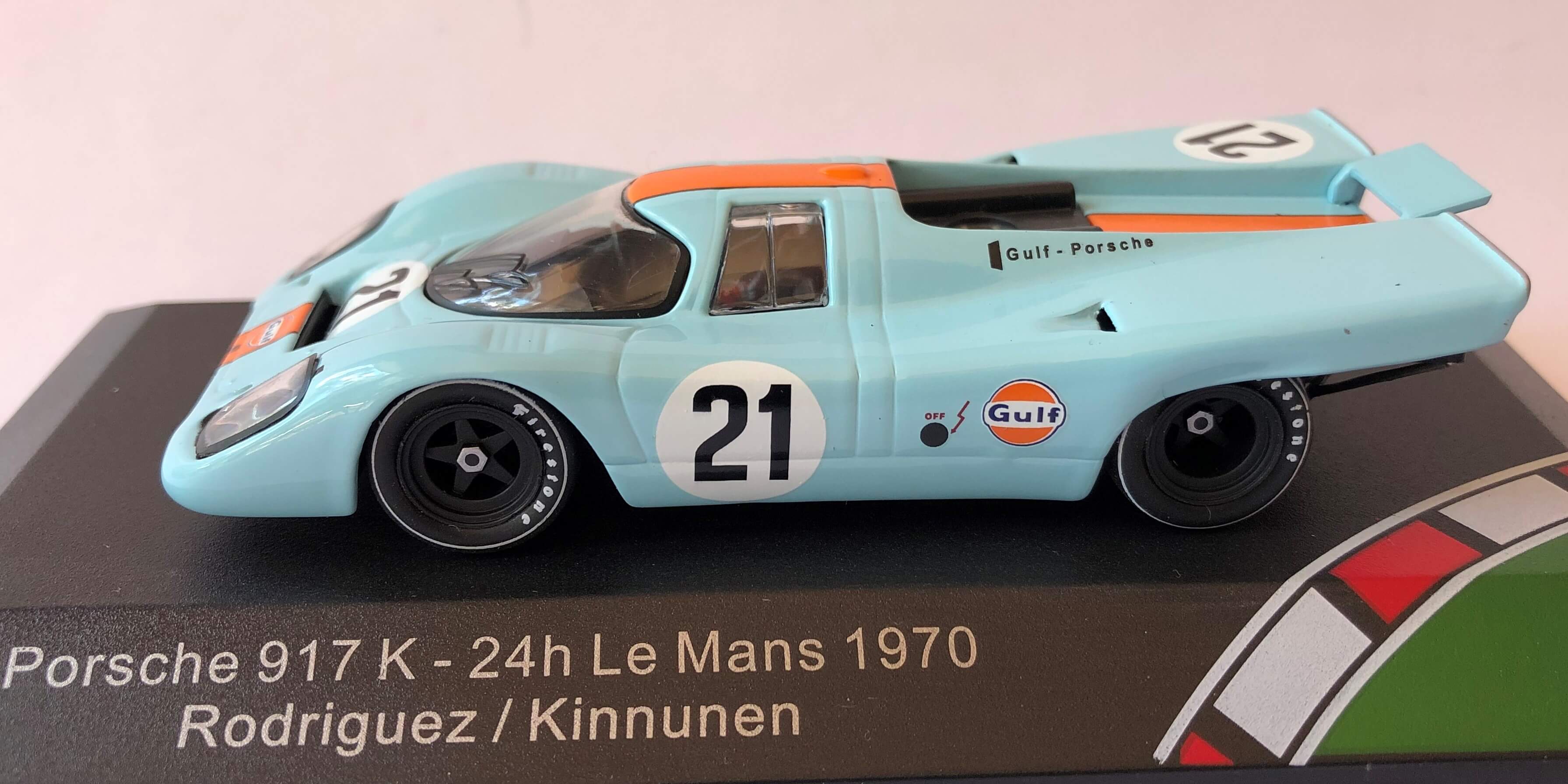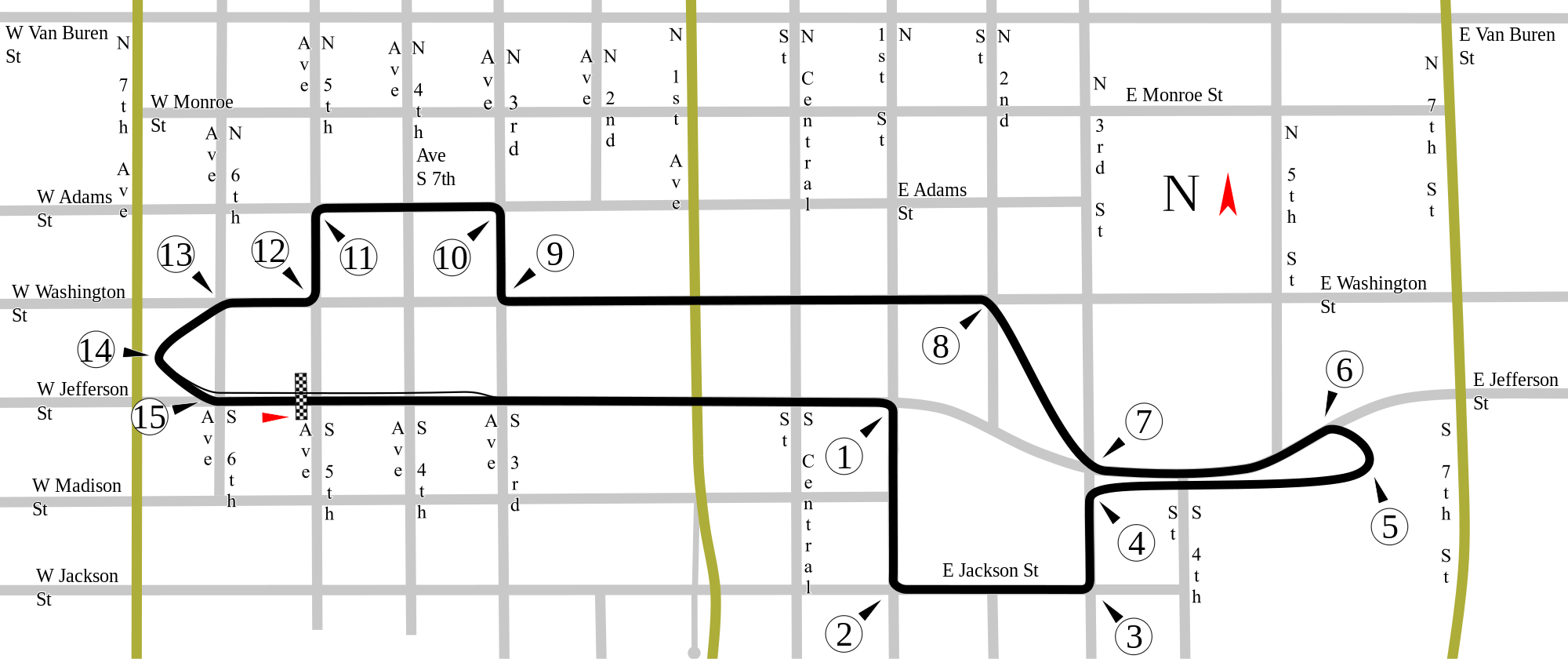www.f1scalemodels.com
... specialising in 1:43 scale model cars (Formula 1, Indy 500, Le Mans, GT and classic road cars)
New Additions: December 2019
Welcome to the final update for the year. Firstly, thank you for all your well wishes, my operation went well and I'm now in the recovery stage. Just a heads up - I may not be fully fit for the first model fair in January (Granville) so most likely February will be when I'll be back in action. I will confirm this in January. There's not a lot of new additions this month as I've been out-of-action so it's difficult to pick any outstanding models to highlight. There is one model that does deserve a mention...
The Mercedes-Benz C111 was a series of experimental cars produced in the 1960's and 70's to allow Mercedes to experiment with new engine technologies, including rotary engines, diesel engines and turbochargers. Other experimental features included gull-wing doors, fibre-glass body shells and air conditioning. After testing the first version of the C111 using a mid-mounted Wankel engine, the company decided not to adopt the Wankel due to reliability and durability issues so the C111-IID was fitted with a turbocharged diesel engine. The C111-IID set numerous world records for a diesel-powered vehicle. The styling of the C111 concept car made it a dream car of the seventies but was destined never to be put into production.
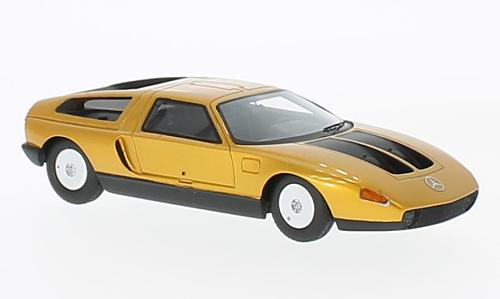 Neo: Mercedes C111-IID
Neo: Mercedes C111-IID
Last month I mentioned the Collectormania Toy and Hobby Fair would be relocating to a new venue after the last Penrith show in February 2020 and I thought the new venue was going to be in Liverpool. I was mistaken but I can confirm officially the new venue is the Hawkesbury Indoor Leisure Centre at South Windsor. There is just the one Model fair in December, the regular Friday night event on 13th December which unfortunately I will not be attending. Well that's it for another year, all the best for the festive season and I look forward to catching up with everyone in 2020. Until then, happy collecting.
Formula One / Formula E
- 2019 Alfa Romeo Ferrari C38, K.Raikkonen (7) Bahrain GP (Minichamps)
- 2019 Alfa Romeo Ferrari C38, A.Giovinazzi (99) Australian GP (Spark)
- 1982 Ferrari 126C2, G.Villeneuve (27) USA West GP split rear wing (Hot Wheels)
- 1982 Ferrari 126C2, M.Andretti(28) Italy GP (Hot Wheels)
- 1994 Ferrari 412 T1, G.Berger (28) winner German GP (Hot wheels)
- 2019 Mercedes AMG W10, L.Hamilton (44) race car (Minichamps)
- 2018/19 DS Techeetah, J.E.Vergne (25) Formula E Champion (Minichamps)
Le Mans
- 1952 Jaguar C-Type, S.Moss (50) Reims GP (Atlas)
Road Cars
- 1948 Ferrari 166M in red (Hot Wheels)
- 1951 Ferrari 212 Inter in dark red (Hot Wheels)
- 2011 Ferrari 458 Italia GT2 in red (Hot Wheels)
- 1935 Jaguar SS1 Airline in red (Atlas)
- 1957 Jaguar XK140 Roadster in light blue metallic (Atlas)
- 1960 Jaguar Mk II in dark red (Atlas)
- 1961 Jaguar E-Type Coupe in British racing green (Atlas)
- 2005 Jaguar XK Coupe in red (Atlas)
- 2012 Jaguar XFR in red (Atlas)
- 1976 Mercedes-Benz C111-IID concept car in dark metallic orange (Neo)
MotoGP Helmets (1:5)
- 1999 V.Rossi 250cc World Champion (Altaya)
- 2009 V.Rossi World Champion MotoGP (Altaya)
- 1980 K.Roberts 500cc World Champion (Altaya)
- 1998 M.Doohan World Champion MotoGP (Altaya)
- 2011 C.Stoner World Champion MotoGP (Altaya)
- 2012 J.Lorenzo World Champion MotoGP (Altaya)
- 1999 A.Creville World Champion MotoGP (Altaya)
- 2011 L.Capirossi Last Race helmet MotoGP (Altaya)
After Thoughts: "A 60-year retrospective - The 1959 F1 World Championship." Congratulations to Lewis Hamilton (again) on winning his sixth world title after another dominant year in his Mercedes. Sixty years ago the title race was rather a more intense affair, the championship being decided at the last race of the season.
Tony Vandervell, to the surprise of the motor racing world , announced that the reigning constructor's champion Vanwall would not compete in 1959, due partly by Vandervell's ill health and also to the high mortality rate of the previous season. So Cooper, with its radical rear-engined car became the leading British team to challenge the front-engined Ferrari Dino 246. The main protagonists over the nine-race season were the Works Cooper drivers, Jack Brabham and Bruce McLaren, the Ferrari drivers, Phil Hill and Tony Brooks and the privateer Walker Team Cooper drivers of Stirling Moss and Maurice Trintignant.
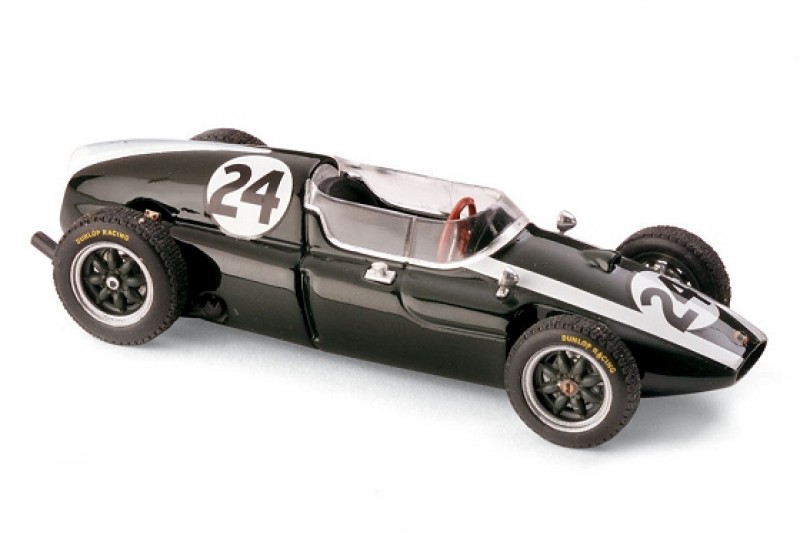 Brumm: Cooper Climax T51 1959 J.Brabham Monaco GP
Brumm: Cooper Climax T51 1959 J.Brabham Monaco GP
The first race of the season was at Monaco and Jack Brabham won his very first F1 GP with Ferriari driver, Tony Brooks coming in second. The second race was the Indianapolis 500 which was not attended by any of the Europe-based teams. Three weeks after Monaco, Jo Bonnier won the Dutch GP for BRM, the beleaguered British team finally winning a GP 9 years after it's much publicised debut. The antiquated front-engined Ferrari Dino 246's easily won the French GP with Brooks and Hill coming in first and second with Brabham, third. Unfortunately a strike in Italy meant the Ferrari team was unable to get to the British GP and Brabham took the win for Cooper. At the half-way point in the driver's championship, the points were Brabham 27, Brooks 14, Hill 9. But Brabham retired from the next two races and Brooks won one to close the points gap. At the penultimate GP at Monza, Ferrari driver, Brooks failed to finish while Brabham took third place, meanwhile, Stirling Moss driving the Rob Walker Cooper suddenly came into championship contention by winning two races in succession so at the last race the points situation was Brabham 31, Brooks 23 and Moss 25.5. (Note: One point was awarded for the fastest race lap and the half-point awarded to Moss was for sharing the fastest lap with McLaren at the British GP).
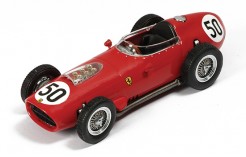 IXO: Ferrari 246 Dino 1959 Tony Brooks
IXO: Ferrari 246 Dino 1959 Tony Brooks
The last race of the year was held at Sebring, USA with Brooks and Moss both with a mathematical chance of winning the championship but nothing less than a win would be required. Moss led from the start but retired after 5 laps with a broken gearbox. The other contender, Brooks was hit from behind at the start by his team mate and pitted to examine the damage, losing two minutes. The pitstop proved to be unnecessary and despite driving a sensational race to finish third, it was not enough to deny Brabham his first World Championship. On the last lap and with just 400 yards from the finish line, Brabham's Cooper ran out of fuel while leading the race. Brabham jumped out of his car and started to push it towards the finish line which was all uphill. He was soon passed by his team mate, Bruce McLaren, then Trintignant and then by Brooks for third place. Luckily the other cars were several laps behind and an exhausted Jack Brabham was able to eventually push his car over the line to finish 4th and win the World Championship. With his maiden victory, Bruce McLaren became the youngest driver to win a GP (excluding the Indy 500) at 22 years and 104 days. Cooper also won the Constructor's Championship for the first time and clearly proved the rear-engined concept was the way of the future.
New Additions: November 2019
Welcome to the November update. I'll have to keep this one nice and short as I'm running out of time to get this out before the Collectormania Fair on 3rd November. This will be the last one ever at the Penrith Panthers Pavilion before Collectormania moves to a different venue for 2020. At this stage the new venue hasn't been confirmed but I've heard on the grapevine that it's the Whitlam Leisure Centre in Liverpool. [Correction: This will be the penultimate event at Penrith, the scheduled demolition of the pavilion has been delayed so the collectormania organiser was able to squeeze in one more event on 23 February 2020.] Following the Collectormania Fair, the monthly Granville Model Swap will be on 8th November. I will of course be at both these events.
Now some upcoming news to report. Unfortunately, I will not be able to attend the December Granville swap meet on 13th December as I'll still be recuperating from some essential surgery. So, please if there are any models you'd like for Christmas, then let me know before 8th November. Thanks, and I hope to see you at the next two events. Until then, happy collecting.
Formula One / Three
- 1969 Brabham Ford BT24, S.Moser (19) 6th US GP (Spark)
- 1976 Copersucar Ford FD04, E.Fittipaldi (30) Brazilian GP (Spark)
- 1977 Copersucar Ford FD04, E.Fittipaldi (28) 4th Brazilian GP (Spark)
- 1980 Ensign Ford N180, T.Needell (14) Belgium GP (Spark)
- 1980 Ensign Ford N180, C.Regazzoni (14) Brazilian GP (Spark)
- 1980 Ensign Ford N180, J.Lammers (14) British GP (Spark)
- 1976 Hesketh Ford 308D, G.Edwards (25) German GP (Spark)
- 1994 Ligier Renault JS39B, M.Schumacher Estoril Test (Spark)
- 1994 Ligier Renault JS39B, J.Herbert (25) European GP (Spark)
- 1995 Ligier Mugen JS41, O.Panis (26) 2nd Australian GP (Spark)
- 2001 Minardi European PS01, F.Alonso (21) F1 Debut Australian GP (Minichamps)
- 2016 Renault R.S.16, Magnussen/Palmer Winter Testing (Spark)
- 1989 Reynard Spiess F893, M.Schumacher (2) German F3 Championship (Minichamps)
- 1986 Williams Honda FW11, Rosberg riding on Piquet's car (6) German GP (Minichamps)
Australian Race Series
- 1987 BMW M3, J.Richards (3) ATCC champion with "JPS" decals applied (Apex)
- 1987 BMW M3 E30, Cecotto/Brancatelli (42) 1st WTCC/7th Bathurst 1000 (Spark)
- 2011 Audi R8 LMS GT3, Eddy/Lowndes/Luff (7A) 2nd place Bathurst 12 hour (Spark)
- 2017 Ferrari 488 GT3, Lowdnes/Whincup/Vilander (88a) 1st Bathurst 12h (Looksmart)
- 2019 Porsche 911 GT3, Dumas/Jaminet/Muller (911) DNF Bathurst 12hr (Spark)
American Race Series
- 1978 Lola T333CS, A.Jones (1) Can Am champion "First National" (Spark)
Le Mans
- 1932 Alfa Romeo 8C, Sommer/Chinetti (8) Le Mans winner (IXO)
- 1969 Austin Mini Cooper S, A.Poole (261) BTCC Champion (Atlas)
- 1975 Mirage GR8, D.Bell/J.Ickx (11) Le Mans winner "Gulf" (IXO)
- 1977 Porsche 935, H.Pescarolo/JC.Rude (cyclist) Bike Speed Attempt (Spark)
- 2018 Porsche 911 (991) GT3 R, Campbell/Muller/Arnold (30) 24hr Nurburgring (Minichamps)
- 1965 Mercedes-Benz O 317, Porsche Race Transporter (Schuco)
Road / Movie Cars
- 1969 Austin Mini Cooper S 1275 Mk1, Movie car "The Italian Job" in blue (Greenlight)
- 1969 Austin Mini Cooper S 1275 Mk1, Movie car "The Italian Job" in red (Greenlight)
- 1969 Austin Mini Cooper S 1275 Mk1, Movie car "The Italian Job" in white (Greenlight)
- 1974 BMW 520 E12 in green (Minichamps)
- 1972 BMW 2002tii in silver (IXO)
- 1936 Buick Series 40 Special in cream/brown (IXO)
- 1965 Fiat 2300 Familiare in cream/red (IXO)
- 1963 Ferrari 250 GTE 2+2 in silver (Altaya)
- 1964 Ferrari 275 GTB in yellow (Altaya)
- 1966 Ferrari 330 GTS in silver (Altaya)
- 1972 Ferrari Dino 246 GTS Spyder in yellow (Altaya)
- 1998 Ferrari 456M in metallic blue (Altaya)
- 2001 Ferrari 550 Barchetta Pininfarina in yellow (Altaya)
- 2006 Ferrari 599 GTB Fiorano in black (Altaya)
- 1975 Ford Escort in orange (Maxichamps)
- 1982 Ford Granada in beige (IXO)
- 1976 Jaguar XJ12C Coupe in green/black (IXO)
- 1998 Jaguar XJ8 (X308) in dark gray (IXO)
- 1966 Lamborghini Miura in red (Minichamps)
- 1938 Packard Convertible Victoria in blue (IXO)
- 1972 Renault Alpine A310 in blue and biege interior (IXO)
After Thoughts: "The Unheralded Drivers Series - Howden Ganley." Just continuing the series I started earlier this year focusing on drivers who may not be household names but deserve a special mention nevertheless. If Bruce McLaren, Denny Hulme and Chris Amon are the three musketeers of New Zealand motorsport, then surely Howden Ganley is the 4th musketeer. Ganley was born in 1941 in Hamilton, south of Auckland and in 1961, virtually penniless he trod the well-worn path to the UK to pursue a career as a mechanic and hopefully as an F1 driver. While working as a mechanic for a Formula Junior team, Ganley was offered a drive when he impressed the team owner during a "bedding in" track session. In his first single-seater race, Ganley finished 4th but he was soon out of a drive when the team folded through a lack of funds.
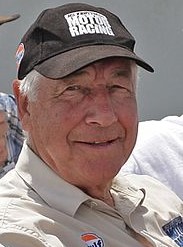 Howden Ganley 2015 (by StickboyNZ)
Howden Ganley 2015 (by StickboyNZ)
Howden's break came a few months later when Bruce McLaren decided to expand his race team and wanted to hire some fellow New Zealanders. So, in June 1964, Ganley became one of the first four employees of Bruce McLaren Motor Racing, doing everything from gopher, fabricator, mechanic and test driver. In those days, cars were built through trial and error with lots of intuition mixed in and if it worked, it was drawn up for production. So Ganley learnt everything about hands-on race car construction. Ganley helped McLaren build their first F1 car, the M2A which was used for tyre testing. The second, the M2B was towed by Ganley to Monaco on an open trailer for the McLaren marque's F1 debut.
But Howden's focus was still to be a race car driver, so he decided to leave McLaren. After earning enough money as a mechanc for other teams, he was able to acquire a 1967 Brabham BT21 to race in Formula 3. After impressing in several races, Ganley was invited back to the McLaren team in 1970 to race in Formula 5000 and some non-championship F1 races but the F1 races didn't eventuate because of Bruce McLaren's death in June that year. At the beginning of 1971, BRM tested Ganley and he was suddenly an F1 driver, the number 3 driver behind Pedro Rodriguez and Jo Siffert. Both Rodriquez and Siffert were to lose their lives before the end of the year. At the end of 1971, Howden was awarded the Von Trips Trophy for F1 rookie of the year after a 5th place in Italy and 4th at Watkins Glen for a total of 5 points.
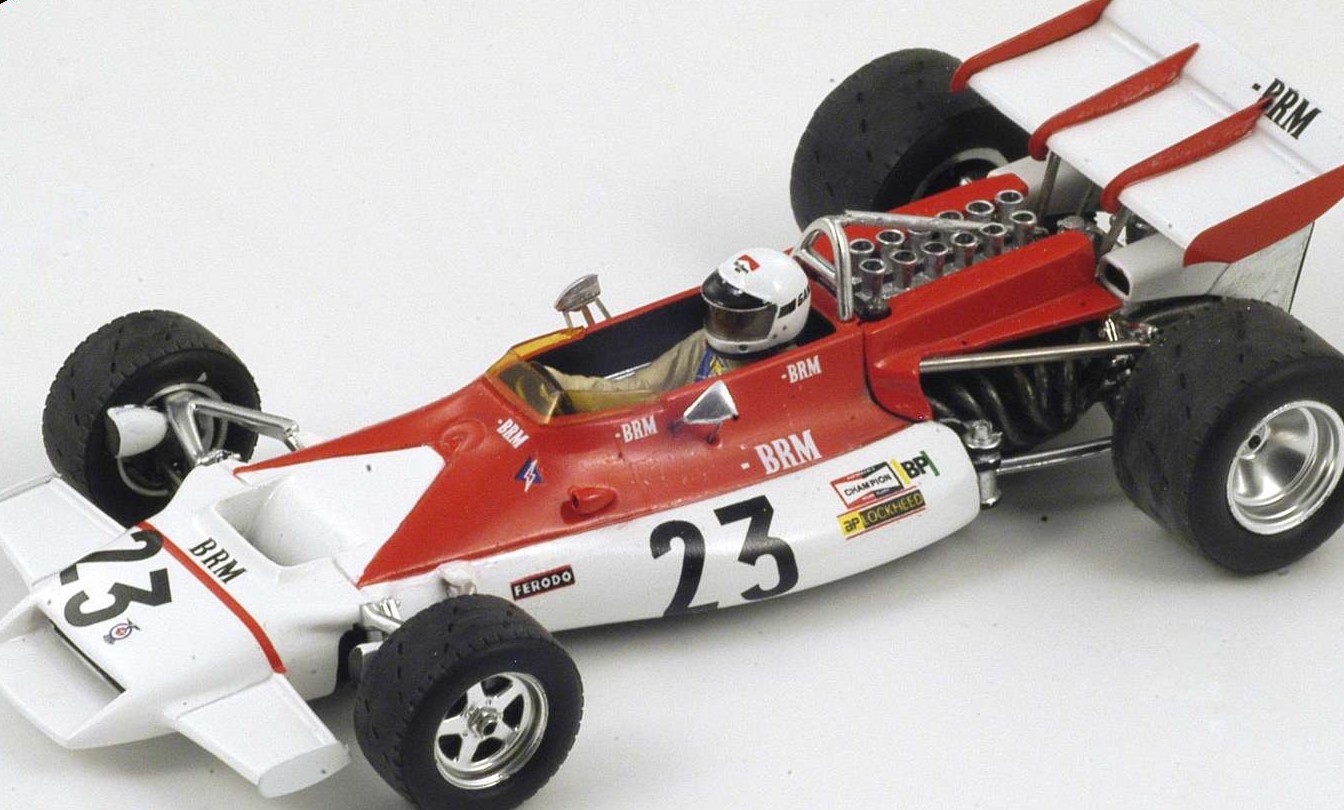 Spark: BRM P160B H.Ganley French GP 1972
Spark: BRM P160B H.Ganley French GP 1972
In 1972 Howden raced for Matra at Le Mans and he was paired with Francois Cevert in the Matra-Simca MS670 in a three-car team effort. The 24 hour race was by the Matra driven by Hill and Pescarolo while Ganley and Cevert finished in 2nd place. During the '72 F1 season, Ganley scored more points in the BRM (4th in Germany, 6th in Austria) but decided to change teams for the following year, joining Frank Williams and his Iso-Marlboro for 1973. The under-funded Williams team struggled with their car, nevertheless Howden managed a 6th place in Canada. After falling out with Frank Williams, Ganley moved to the March team for a couple of races in 1974 before being outsted by a better sponsored driver. Later that year he accepted a drive with the fledgling Japanese Maki-Ford team but was not able to qualify the car in his first two races. During his second GP with Maki, the car's suspension broke during practice and Howden suffered severe injuries to his legs and feet. Howden would never get to race in F1 again but continued racing sports cars until retiring from racing in 1978.
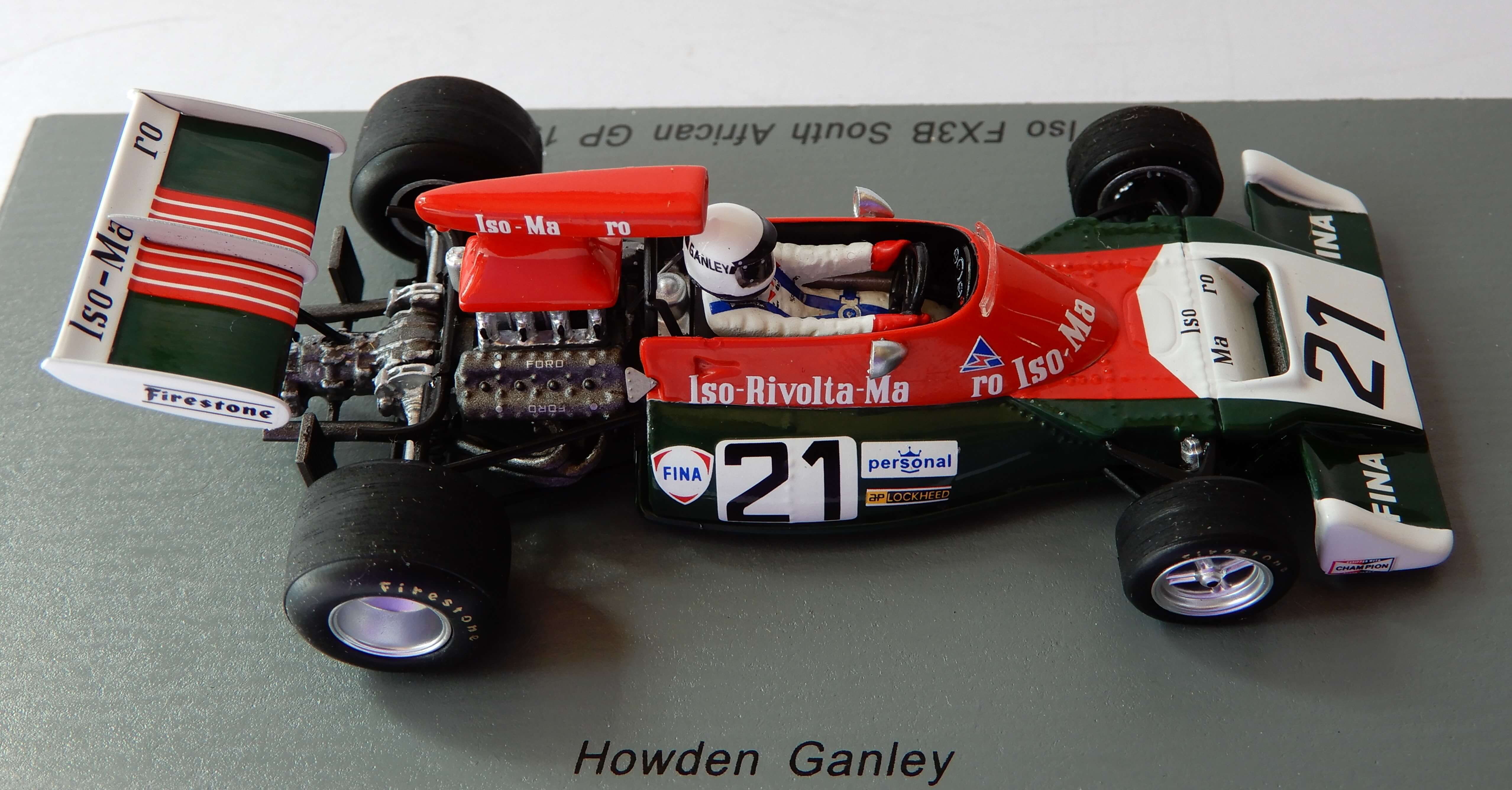 Spark: Iso-Marlboro FX3B H.Ganley 1973
Spark: Iso-Marlboro FX3B H.Ganley 1973
In 1974, Ganley and Tim Schenken teamed up to build Formula Ford cars of their own design and that was the start of Tiga cars (named by combining their names, TIm and GAnley). By 1986, the company had delivered over 400 cars for various racing categories but eventually the over-worked Ganley decided to sell up. Howden still maintains an interest in motorsports, attending historic race meetings around the world and is a regular columnist for a NZ motoring magazine.
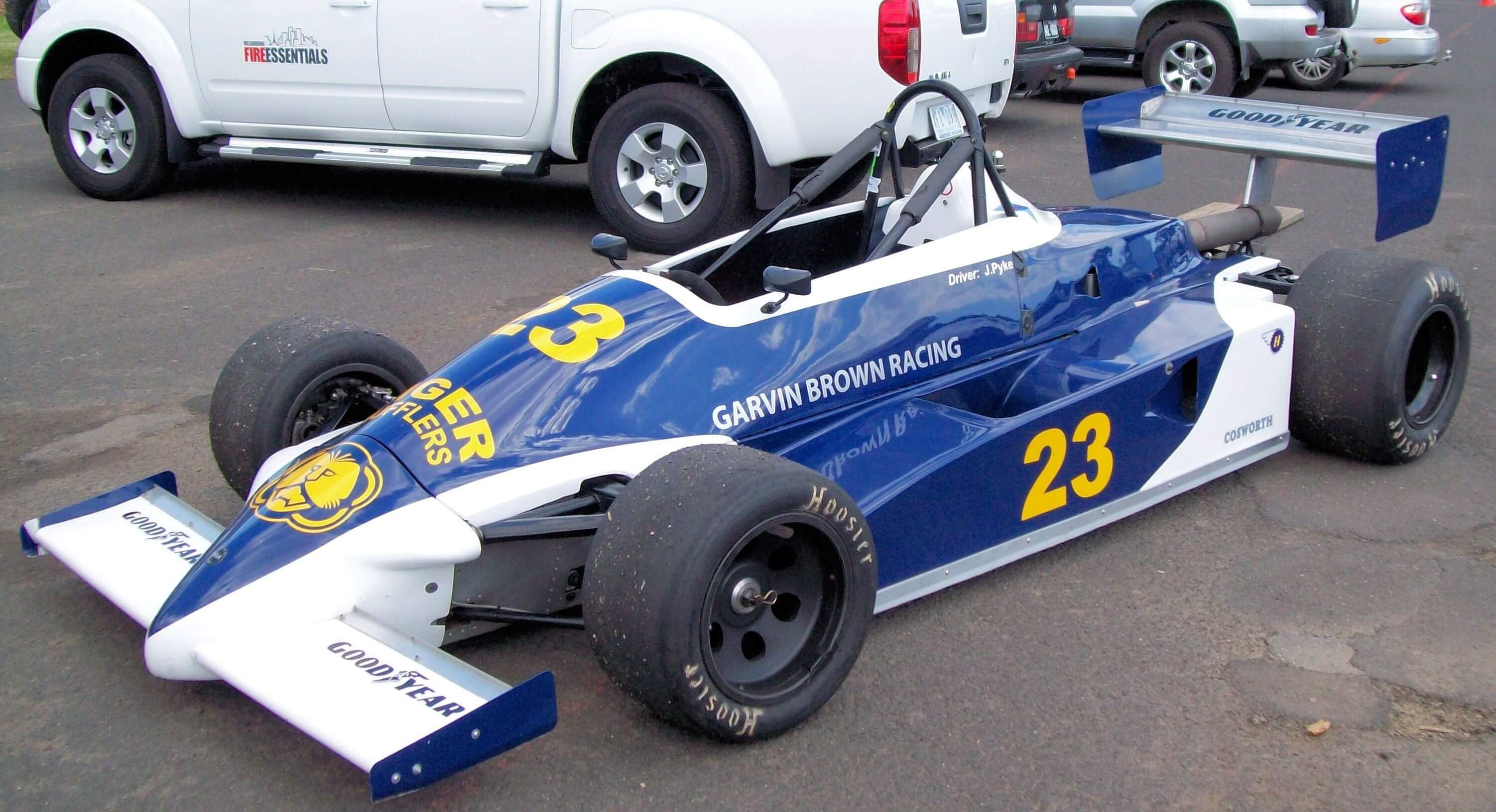 1982 Tiga FA82 Formula Pacific (by HoldenV8)
1982 Tiga FA82 Formula Pacific (by HoldenV8)
New Additions: October 2019
Welcome to another monthly update. Thank you to all those who dropped by my stand at the Model and Hobby Show at Hawkesbury last month; the weather was sunny and the displays of antique machinery outside and the racing cars inside were highly entertaining. This month sees just a few racing models delivered, the most interesting of these would be the Toyota Celica LB Turbo that raced in the German DRM series in 1977.
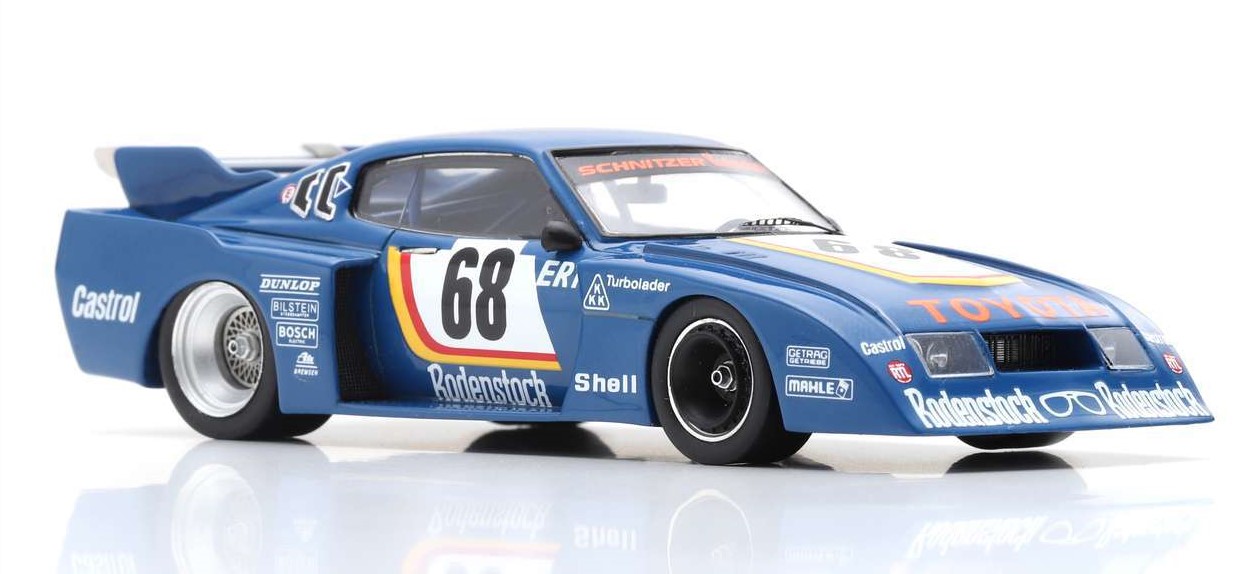 Spark: 1977 Toyota Celica LB Turbo
Spark: 1977 Toyota Celica LB Turbo
The Celica LB Turbo was a Group 5 Special Production race car version of the 3-door Celica 2000 GT and was built by Schnitzer Motorsport to compete in Division 1 of the German DRM national series, in 1977 and 78. It was plagued by reliability problems, winning only the non-championship ADAC Trophy race at Zolder in 1977. The Celica received extensive modifications to the bodywork with only the bonnet, roof and doors retained from the stock model. Throughout its competitive seasons, the Celica was the only non-German car to compete in Division 1, competing against cars such as the Porsche 934 and 935.
The most iconic car from Fiat could arguably be the one with the smallest, least powerful engine and with the smallest body; I'm referring of course, to the Fiat 500. The 500 was a rear-engined, four-seat car manufactured from 1957 to 1975. The 500cc engined car was only 2.97 metres long and proved to be an enormously practical car with large sales throughout Europe; a total of just under 4 million cars were produced. I can personally attest to its practicality having driven the modern version of the 500 around the narrow, twisty country roads of Tuscany for a week. The 500L version modelled by Maxichamps was manufactured from 1967 to 1971.
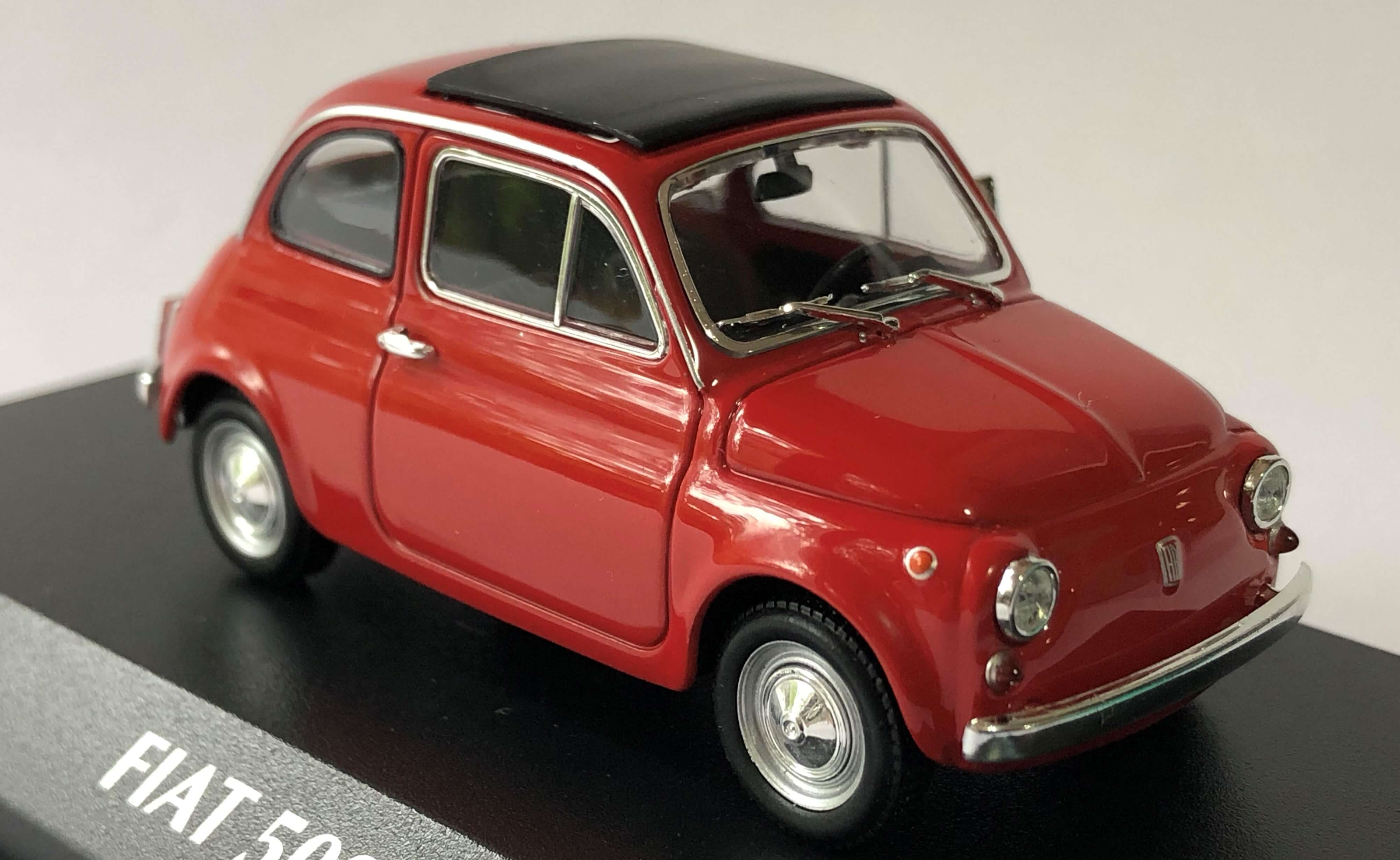 Maxichamps: Fiat 500 L
Maxichamps: Fiat 500 L
Well, that's it for another month, only three left for the year! In October, I will attending the usual 2nd Friday evening model car fair at Granville on 11th and then on 27th I'll be at the Hunter Model Auto Club swapmeet in the Hexham Bowling Club (Newcastle). Until next month, happy collecting.
Formula One
- 1963 Brabham Climax BT3, J.Brabham (22) Italian GP (Spark)
- 1960 Lotus Climax 18, J.Clark (31) Formula Junior 1st Oulton Park (Spark)
- 1968 Matra Ford MS10, J.Stewart (28) 3rd French GP (Spark)
- 1969 Matra Ford MS10, J.Stewart (7) 1st South African GP (Spark)
- 1974 McLaren Ford M23, D.Hulme (6) "Texaco" 1st Argentine GP (Spark)
- 2001 Minardi European PS01, F.Alonso (21) 10th German GP (Minichamps)
- 1982 Williams Ford FW08, K.Rosberg (6) World Champions Collection (Minichamps)
American Race Series
- 2018 Volkswagen ID R Pikes Peak Concept Car (Spark)
Le Mans / Sports car racing
- 1973 BMW 3.0 CSL, N.Lauda/B.Muir (6) 1st Monza 4 hour (Spark)
- 1968 Ford GT40, Rodriquez/Bianchi (9) Le Mans winner (IXO)
- 1969 Ford GT40 Mk I, J.Ickx/J.Oliver (6) "Gulf" LM winner (IXO)
- 1925 Lorraine-Dietrich B3-6, G.de Courcelles/Rossignol (5) LM Winner (IXO)
- 1971 Porsche 917K, Marko/Van Lennep (22) Le Mans winner (IXO)
- 1984 Porsche 956K, Bellof/Bell (2) 1st Sandown 1000km "Rothmans" (CMR)
- 1977 Toyota Celica LB Turbo, H.Ertl (68) 1st ADAC Trophy Zolder (Spark)
- 1975 Triumph Dolemite Sprint, A.Rouse (40) BTCC Champion (Atlas)
Road Cars
- 1967 Aston Martin DBS in black (Minichamps)
- 1957 Austin Healey A100/6 convertible in black/red (Spark)
- 2013 Bentley Flying Spur W12 in onyx black (Kyosho)
- 1969 Chevrolet Camaro in metallic blue/blue rims (Whitebox)
- 1970 Citroen SM in silver (Whitebox)
- 1986 Dodge Charger R/T Hardtop Coupe in white (Minichamps)
- 1965 Fiat 500 L in red (Maxichamps)
- 1962 Ferrari 250 GTO in red (Altaya)
- 1971 Ferrari 365 GTC/4 in red (Altaya)
- 1984 Ferrari Testa Rossa in red (Altaya)
- 1989 Ferrari 348 TS in silver (Altaya)
- 1999 Ferrari 360 Modena in black (Kyosho)
- 2004 Ferrari 612 Scaglietti in red (Altaya)
- 2008 Ferrari California in red (Altaya)
- 1978 Ford Mustang II King Cobra in red (Greenlight)
- 1982 Commodore VH HDT Gp3 in white (ACE Models)
- 1972 Jaguar XJ Mk I RHD in dark blue (IXO)
- 1979 Mercedes-Benz C111-IV concept car in silver
- 1992 Peugeot 205 GTi in blue (Whitebox)
- 1978 Volvo 244 in red (Triple9)
- 1987 Volvo 480 Turbo in red (Triple9)
- 1970 VW Beetle 1302 in metallic blue (Maxichamps)
After Thoughts: Robert Kubica recently announced his retirement from F1 at the end of the 2019 season after an unsuccessful year with the underperforming Williams team. It was always going to be a tough season for Kubica after a lengthy recovery from severe injuries sustained in a rally car accident but his performance compared to his younger (and rookie) team mate was not flattering. If it wasn't for a fortuitous 10th place in the German GP, Kubica would still be cemented in last place in the championship. It's safe to say that his "comeback" has been less than stellar. This got me thinking about another high-profile driver who came out of retirment to make a comeback to F1...
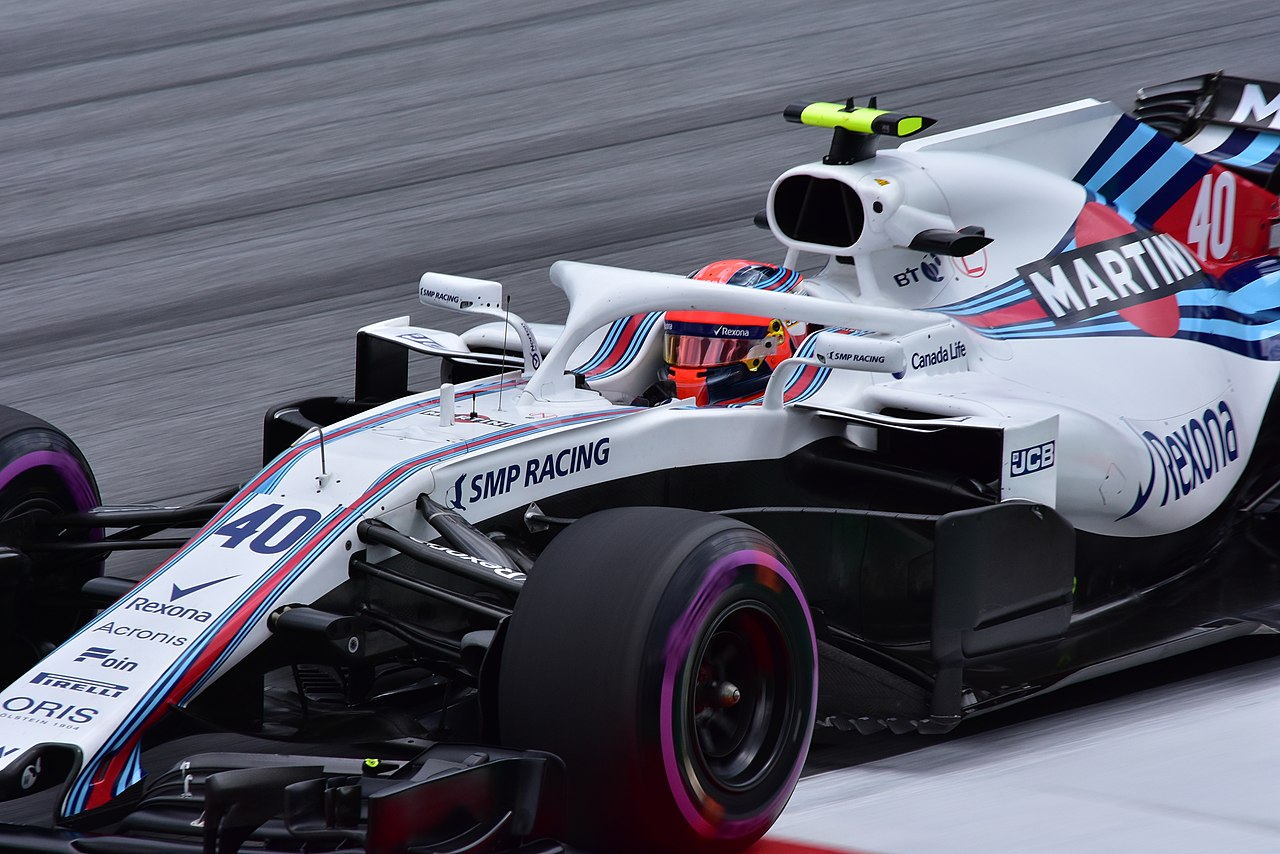 Kubica practising at 2018 Austrian GP (Flickr.com)
Kubica practising at 2018 Austrian GP (Flickr.com)
Niki Lauda had won two World Championships with Ferrari in 1975 and 1977; then he switched to the Brabham team for two fruitless seasons before telling team boss Bernie Ecclestone at the 1979 Canadian GP that he no longer wished to "drive around in circles". He walked away from the new Brabham Cosworth BT49 after just a few practice laps and leaving behind his helmet and race suit, he drove to the airport. He later said to a reporter, "I came to an end because I was bored. There was no challenge, it was only painful. The motivation was gone, very simple." Lauda had, at that time founded Lauda Air, a charter airline and he returned to Austria to run his company full-time. He focused his full attention on his airline and for the next two years he didn't hold even a passing interest in F1, attending no races nor paying attention to race results.
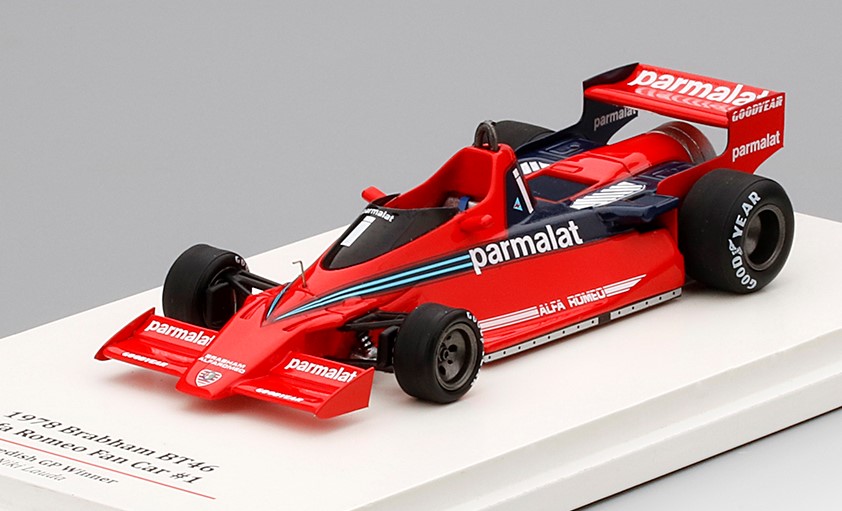 TSM: Brabham Alfa BT46B Lauda 1978
TSM: Brabham Alfa BT46B Lauda 1978
In 1981 Lauda finally accepted an invitation from a television service to act as a commentator at the Austrian GP and the racer inside him was re-awakened. McLaren's Ron Dennis had been in regular contact with Lauda during his retirement and he had made it clear that he wanted Lauda should he decide to return to F1. So, logically Lauda approached Dennis about a possible return to racing. There was much speculation that Lauda was in financial trouble with his airline and he needed the money from racing to prop up his ailing business but in his autobigraphy, To Hell and Back, he stressed that he was under no financial strain, while admitting that Lauda Air was not going well at the time. Lauda and Dennis took great pains to keep his attempted comeback a secret even testing without his wife knowing, at the Donnington circuit where Lauda discovered he was still a quick driver despite having to adapt to the new technology of a current F1 car.
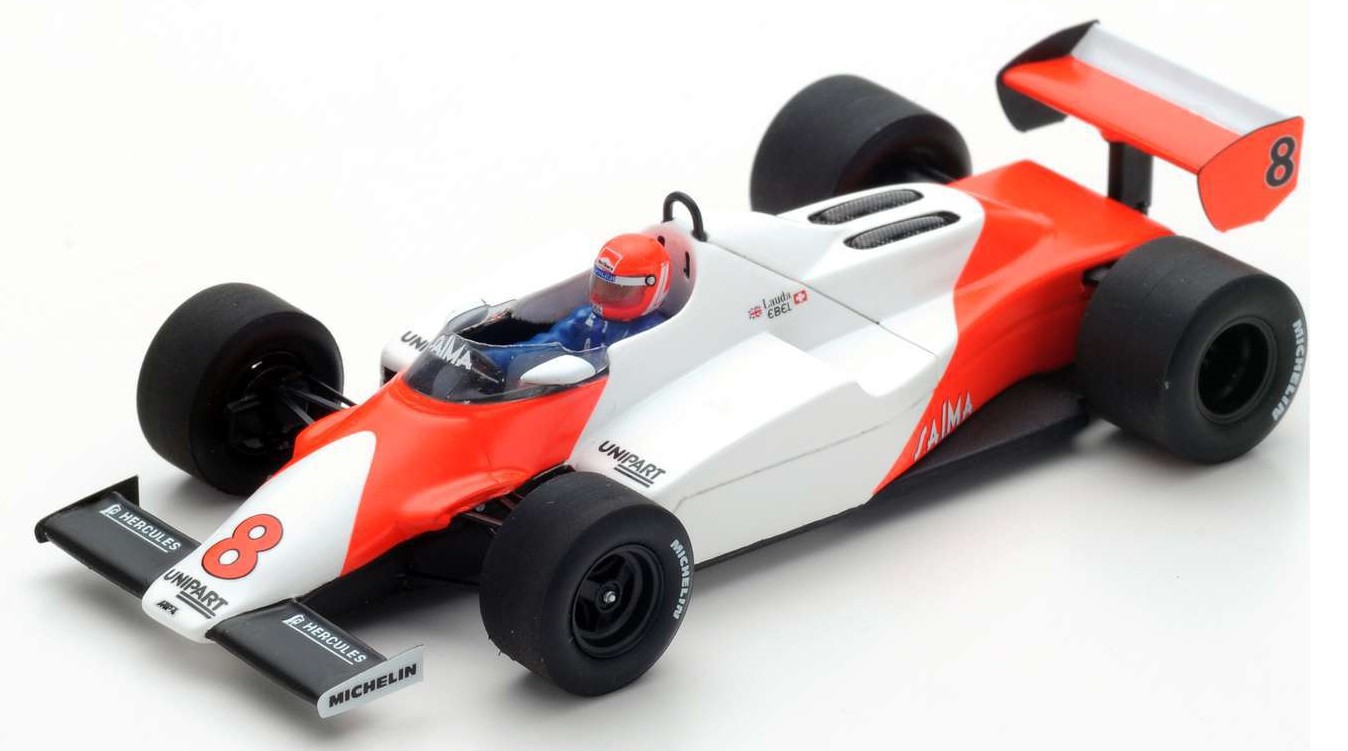 Spark:1983 McLaren MP4/1C Lauda Long Beach
Spark:1983 McLaren MP4/1C Lauda Long Beach
A deal was struck with McLaren and their sponsor, Marlboro for an unprecedented $3 million salary but with a proviso that if Lauda wasn't competitive after three races then the deal was off. In his comeback race at the Kyalami Circuit, South Africa in 1982, Lauda qualified in 13th position but worked his way up to finish 4th. He crashed his McLaren Ford MP4/1B in the next race but in his third race at the US West GP he qualified 2nd and won the race. His contract was now secure. To underline his talent, he also won the British GP that year to finish 5th in the championship after a two-year absence. The following year was one of technical transition for McLaren as they developed a new car and the new TAG 1.5L turbo engine. For the 1984 season Lauda and his new team mate, Alain Prost won 12 of the 16 races that year, with Lauda taking 5 wins and the championship by half a point from Prost and capping one of motorsport's few successful comeback stories.
[Back to Top]
New Additions: September 2019
Welcome to the September update. I got back from my holidays just in time for the Shannon's Classic on 18 August and thank you to all who popped into my garage. I've received a few models since my last update and hopefully there's something of interest to you. OK, so what are the highlights this month? It's not often you see models of open-wheeled race cars that are not F1 or Indy related so it's refreshing to see Minichamps releasing some of Gilles Villeneuve's Formula Atlantic cars from 1976. Formula Atlantic was a racing class positioned somewhere between F2 and F3 and used chassis' closely related to these 2 classes (i.e Brabham, Lotus, March and Chevron). The engines were limited to 1600 cc production-based twin-cam engines like the Cosworth Mk XIII. Villeneuve started racing Formula Atlantic in 1974 in Canada; by 1976 he was driving for a well-funded, competitive team and he was pretty much unstoppable, winning eight out of twelve races. He became both the Canadian and US Champions. It was at a non-championship race at the Trois-Rivieres street race in 1976 where guest drivers such as James Hunt, Patrick Depailler and Jaques Laffite were participating that Villeneuve really made his mark. After beating all the F1 stars, James Hunt returned to McLaren raving about this unknown Canadian who had just thrashed him in a Formula Atlantic race and McLaren signed Villeneuve as their reserve driver for 1977.
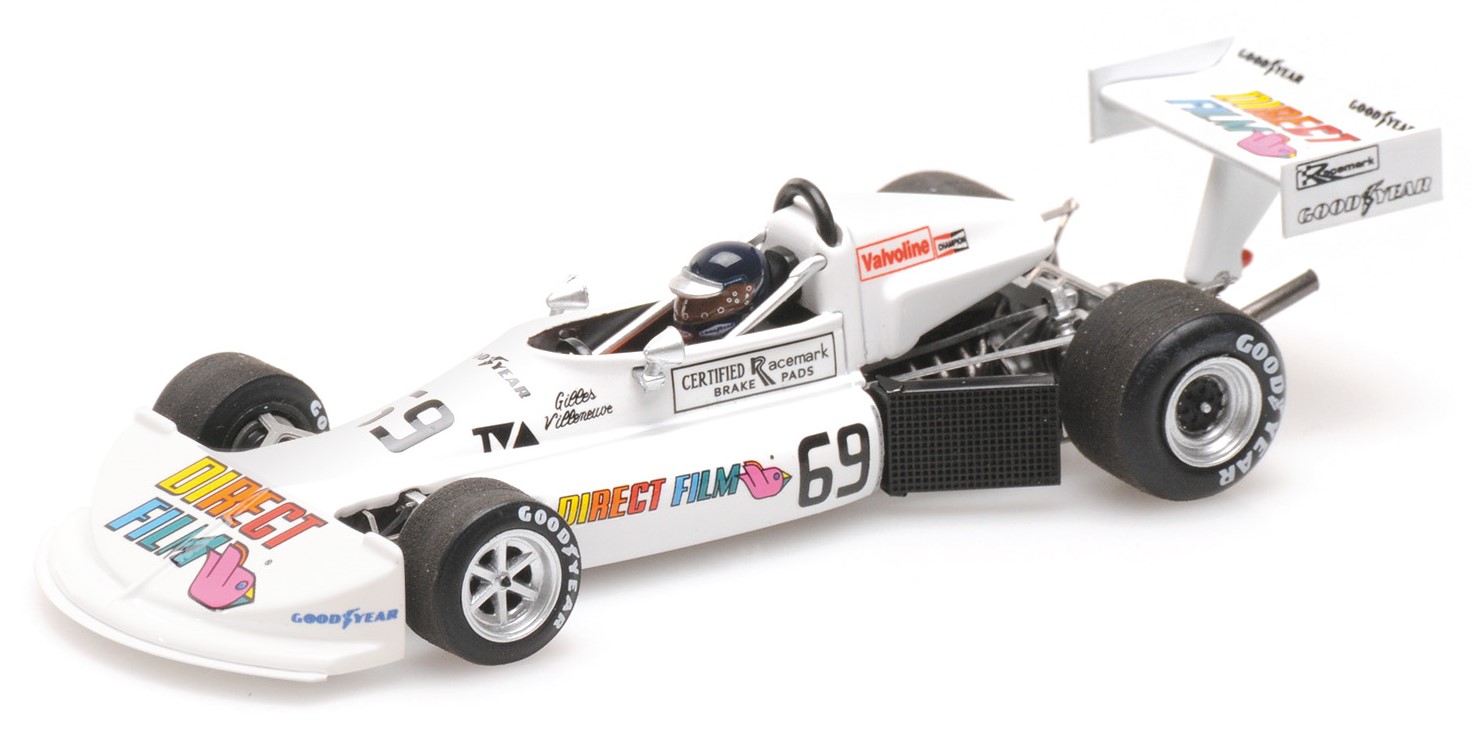 Minichamps: March Ford Formula Atlantic, 1976
Minichamps: March Ford Formula Atlantic, 1976
In 2018, Rhys Millen hustled a lightly modified Bentley Bentayga up the 156 corners of Pikes Peak in 10 minutes 49.9 seconds, a handy 1.45.71 quicker than the last Production SUV-class record, set by a Range Rover Sport in 2014. Although the twin-turbo W12 6.0-litre engine was unchanged from stock, there were some minor changes to the record-breaking car. A full roll-cage, fire-supression system and driver harness as well as a unique exhaust were added. Spark have produced this model of Millen's record-breaking car.
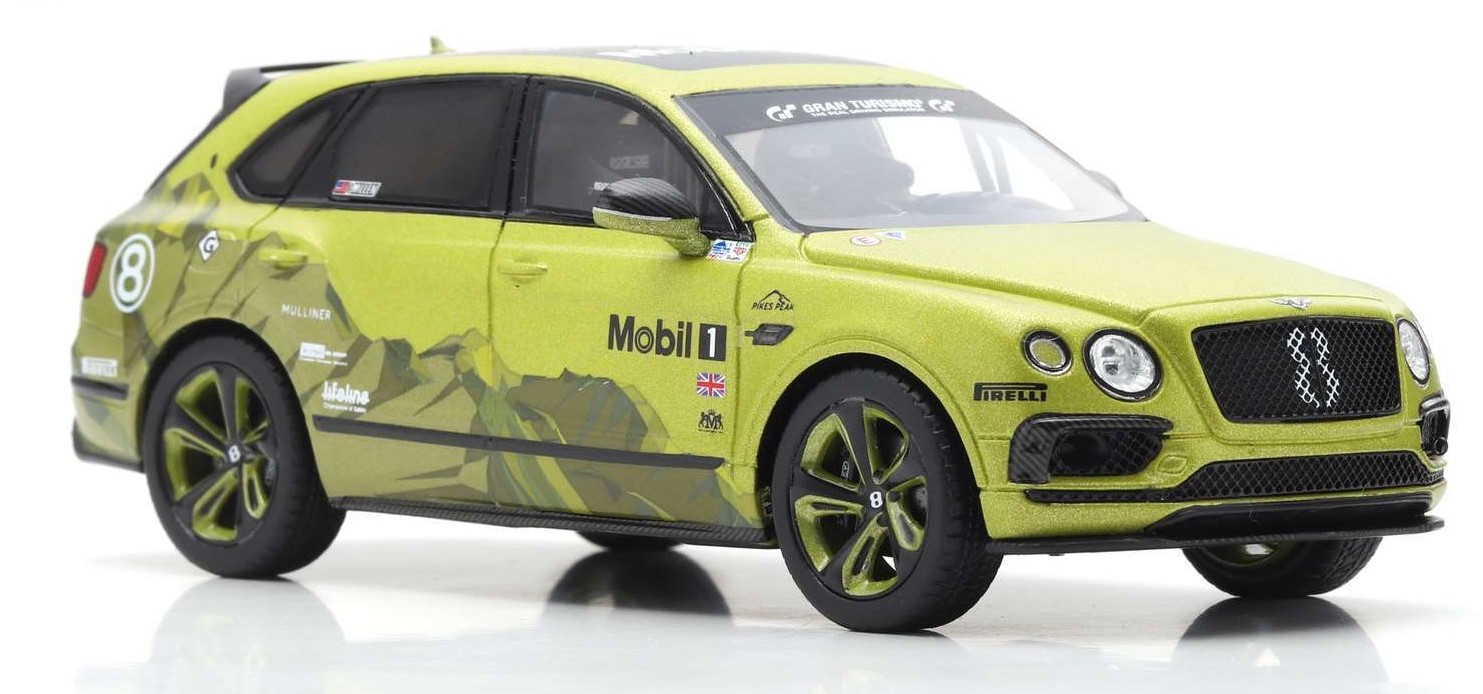 Spark: Bentley Bentayga Pikes Peak SUV record
Spark: Bentley Bentayga Pikes Peak SUV record
OK, that's it for another month. A number of model shows are scheduled for September which I'll be attending; firstly the regular monthly fair at Granville on 13 September, followed by the Collectormania event on 15th. This unfortunately clashes with the All British Day so I won't be attending the British Car show this year. Finally, there is the Hawkesbury Model and Hobby Show at Clarendon on the weekend of 21-22 September. Hope to see you sometime in this month, until then happy collecting.
Formula One
- 1987 Benetton Ford B187, T.Fabi (19) race car Ed 43 No.10 (Minichamps)
- 1962 Lotus Climax 24, N.Vaccarella (24) Italian Grand Prix (Spark)
- 1981 Lotus Ford 87, N.Mansell (12) Practice British GP (Spark)
- 1981 Lotus Ford 87, E.de Angelis (11) Monaco GP (Spark)
- 1982 Lotus Ford 91, N.Mansell (12) 3rd Brazilian Grand Prix (Spark)
- 1976 March Ford 76B, G.Villeneuve (69) 1st Formula Atlantic Motorsport (Minichamps)
- 1976 March Ford 76B, G.Villeneuve (69) 1st Formula Atlantic De Trois-Rivieres (Minichamps)
- 1969 Matra MS7, J.P.Beltoise (10) 2nd GP de Pau F2 (Spark)
- 1990 McLaren Honda MP4/5B, A.Senna (27) World Champion (Minichamps)
- 2005 Renault R25, F.Alonso (5) race car (Minichamps)
- 2006 Renault R26, F.Alonso (1) World Champ year (Minichamps)
- 1983 Toleman Hart TG183, D.Warwick (35) Dutch GP 1st champ point (Minichamps)
- 1984 Toleman Hart TG183B, A.Senna (19) GP Debut Brazilian GP (Minichamps)
- 1985 Williams Honda FW10, K.Rosberg (6) Winner Aust GP 3/11/85 (Minichamps)
- 1986 Williams Honda FW11, N.Mansell (5) race car (Minichamps)
- 1991 Williams Renault FW14, R.Patrese (6) race car (Minichamps)
- 1977 Wolf Ford WR1, J.Scheckter (20) Canadian GP winner (Minichamps)
Le Mans
- 1972 Alfa Romeo GTA 1300 Junior, Colzani/Pooky (35) Jarama (Minichamps)
- 1995 Kudzu DG-3 Mazda, Terada/Downing/Fréon (5) 'Castrol' 7th Le Mans (Spark)
- 1958 Lister Jaguar, S.Moss (29) 1st Daily Express Sports Car (Matrix)
- 1970 Porsche 917K, Rodriguez/Kinnunen (21) Le Mans "Gulf" (Brumm)
- 1985 Porsche 956, Ludwig/Barilla/Winter (7) 1st Le Mans "Newman" (CMR)
American Racing
- 1976 BMW 3.5 CSL, Gregg/Redmond (59) 1st 12 Hour Daytona (Minichamps)
- 1971 Porsche 917K, Rodriguez/Oliver (2) 1st Daytona 24h (CMR)
- 1971 Porsche 917K, Elford/Larrousse (3) 1st Sebring 12 hour (CMR)
- 2018 Bentley Bentayga, R.Millen (8) Pikes Peak (10:49.902 SUV Record) (Spark)
Road cars
- 1964 Alfa Romeo 2600 Spider in black (Minichamps)
- 1970 Alfa Romeo GTA 1300 Junior in white (Minichamps)
- 1970 Alfa Romeo Giulia, Europa Test - Hammerfest (Minichamps)
- 1972 Alfa Romeo Montreal in black (Minichamps)
- 1972 Alfa Romeo 1600 Junior Z in yellow (Minichamps)
- 1985 Alfa Romeo GTV6 in red (Whitebox)
- 1966 BMW 2000 CS in metallic blue (Whitebox)
- 1982 BMW 635 CSi (E24) in metallic grey (Minichamps)
- 1946 DeSoto 4-Door Sedan in light blue (Whitebox)
- 1982 Ford Capri III GT4 in red (Minichamps)
- 1985 Commodore VK GrpA/3 in formula blue (Biante)
- 1972 NSU Ro 80 in red (Minichamps)
- 1964 Porsche 901 in blue (Atlas)
- 1967 Porsche 911S in white (Atlas)
- 1972 Porsche 911S 2.4 in orange (Atlas)
- 1990 Porsche 911 (964) Turbo in black (Atlas)
- 1991 Porsche 911 (964) Carrera 4 in red (Atlas)
- 2010 Porsche 911 (997) Speedster in blue (Atlas)
- 2013 Porsche 911 (991), 50th Anniversary Road car in black (Atlas)
- 1988 Volvo 240 Polar in red (PremiumX)
18th Models
- 2017 Ferrari 488 GT3, Lowndes/Whincup/Vilander (88A) 1st 12h Bathurst (Looksmart)
- 1970 Porsche 917K, Siffert/Redman (20) Le Mans "Gulf" (CMR)
- 1965 Shelby Cobra Daytona Coupe, Schlesser/Grant (12) Le Mans (CMR)
- 1967 Brabham Repco BT20, D.Hulme (9) 1st Monaco Grand Prix (Spark)
After Thoughts: This year marks the 50th anniversary of the race debut of the Porsche 917 on 11 May 1969 at the 1000km race at Spa. The story of the iconic 917 goes back to 1967 when the Commission Sportive Internationale (CSI), the independent competition arm of the FIA decided to reduce the unlimited engine capacity of the Group 6 prototypes (eg. Ford GT Mk.IV) for the 1968 Championship down to just 3-litres. Later, after realising few manufacturers had cars ready, the CSI allowed the participation of 5-litre Group 4 sports cars and Porsche made a surprising and expensive effort to take advantage of this regulation change. In only ten months the Porsche 917 was developed, based on the Porsche 908. The 917 was powered by a new 4.5-litre flat-12 cylinder engine with a large horizontally mounted cooling fan, that produced 520 bhp.
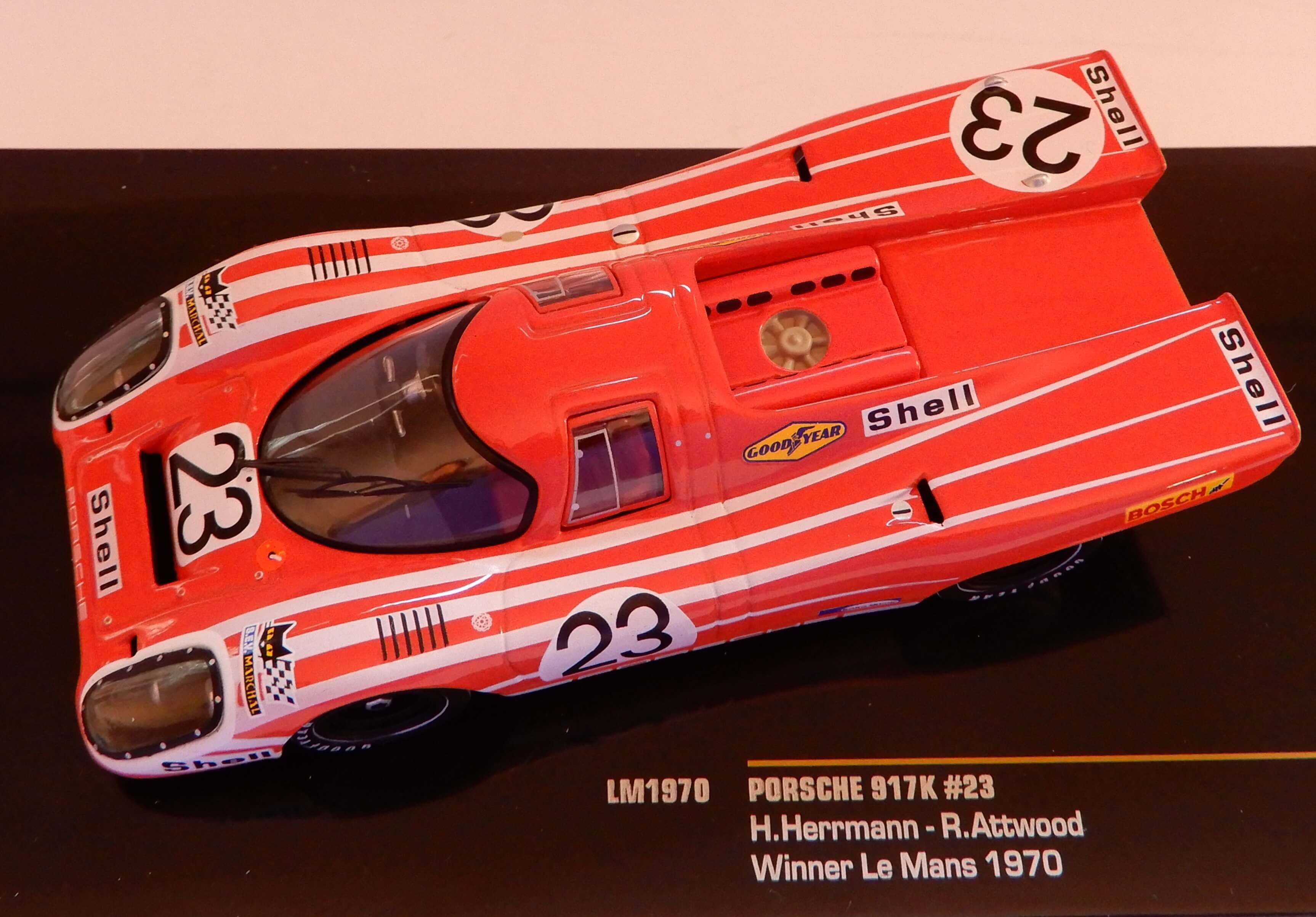 IXO: Porsche 917 1st Le Mans 1970
IXO: Porsche 917 1st Le Mans 1970
Early testing in 1969 revealed the 917 did not work well on the race track, being incredibly unstable at high speed. Modifications to the suspension and frame did not improve the situation; it was finally determined that the "long tail" body was generating significant lift on the straights as the 917 was 30 kph faster than anything previously built for Le Mans. The significance of downforce for sports car racing was not yet fully understood athough F1 cars were beginning to experiment with high-position wings. By the time of its competition debut at Spa further testing of the aero changes hadn't been completed. Jo Siffert and Brian Redman practiced the 917 at Spa clocking an unofficial time that would have secured pole position but decided the 917 was insufficiently sorted so they raced the 908 to victory instead. Three weeks later at Nurburgring, all the works drivers again opted for the 908, so Porsche hired David Piper and Aussie Frank Gardner to drive the 917 where they finished in 8th place.
At the 1969 Le Mans race, the 917 showed its pace, claiming 1st and 2nd on the grid. The two works cars were joined by the privateer entry of John Woolfe. Woolfe, a "gentleman-driver" unfortunately crashed his 917 on the first lap and was killed. As a result of Woolfe's death the traditional Le Mans start, with drivers standing opposite their cars before running to them when the race started, was dropped the following year. In the scramble to start many drivers did not fasten their seat belts and Woolfe was one of them. He was thrown out of the cockpit when he crashed heavily into the barrier. One of the works 917 led early but dropped out with an oil leak; the second car broke its gearbox at hour 21 while comfortably leading by 50 miles.
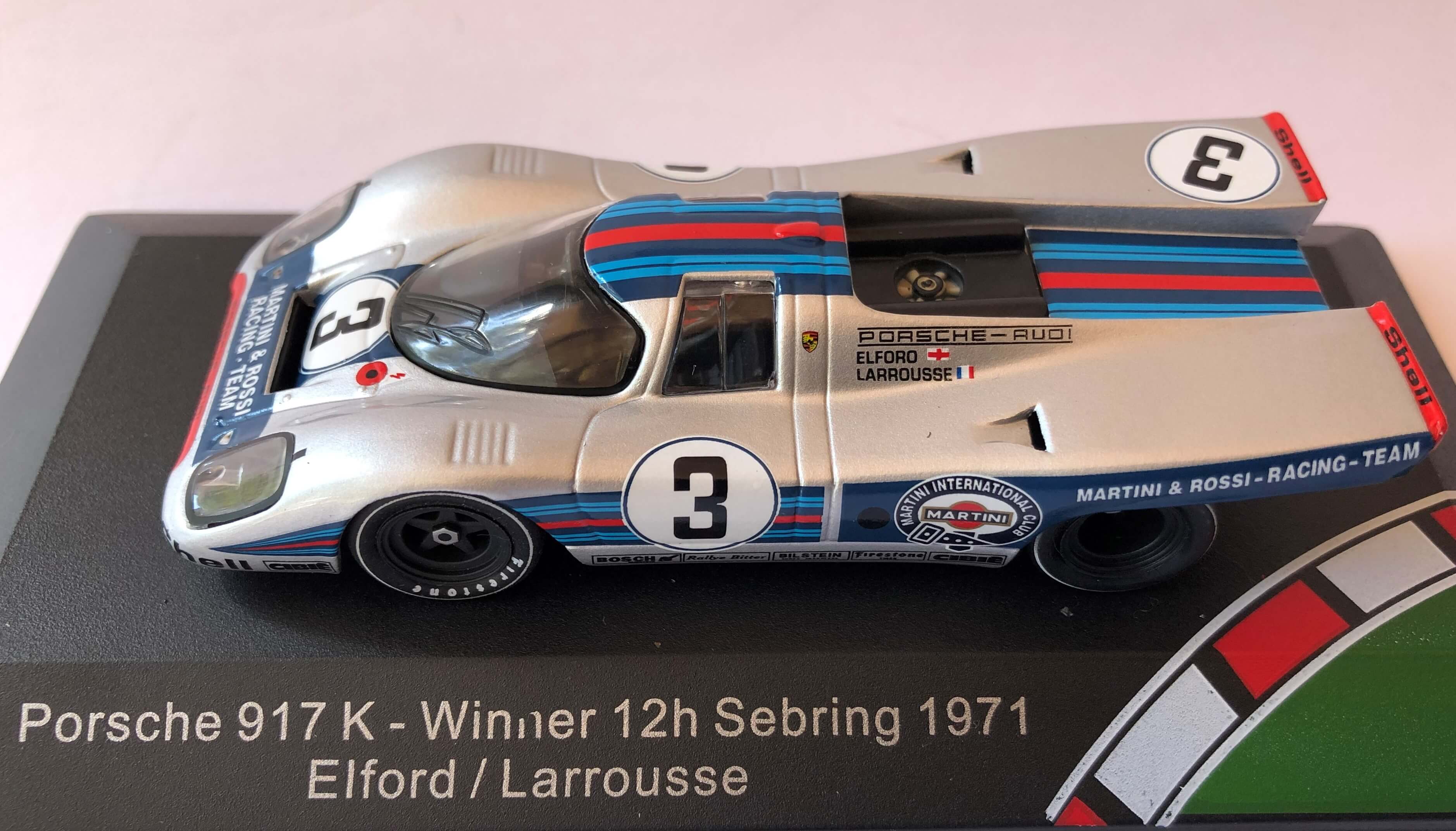 CMR: Porsche 917 1st Sebring 1971
CMR: Porsche 917 1st Sebring 1971
At the last race of the 1969 season, the Porsche 917 finally scored its first win at the 1000km Zeltweg race. Jo Siffert and Kurt Ahrens won in a privately entered 917. At this stage, the factory had withdrawn its works team to focus on development, leaving the racing to privately entered 917's. For 1970 Porsche entered into an agreement with John Wyer and his Gulf team to become the official development partner. During testing, Wyer's chief engineer noticed the bodywork had a pattern of dead gnats dashed against it, revealing the airflow. The tail was clean, the lack of dead gnats indicating the air was not flowing over the tail. A modification to the tail was cobbled up and this new short tail gave the 917 much needed downforce. This new version was called 917K (Kurzheck or short tail). For the 1970 Le Mans race another version had been developed, the 917LH (Langheck) but it was the 917K version that achieved Porsche's first outright win at the 24 hour race. The 917 went on to attain its legendary status as an enduring champion.
New Additions: July 2019
Welcome to the update for July. Firstly, have you seen the trailer of the movie "Ford vs Ferrari" due to be released in November? It's the story of the development of Ford's GT40 to take on Ferrari at Le Mans in the mid 1960's and stars Matt Damon and Christian Bale. It'll be a must-see for me and I'll probably buy the DVD as well. But doesn't it seem that Hollywood has a fixation with beating up poor old Ferrari? I mean, "Ford vs Ferrari" is all about beating Ferrari at Le Mans who had won 6 times in succession from 1960. Then there was Ron Howard's film, "Rush", obstensibly about the rivalry between Hunt and Lauda but with a sub-story of McLaren beating ... Ferrari. And Steve McQueen's movie "Le Mans" where McQueen climbs out of his Porsche 917 and gives the two-finger salute to ... Ferrari. Don't get me wrong, I loved all these movies (and I have the DVD's).
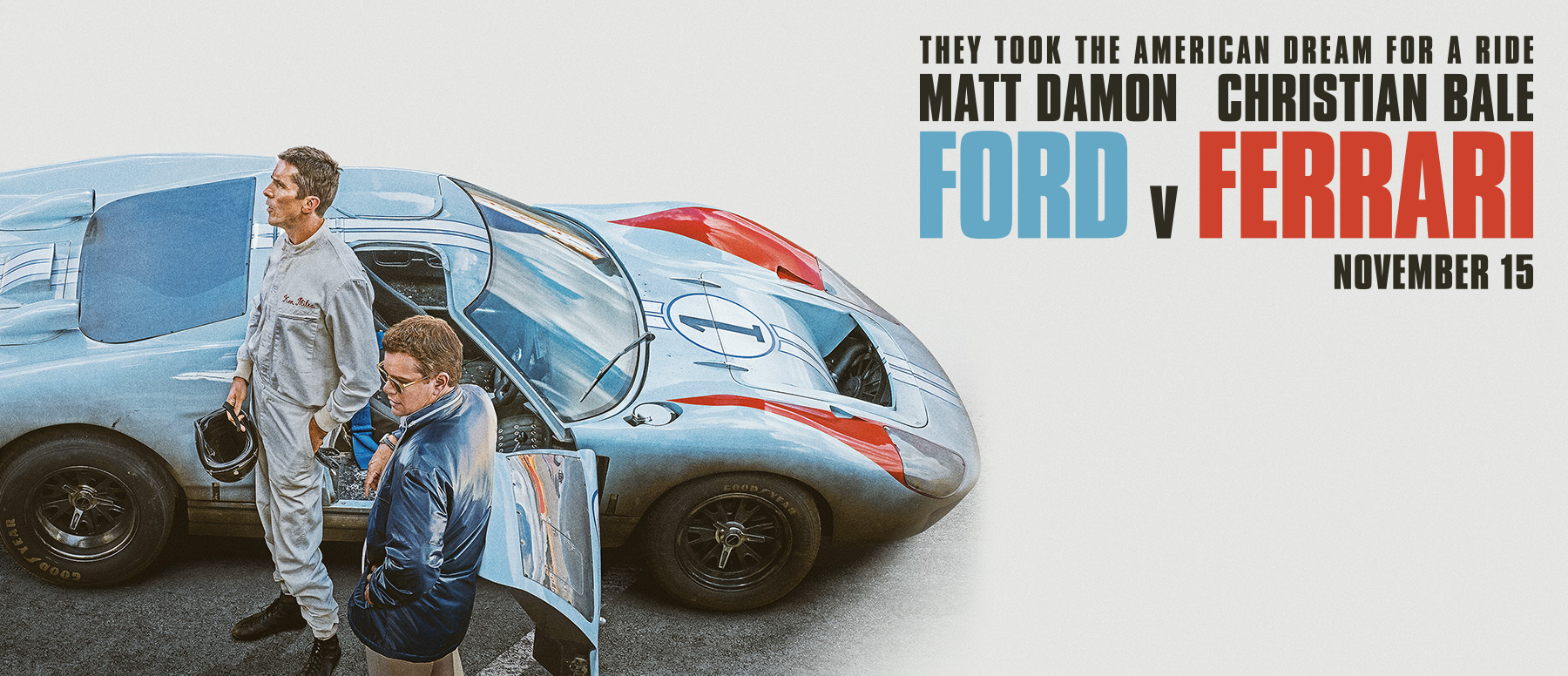 Ford vs Ferrari Movie Poster
Ford vs Ferrari Movie Poster
Anyway, back to the models ... a few new and restocked models this month. My standout models? The Brabham BMW BT55 was designed by Gordon Murray for the 1986 F1 championship. Murray decided a radical approach was needed with this car as the rear wing was now the main aerodynamic element after ground-effects had been banned a few years earlier. Murray's approach was to streamline the bodywork to allow undisturbed air to flow over the rear wing but the tall, upright BMW 4-cylinder turbo engine needed to be "laid" down almost horizontally. BMW redesigned the engine and gearbox to accommodate Murray's low-line design and the driver also had to assume a laying down posture which was rare in the 1980's. The aerodynamic concept worked in that the car produced plenty of downforce without increasing drag which allowed the car to run less wing; the problem was the tilted over engine. It suffered incurable oil surge and poor throttle response which compounded the already severe turbo lag so its acceleration out of slow corners was abysmal. Througout the 1986 season the car only scored 2 points and it was seen as unsuccessful. Murray left Brabham the following year to join McLaren. Spark have produced the BT55 from the 1986 Monaco GP for Patrese and de Angelis.
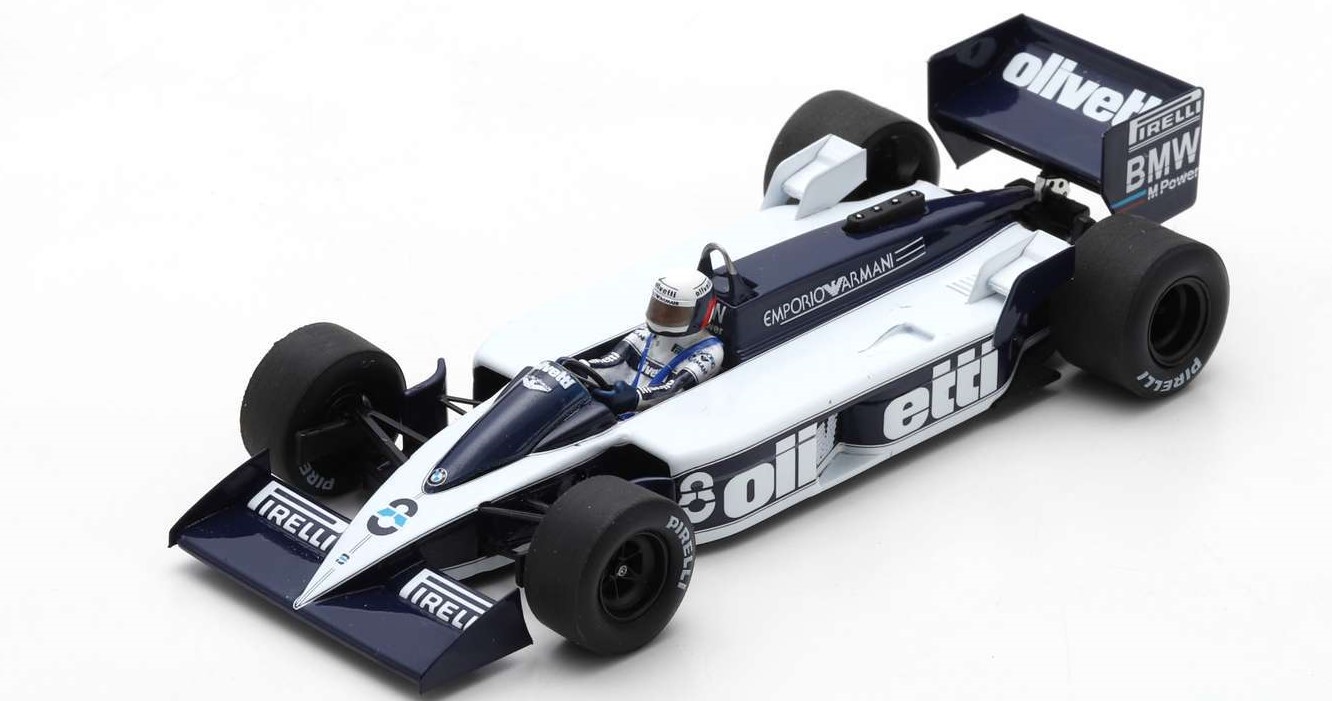 Spark: 1986 Brabham BMW BT55
Spark: 1986 Brabham BMW BT55
"The Lamborghini Veneno Roadster takes the aerodynamic effiiciency of a racing prototype onto everyday roads. This super sports car is characterized by optimal aerodynamics in order to guarantee stability in fast curves and a behaviour like a racing prototype. All of this on a car devised for the road. The perfect car for sports-driving lovers" ... and so say the Lamborghini marketing department when introducing the Veneno Roadster. The Veneno coupe, produced from 2013-14 was based on the Aventador and was developed to celebrate Lamborghini's 50th anniversary. Powered by a 6.5 litre V12 engine producing 552 kW (740 hp), the design was inspired by LMP1 (Le Mans Prototype 1) cars and has a top speed of 356 km/h. The roadster version was released in 2014 with a price tag of 3,300,000 Euros (about $5.6 million Aussie) and only 9 roadsters and 5 coupes were produced. The Kyosho model of the roadster reproduces the sharp, aerodynamic lines of this rare and expensive car exceptionally well.
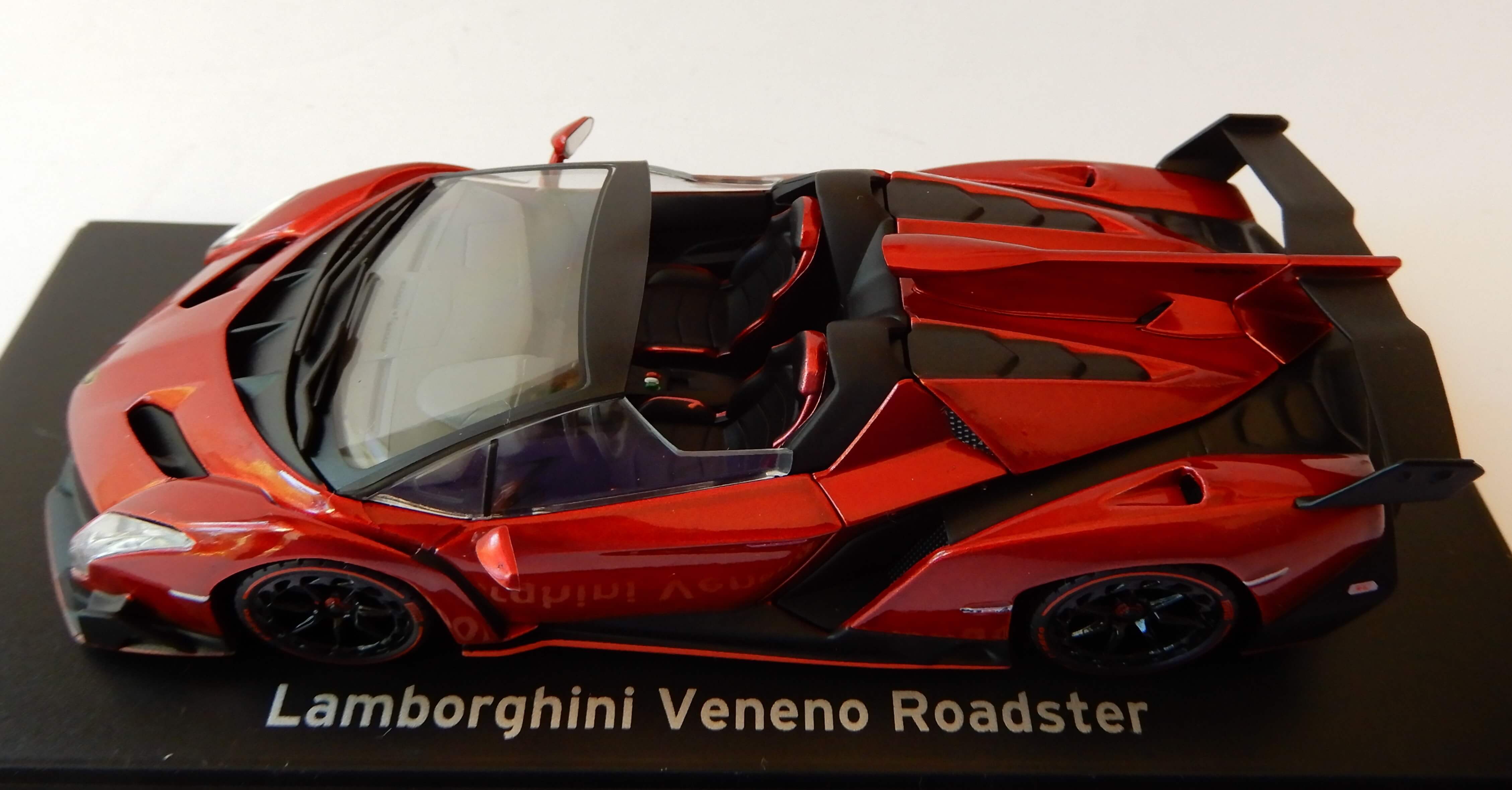 Kyosho: Lamborghini Veneno Roadster
Kyosho: Lamborghini Veneno Roadster
OK, that's it for another month but before wrapping it up a bit of personal news, I will be on holidays next month so I won't be able to do an August update. Also, I will not be able to attend the Granville model fair on 9 August but I will be attending the Shannon's Eastern Creek Classic on 18 August so come and see me in garage 19. In July I will be attending Granville on 12 July and the Collectormania Fair on 14 July. Until next time, happy collecting.
Formula One
- 1970 Brabham Ford BT33, J.Brabham (5) 2nd Monaco GP (Spark)
- 1986 Brabham BMW BT55, R.Patrese (7) Monaco GP "Olivetti" (Spark)
- 1986 Brabham BMW BT55, E.de Angelis (8) Monaco GP "Olivetti" (Spark)
- 1960 Cooper Climax T53, J.Brabham (2) Winner Belgium GP w/ engine cover (Biante)
- 1960 Cooper Climax T53, J.Brabham (1) Winner British GP w/ engine cover (Biante)
- 1974 Ferrari 312B3, N.Lauda (12) 50th Ferrari GP win, Spainish GP (Hotwheels)
- 2018 Ferrari SF71H, S.Vettel (5) 1st Canadian GP 50th GP win (Looksmart)
- 1981 Lotus Ford 87, E.de Angelis (11) Italian GP (Spark)
- 2018 McLaren Renault MCL33, F.Alonso (14) Last Race Abu Dhabi (Minichamps)
- 1982 Ralt Toyota RT3, Senna (2) Thruxton 1st F3 win "Banerj" (Minichamps)
- 1977 Shadow Ford DN8, J.Oliver (16) Race of Champions (Spark)
Le Mans / BTCC / Rally
- 2017 Alpine Gibson 470 LMP2, Dumas/Menezes/Rao (36) 10th Le Mans (Spark)
- 2015 Aston Martin V8 Vantage, Goethe/Hall/Castellacci (96) LMGTE-Am Le Mans (Spark)
- 2015 Aston Martin V8 Vantage, Dall Lana/Lamy/Lauda (98) LMGTE-Am Le Mans (Spark)
- 1969 Ford GT40 Mk I, J.Ickx/J.Oliver (6) "Gulf" LM winner (IXO)
- 1965 Ford Mustang, R.Pierpoint (42) BTCC Champion (Atlas)
- 1959 Ford Zephyr Six, J.Uren (139) BTCC Champion (Atlas)
- 1970 Porsche 917K, Siffert/Redman (20) Le Mans "Gulf" (CMR)
- 1970 Porsche 917K, Rodriguez/Kinnunen (21) Le Mans "Gulf" (CMR)
- 1970 Porsche 917K, Hobbs/Hailwood (22) Le Mans "Gulf" (CMR)
- 2009 Porsche 997 GT3 RSR, Lecourt/Felbermayer/Felbermayr (70) Le Mans (Spark)
- 2011 Porsche 997 GT3 RSR, Tandy/Al Faisal/Miller (88) Le Mans "Felbermayr" (Spark)
- 2012 Porsche 997 GT3 RSR, Lieb/Lietz/Henzler (77) Le Mans "Felbermayr" (Spark)
- 1972 Sunbeam Imp, B.McGovern (1) BTCC Champion (Atlas)
- 1975 Triumph Dolemite Sprint, A.Rouse (40) BTCC Champion (Atlas)
- 1935 Jaguar SS1 Airline Coupe, S.Light (99) Monte Carlo Rally (IXO)
Road Cars / Movie Cars
- 1966 Batmobile, 1966 TV series (Hotwheels)
- 1970 BMW 2000 CS in beige (IXO)
- 2013 BMW 4 Series Gran Coupe in blue (Kyosho)
- 1936 Cadillac V16 Convertible Sedan in black (TSM)
- 1959 Cadillac Professional chassis, GhostBusters ECTO-1 (Hotwheels)
- 1959 Cadillac Professional chassis, GhostBusters ECTO-1A Ghostbusters II (Hotwheels)
- 1999 Ferrari 360 Modena in red (Altaya)
- 2008 Ferrari California in light blue (Altaya)
- 1935 Jaguar SS1 Airline Coupe in black (IXO)
- 1957 Jaguar Mk 1 in green (IXO)
- 1982 Jaguar XJ-S in red (Whitebox)
- 2014 Lamborghini Veneno roadster in red (Kyosho)
- 1967 Renault 8 Gordini 1300 in blue (IXO)
- 1979 Rolls Royce Silver Shadow "Krug" Delivery truck (TSM)
After Thoughts: "F1 GP Circuit Musical Chairs" The 2020 F1 calendar hasn't been officially confirmed yet but it's understood that two "new" circuits will appear on the schedule as their contracts have already been signed. Of the 21 races being held this year only 17 events are known to have contracts for 2020 which leaves 4 circuits currenlty without contracts. These 4 Grand Prix are the British, German, Mexican and Spanish. Assuming the 2020 calendar will again have 21 races, then 2 of these 4 non-contracted events will miss out. Which two I wonder, when the music stops?
Of the two new circuits added to next year's schedule, one is brand new, the Vietnamese GP on the streets of Hanoi and a returning GP, the Dutch GP at Zandvoort. The commercial rights owner of F1, Liberty Media had plans to include "destination races" into the F1 calendar. These destination races were to be held in or near tourist destinations and integrate racing, entertainment and social functions with the aim of making the sport more accessible and appealing to a wider audience. A current example is the Singapore GP and now Hanoi joins as another destination race. The Hanoi track, designed by Hermann Tilke, will be 5.57km long and features 22 corners, some of them borrowing heavily from iconic tracks like Suzuka, Monaco and the Nurburgring. It looks like a very challenging circuit boasting one of the longest straights in the sport at 1.5km.
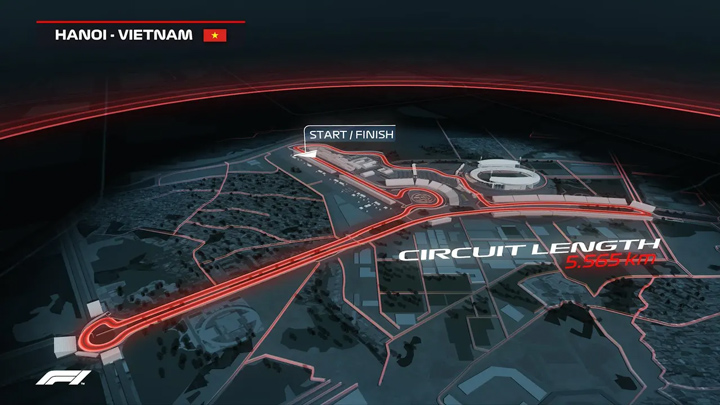 New Hanoi Circuit for 2020
New Hanoi Circuit for 2020
On the other hand, the returning Dutch GP held at Zandvoort, is a classic GP race which had been part of the F1 World Championship from 1952 to 1985. It's return to the F1 fold makes good sense as Max Verstappen is riding a wave of popularity as evidenced by the sea of orange-clad fans at every European race. Set in sand dunes a hundred metres inland from the North Sea, the 4.2km track was designed by the Royal Dutch Motorcycle Association and opened in 1948. However, the initial work for the track was credited to the Mayor of Zandvoort who saw the potential for racing to transform the fortunes of the town. The outbreak of World War 2 brought a halt to his aspirations, nevertheless, the mayor continued to quietly pursue his ambition, telling the occupying Germans he would like to hold a parade for the winners of the war, for which they built a new road. Little did the Germans realise this was a ruse to avoid locals being sent to Germany as slave labourers. Instead, the road they crafted would eventually form the main straight of the new circuit.
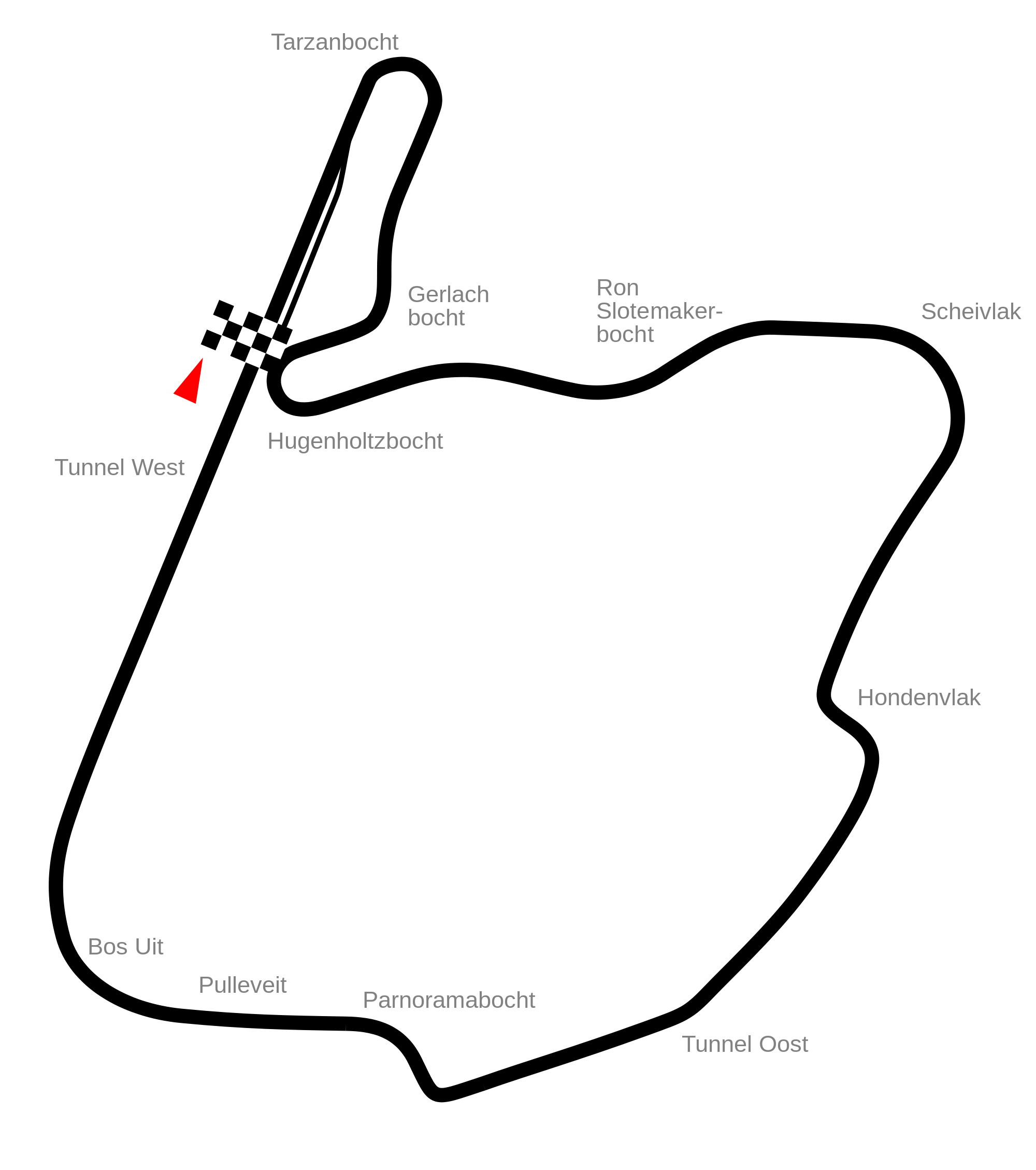 Zandvoort Circuit circa 1980 (Pitlane02)
Zandvoort Circuit circa 1980 (Pitlane02)
The first race, in 1948 was won by Prince Bira of Thailand in a Maserati. In 1952 Zandvoort joined the F1 Championship and Alberto Ascari won this and the following year's race in his Ferrari 500. In fact the list of Dutch Grand Prix winners reads like a "Who's Who" of racing greats; Ascari, Fangio, Moss, Brabham, von Trips, Hill, Clark, Stewart, Hunt, Lauda, Jones, Andretti, Piquet and Prost. But arguably the most celebrated race win was by a driver who won his first and only GP at Zandvoort in 1959. From its conception in 1945, British Racing Motors (BRM) held the hopes of British racing fans but year after year the BRM failed to deliver; their cars were fast, noisy and dangerous to drive but unreliable. The private backers of BRM dwindled to nothing and was eventually taken over by the Owen Organisation. Up to the time of the 1959 Dutch GP, the BRM had never won an important race and had only come close once, coming 2nd and 3rd at Zandvoort in 1958. For the 1959 race there were two BRM's, driven by American Harry Schell and Joakim Bonnier from Sweden. Schell's car was an early retirement but Bonnier was able to hang on to the leading cars and slipped into lead momentarily until Jack Brabham's Cooper stormed past. Hanging on grimly, Bonnier was able to regain the lead with a pack of Ferraris, Coopers and Lotuses close behind. Stirling Moss put Bonnier under relentless pressure, riding the BRM's slipstream until the 59th of 75 laps when Moss took the lead. While the BRM mechanics groaned with disappointment, Bonnier hadn't given up as he allowed himself to be towed behind Moss. Moss tried desperately to break Bonnier's slipstreaming by increasing his speed but abused his gearbox in the process. With 13 laps remaining, Moss's gearbox packed up and Bonnier was back in the lead! As the laps counted down Brabham and Masten Gregory gained rapidly on the BRM. Bonnier nursed his car around every corner fearing the BRM would slide off into the sand dunes and end his race; his last lap was his slowest yet. For his anxious mechanics, seconds seemed like minutes but they let out an almighty cheer when Bonnier rounded the last corner and gunned the engine for the run to the chequered flag. Bonnier punched the air with his fist as he crossed the line, BRM had won the 1959 Dutch Grand Prix ending nearly a decade of bitter disappointment.
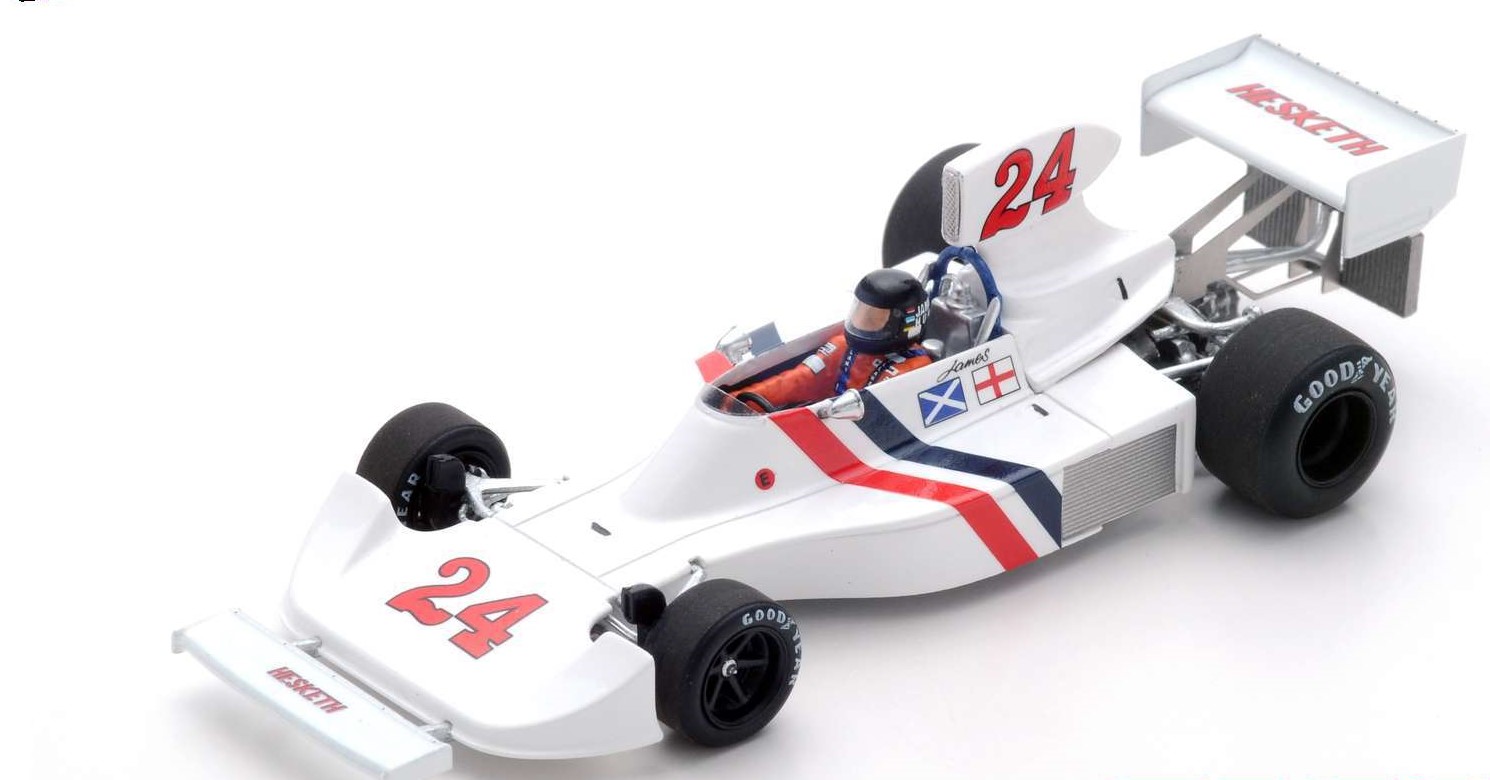 Spark: J.Hunt's Hesketh 1st Dutch GP 1975
Spark: J.Hunt's Hesketh 1st Dutch GP 1975
But Zandvoort also hit the headlines for the wrong reasons. In 1960 Dan Gurney's accident in his BRM resulted in the death of a young spectator. Piers Courage, driving the Williams De Tomaso in the 1970 race crashed, his car somersaulted and exploded killing him instantly. And in 1973 a suspected tyre failure caused Roger Williamson's March-Ford to pitch into the barriers at high speed which resulted in his car catching fire. Although Williamson was not seriously injured in the crash he was trapped in his burning, overturned wreck. Fellow driver David Purley stopped immediately to help but wasn't able to right the car by himself and race officials wrongly assumed Purley was the driver of the fiery wreck so did not stop the race which delayed the arrival of the fire truck. Nearby marshals were also unwilling to assist Purley as they did not have the necessary fire-retardant clothing. Williamson, in only his second race died of asphyxiation.
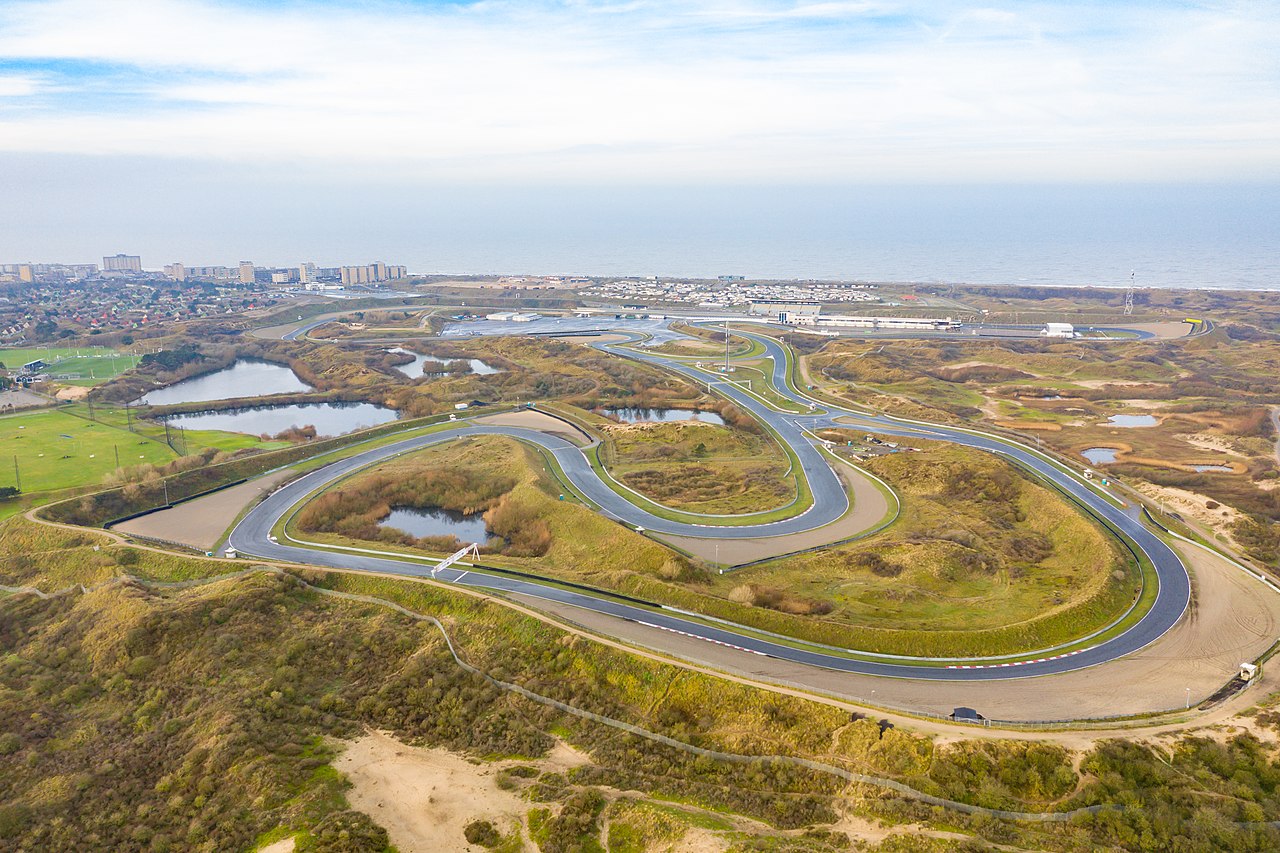 Zandvoort circuit photo 2018 (Source:Dronepicr)
Zandvoort circuit photo 2018 (Source:Dronepicr)
The Formula One circus visited Zandvoort for the last time in 1985. The company that ran the circuit went out of business; the ever-more stringent safety requirements proved a drain on depleted resources and with no funds forthcoming, Holland was no longer on the calendar. But the circuit survived as a venue for mainly domestic racing with some of its iconic corners remaining.
New Additions: June 2019
Welcome to another monthly update. Some new and interesting F1 cars turned up a few weeks ago from Spark and included some Ligiers and Shadows. But the most anticipated car was the 2018 Red Bull RB14 that Daniel Ricciardo drove to a much deserved Monaco victory. After his maiden pole position at Monaco in 2016 and then a pit-stop blunder costing Ricciardo a certain win, his flawless 2018 victory was a very sweet one indeed. Attention Ricciardo fans, Minichamps has produced this winning model and is a limited edition of only 576 models.
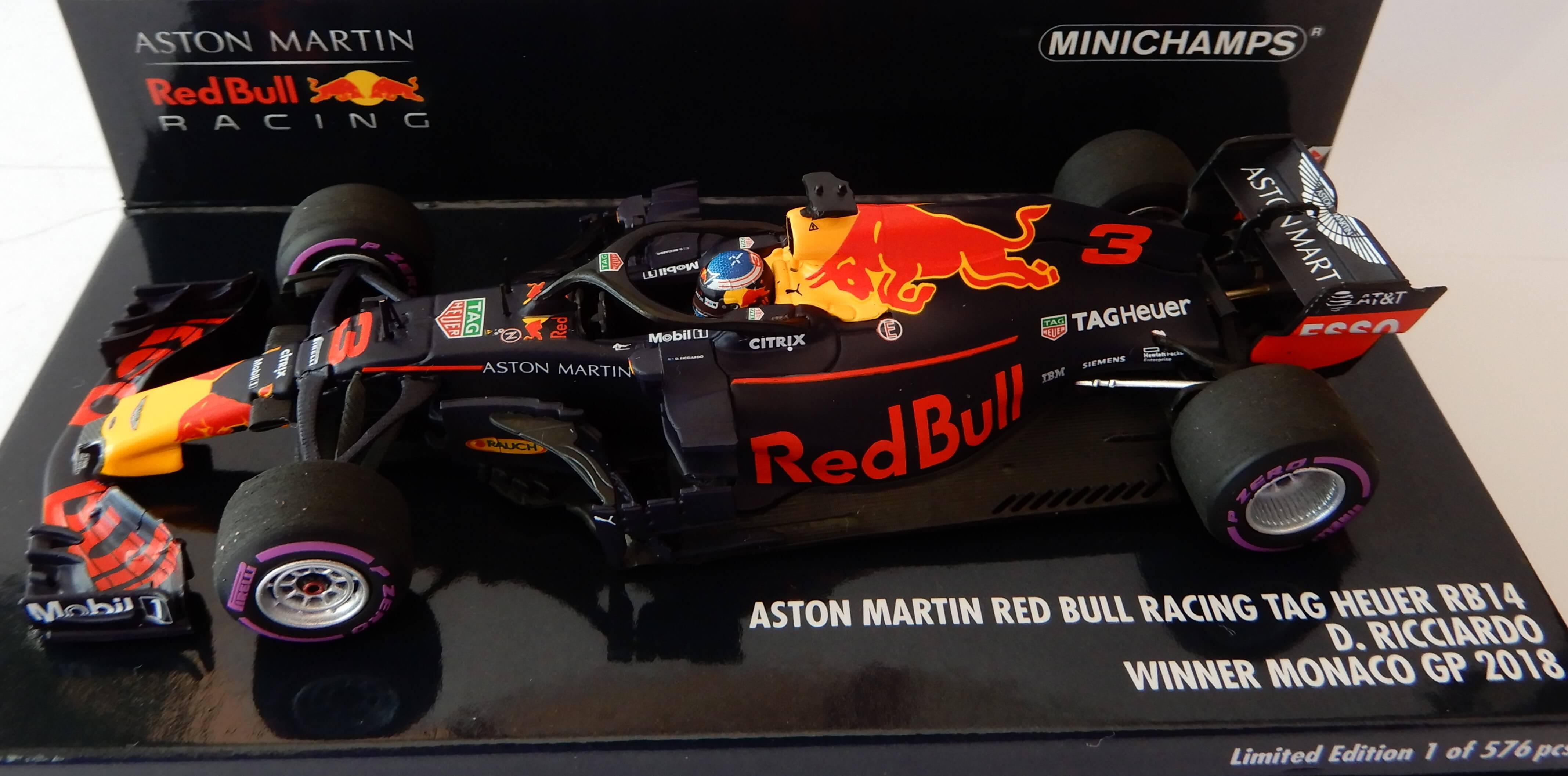 Minichamps: D.Ricciardo Red Bull Monaco win 2018
Minichamps: D.Ricciardo Red Bull Monaco win 2018
After winning the 2016 Porsche Carrera Cup Australia, Matt Campbell moved to Germany and was 3rd in 2017 Porsche Supercup. This result led to a drive for Dempsey-Proton Racing in the LMGTE Am class of the 2018-19 FIA World Endurance Championship and at the 2018 24 hours of Le Mans, he won the class with co-drivers Christian Ried and Julien Andlauer. Spark has produced Campbell's class winning Porsche which will please collectors who collect Australian drivers in international races.
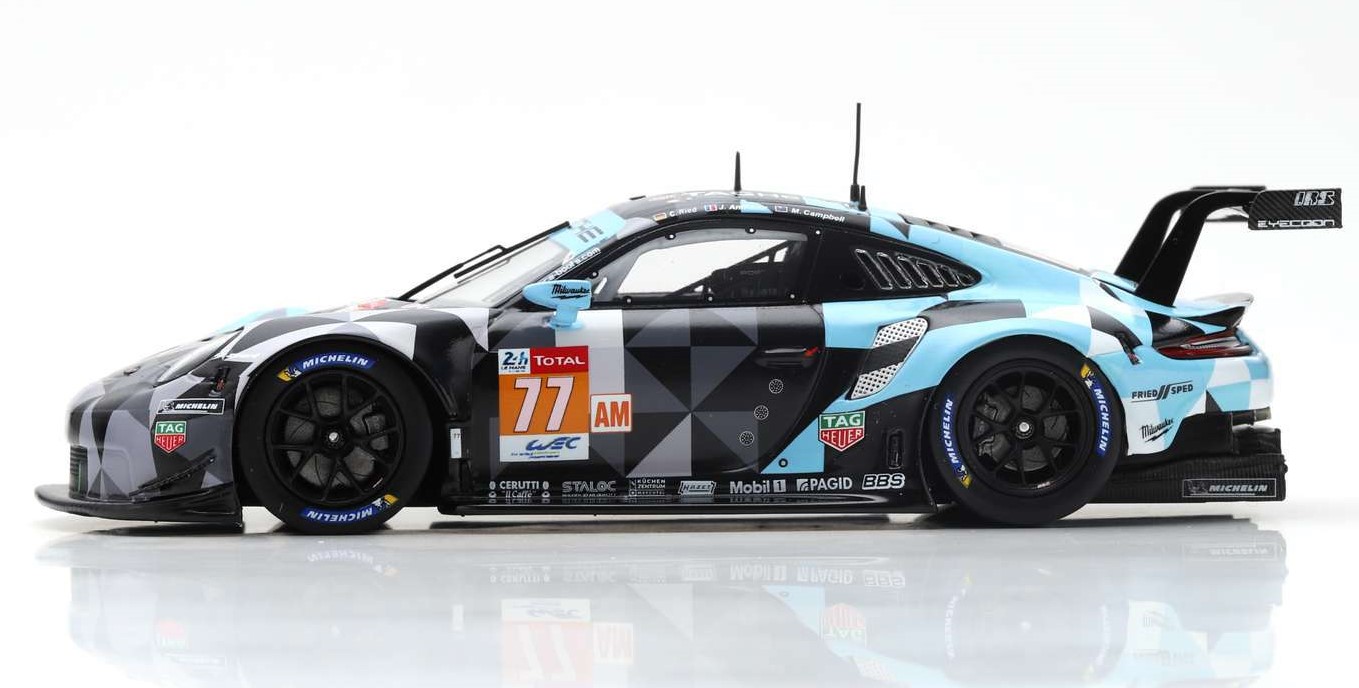 Spark: 2018 Matt Campbell Porsche 911 RSR
Spark: 2018 Matt Campbell Porsche 911 RSR
OK, it's a short and sweet one this month. Only one model fair in June, the regular Friday night affair at Granville, hosted by the Sydney Model Auto Club on 14 June at 6:30pm. Hope to see you there, until next time, happy collecting.
Formula One
- 1988 Benetton Ford B188, T.Boutsen (20) 3rd Canadian GP (Spark)
- 2018 Ferrari SF71H, K.Raikkonen (7) 1st US GP (Looksmart)
- 1988 Ligier Judd JS31, R.Arnoux (25) Monaco GP (Spark)
- 1988 Ligier Judd JS31, S.Johanssan (26) Detroit GP (Spark)
- 1967 Lola BMW T100, D.Hobbs (27) F2 German GP (Spark)
- 1981 Lotus Ford 87, N.Mansell (12) 4th Las Vegas GP (Spark)
- 1966 Matra MS5, G.Hill (28) Grand Prix de Reims F2 (Spark)
- 1977 McLaren Ford M23, E.de Villota (36) Spanish GP (Spark)
- 2017 Mercedes AMG W08, L.Hamilton (44) Russian GP (Minichamps)
- 2018 Red Bull Tag Heuer RB14, D.Ricciardo (3) 1st Monaco GP (Minichamps)
- 2018 Sauber Ferrari C37, C.Leclerc (16) Canadian GP (Minichamps)
- 2018 Sauber Ferrari C37, C.Leclerc (16) 6th Azerbaijan GP (Minichamps)
- 1979 Shadow Ford DN9, E.de Angelis (18) 4th USA GP (Spark)
- 1979 Shadow Ford DN9, E.de Angelis (18) Argentinian GP (Spark)
- 1975 Tyrrell Ford 007, J.P.Jabouille (15) race car (Minichamps)
American Race Series
- 1954 Buick Century, Ramirez/Zuniga (113) 17th Carrera Panamericana (TSM)
- 1972 Chevrolet Corvette L88, Heinz/Johnson (57) 4th Sebring 12 hour (TSM)
ATCC / V8 Supercars / Bathurst 12 hour
- 2016 Volvo S60, S.McLaughlin (33) 1st Phillip Is, Supersprint
- 2018 Porsche 911 GT3 R, Pappas/Bleekemolen/Lieb (540) 3rd Bathurst 12h (Spark)
Le Mans
- 2018 Porsche 911 RSR, Campbell/Ried/Andlauer (77) 1st LMGTE Am (Spark)
Road Cars
- 2011 Ferrari 458 Italia in red (Altaya)
- Falcon XB GT MFP Pursuit, Mad Max movie car (ACE)
- 2018 Porsche 911 GT3 RS in yellow, Weissach Package (Spark)
- 2018 Porsche 911 GT2 RS in white, Weissach Package (Spark)
After Thoughts: "Senna - The Toleman Year." This year marks the 25th anniversary of Aryton Senna's racing accident at Imola where he tragically lost his life (1 May 1994), so what a great opportunity to celebrate his short but successful career in F1. A lot has been written about his time with Lotus, his sometimes acrimonious rivalry with McLaren team mate Alain Prost and his brief time with Williams but probably less so during his one year with the Toleman Motorsport F1 team.

Toleman Motorsport was an F1 constructor based in the UK and was active from 1981 to 1985, attending 70 Grand Prix and starting in 57. Formed in the 1970's by Ted Toleman, the team raced in the British Formula Ford 2000 series in 1977, then progressed to Formula 2 winning the European F2 Championship in 1980. Spurred by their success in the lower fomulae, Toleman announced their participation in F1 for the 1981 season with Rory Byrne as their chassis designer and Hart as their engine supplier. Their first car, the TG181 was overweight and underpowered and only qualified twice in 1981. But by 1983, the TG183B was a much improved car and the team's budget increased with their current sponsor, Candy being joined by Magirus and BP. That year, the team scored their first points and finished 9th in the Constructor's Championship.
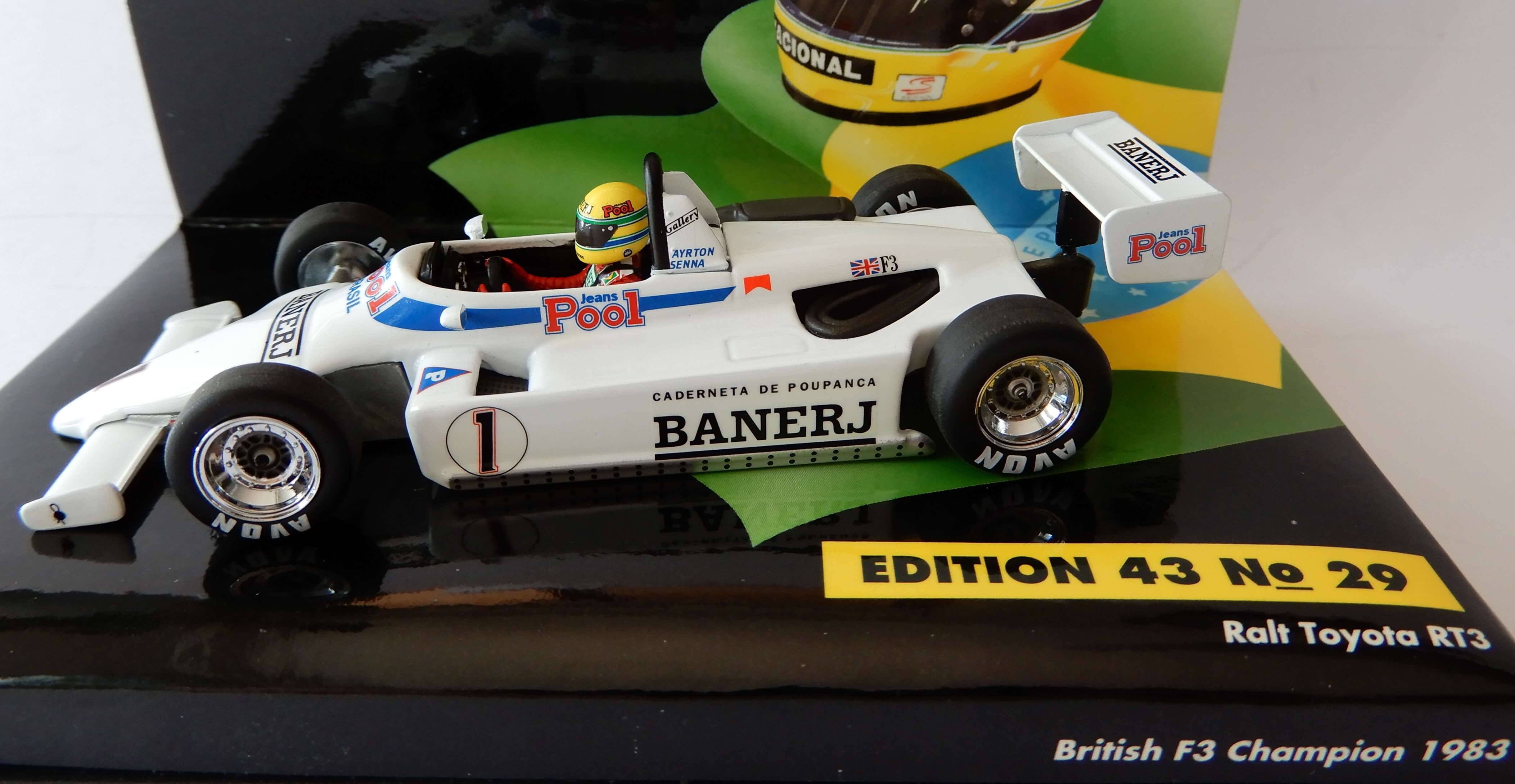 Minichamps: Senna Ralt RT3 1983 British F3 Champion
Minichamps: Senna Ralt RT3 1983 British F3 Champion
In 1983 Aryton Senna was driving for West Surrey Racing in the British F3 Championship after winning the British and European Formula Ford 2000 championships in 1982. Senna, in a Ralt Toyota RT3 went on to win the F3 championship at the final round after a tightly fought battle with Martin Brundle. Senna also managed to win the Macau F3 race that year. Such was the buzz around Senna during this time, he would test four F1 cars during the 1983 season. The first of these was for Williams, in that year’s FW08C at Donington where he famously went faster than Williams had ever gone around the circuit within his first 10 laps in an F1 car. Subsequent tests with McLaren, Toleman and Brabham only confirmed his remarkable ability. However, neither Williams nor McLaren had a vacancy for 1984. The Lotus team wanted to replace Nigel Mansell with Senna but British sponsor JPS wanted a British driver and Brabham's Italian sponsor Parmalat wanted an Italian driver to partner Nelson Piquet. Consequently, Senna joined the Toleman team.
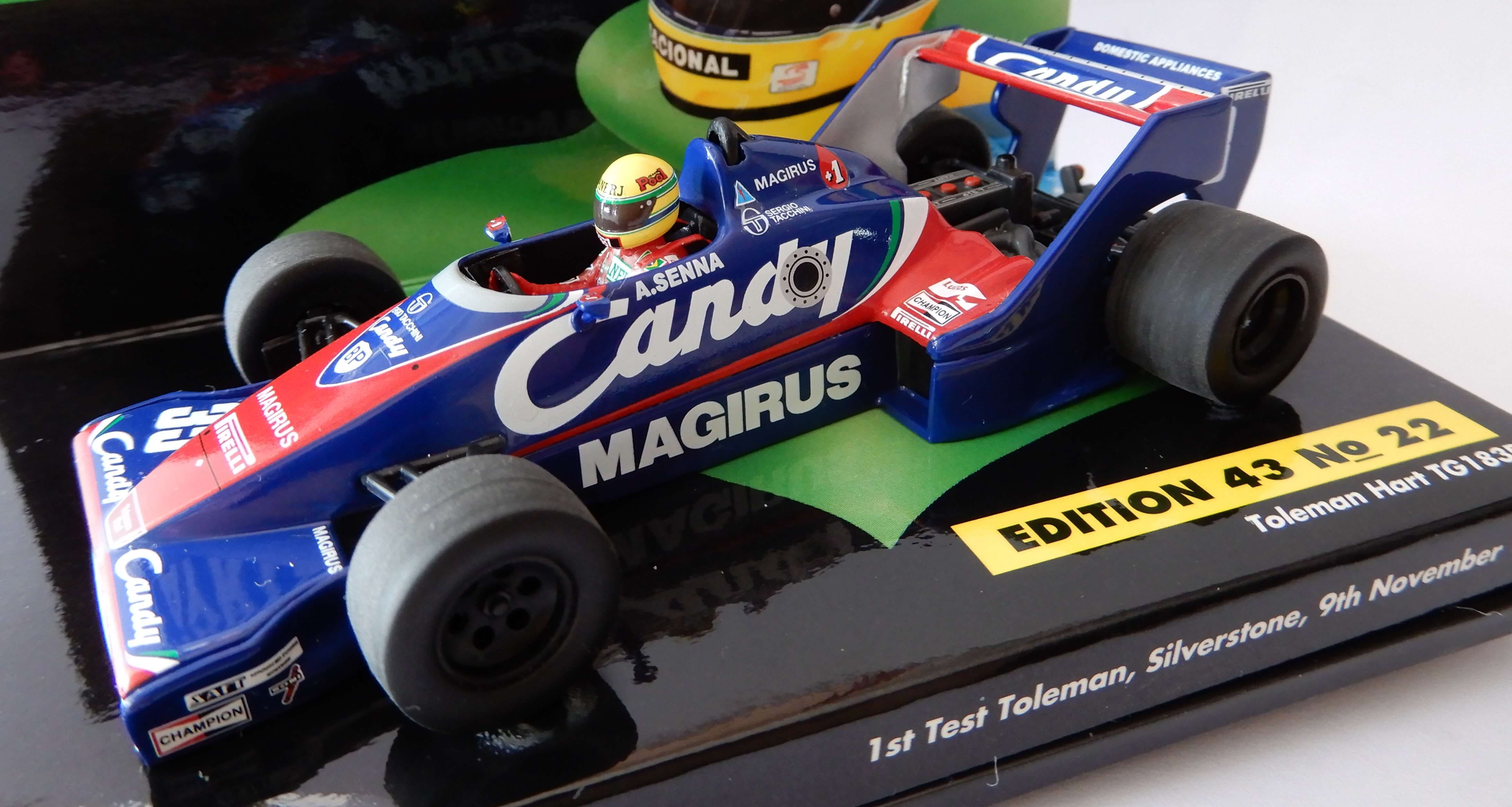 Minichamps: Senna Toleman Test 1983
Minichamps: Senna Toleman Test 1983
For 1984 Toleman had a new driver lineup; F1 rookie Ayrton Senna and the Venezuelan dual GP Motorcycle champion, Johnny Cecotto but started the season with their old TG183 car while waiting for the new TG184 to be ready. The first race was the Brazilian GP where Senna qualified 17th but his would be the first car to retire after 8 laps. The next race was at South Africa and Senna, showing what a remarkable talent he was, finshed 6th scoring his first World Championship point. He repeated the result at the next race at Belgium to underscore his talent. The next race was at San Marino and Toleman was now in dispute with their tyre supplier, Pirelli after the team decided to abandon the Italian rubber supplier. The team opted to sit out the first day of qualifying and then fuel-pressure problems in the final session meant Senna did not qualify for a GP for the only time in his F1 career. After San Marino came the French GP where the new TG184 chassis made its debut but for Senna it resulted in a DNF with turbo failure. Then it was onto Monaco.
The 1984 Monaco GP was a race filled with drama, intrigue and a conspiracy theory worthy of a John Grisham novel. It was a wet race and Prost in his McLaren was leading nearing the half way point but he was slowing dramatically, his carbon-fibre brakes, not able to reach their optimal temperature were locking up plus a misfiring engine meant he was vulnerable. Prost waved furiously at the stewards, wanting the race stopped. Meanwhile, Senna in his uncompetitive Toleman, showing his wet weather skills was catching Prost at an alarming rate and finally passed the Frenchman just before the end of the 32nd lap. Then the red flag to stop the race was shown but according to the rules, the positions counted are those from the last completed lap, i.e. lap 31 so Prost was the winner with half points awarded. Jacky Ickx, the clerk of the course waved the red flag without consulting the stewards and herein lies the conspiracy theory; both Ickx and Prost were French and no French driver had ever won the world championship, Ickx was at the time a contracted Porsche sportscar driver and Prost was powered with a Porsche engine, also the rain was not falling as hard when the race was stopped. Later, the Toleman team admitted that suspension damage to Senna's car meant he would have had to retire within a few laps after the race was stopped and even more intriguing, had the race been allowed to continue until 75% of the laps, full points would have been awarded meaning Prost may have won that year's championship (he eventually lost to Lauda by half a point).
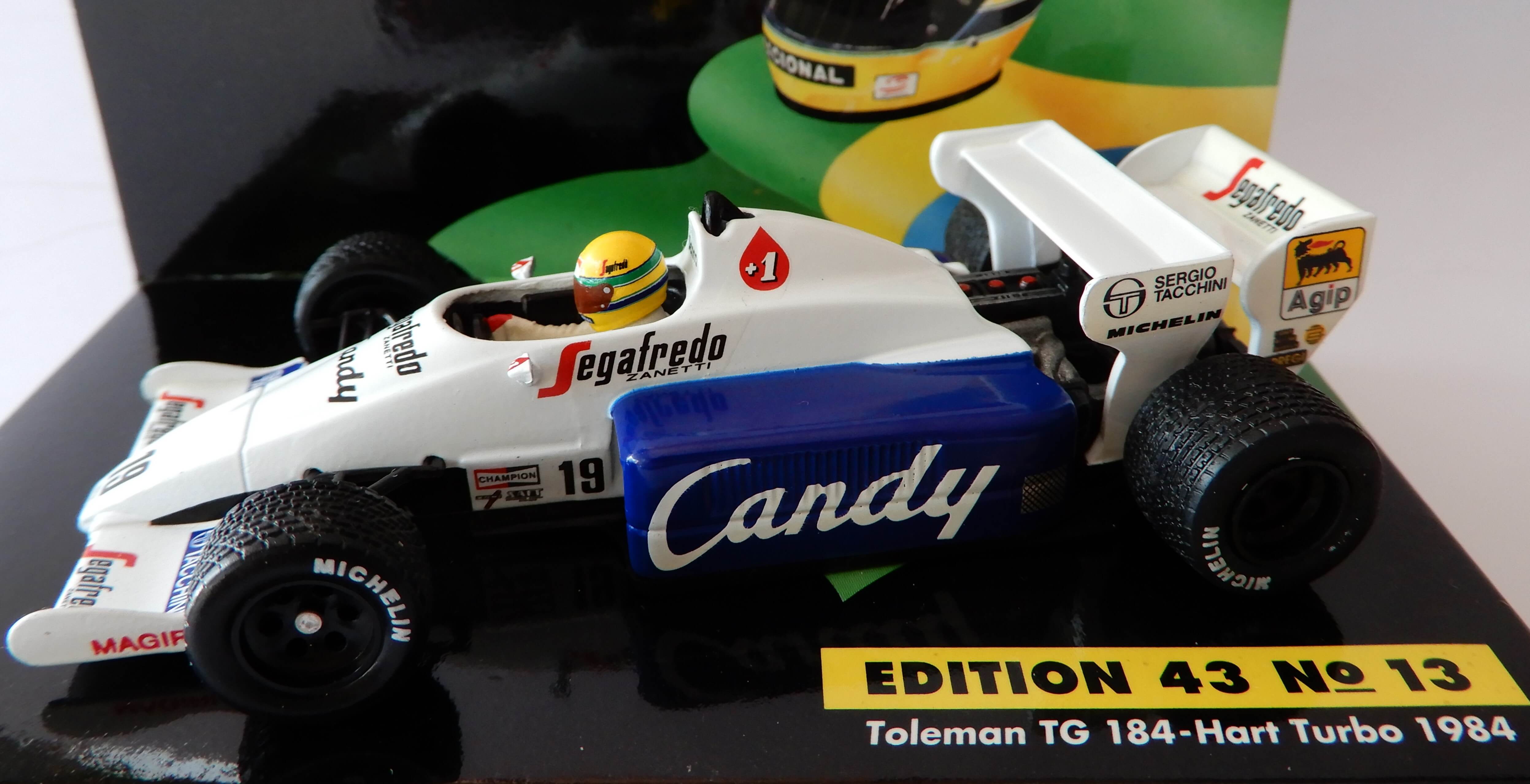 Minichamps: Senna Toleman Hart TG184
Minichamps: Senna Toleman Hart TG184
After Monaco, Senna and Toleman went through a lean patch before a magnificent 3rd place at the British GP. Then a further three race retirements marked Senna's scorecard. At the Italian GP at Monza the 14th GP of a 16 race season, Toleman suspended Senna from the race. Senna had breached his contract by signing for Lotus for 1985 without informing the Toleman team first. He was reinstated for the last two races and rewarded Toleman with another 3rd placing at the final race in Portugal. At the end of the season, Senna had scored 13 points (9th in the drivers championship) and the Toleman team had garnered 16 points for 7th place in the constructor's championship. Ayrton Senna's F1 career took a leap forward the following year driving for Lotus and then for McLaren and three world championships beckoned.
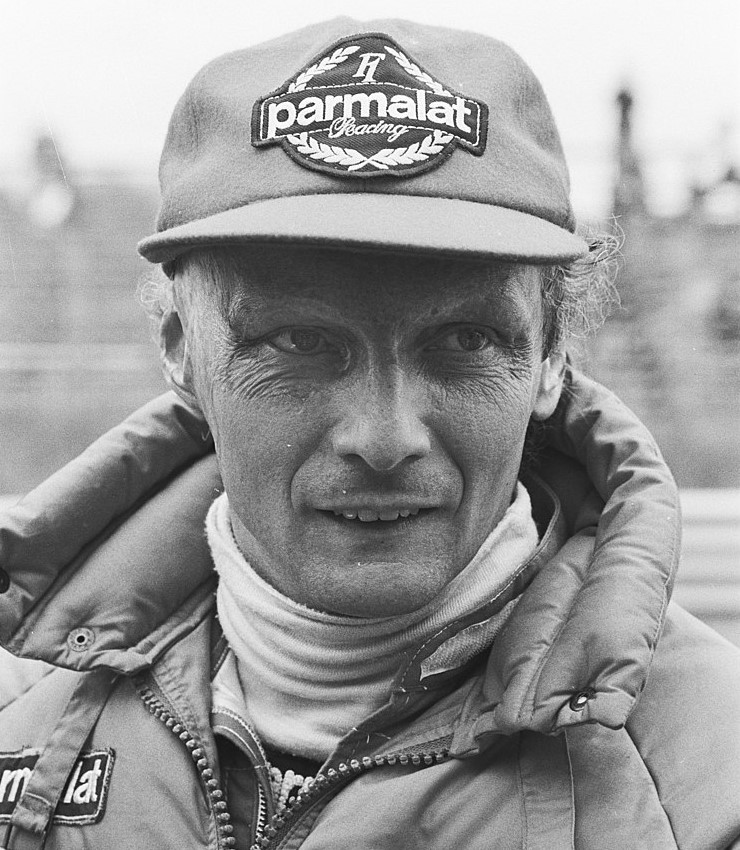 On a final sad note, the motor sport world lost another legend with the passing of Niki Lauda on 20 May 2019 at the age of 70. The man with the cap will be sorely missed. (Photo: Dijk, Hans van)
On a final sad note, the motor sport world lost another legend with the passing of Niki Lauda on 20 May 2019 at the age of 70. The man with the cap will be sorely missed. (Photo: Dijk, Hans van)
[Back to Top]
New Additions: May 2019
Welcome to another monthly update. Only a few new additions this month and a few restocked models as well. My highlights this month? Many were surprised that Kimi Raikkonen had his Ferrari contract renewed in 2018 as his race and qualifying results compared most unfavourably with his team mate, Sebastian Vettel. Since rejoining Ferrari in 2014, Raikkonen hadn't won a single GP whilst Vettel who joined Ferrari in 2015 had won eight times for the Scuderia. Things were looking good for Raikkonen at the first race of 2018 in Australia with the Fin qualifying 2nd and ahead of Vettel. But during a "Virtual Safety Car" period, Vettel pitted and emerged in the lead where he remained to the end of the race, relegating Raikkonen to 3rd. Italian model maker LookSmart, have produced Kimi's car from this race.
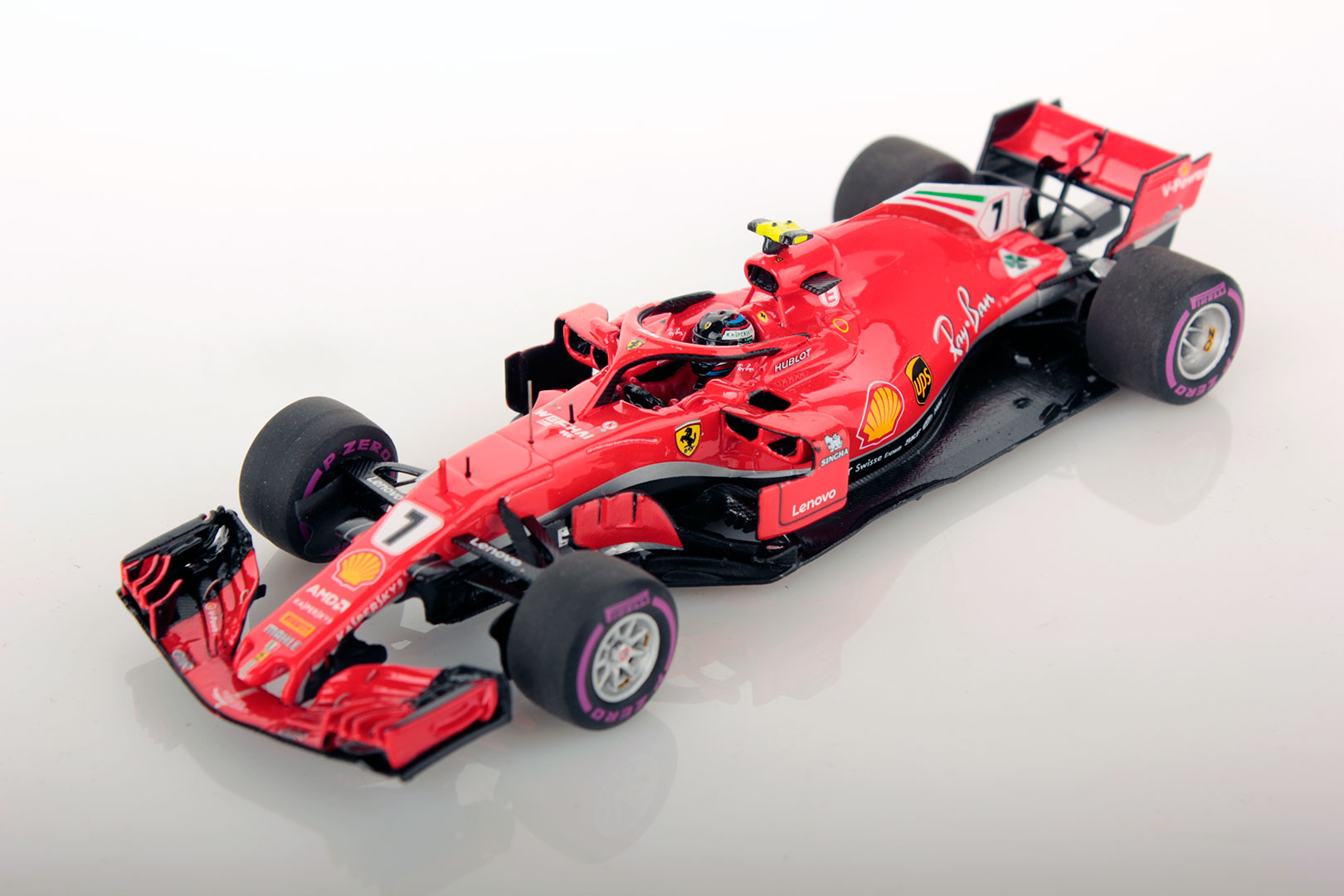 LookSmart: Ferrari SF71H Raikkonen 3rd Aust GP 2018
LookSmart: Ferrari SF71H Raikkonen 3rd Aust GP 2018
After the withdrawal from Le Mans of the factory Porsche team in the top LMP1 class, it was left to the Porsche 911 RSR to compete in the LMGTE-Pro and LMGTE-Am classes. In the Pro class, their competition was from the Ford GT, the Chevrolet Corvette C7R, the Ferrari 488 GTE and the Aston Martin Vantage. After 24 hours of racing, the Porsche 911 was 1st and 2nd in the Pro class with the retro-liveried "Pink Pig" Porsche being a popular winner, especially with Porsche model car collectors. Spark's 2018 Pink Pig car would look great displayed next to the original 1971 Porsche 917/20 Pink Pig. Both models are available.
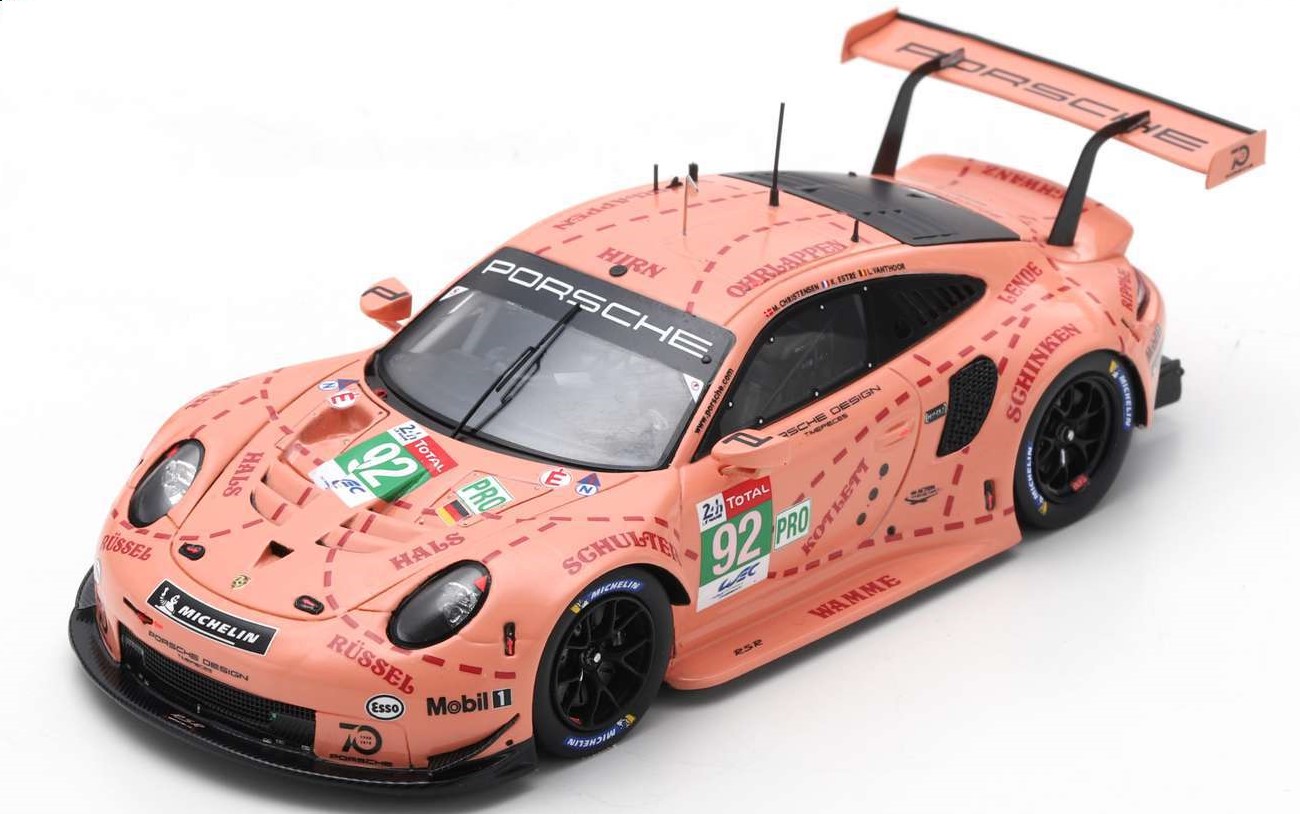 Spark: Porsche 911 RSR 1st LMGTE-Pro 2018
Spark: Porsche 911 RSR 1st LMGTE-Pro 2018
OK that's it for another month. Two model cars fairs are on this month; the regular Friday evening fair at Granville (10 May) and then on Sunday, the Collectormania Fair at Penrith (12 May). I hope to see you at one or both shows! Until next month, happy collecting.
Formula One
- 1962 Brabham Climax BT3, J.Brabham (16) German GP (Spark)
- 1964 Brabham BRM BT11, J.Siffert (19) 4th German GP (Spark)
- 1978 Brabham Alfa BT46, J.Watson (2) 3rd South Africa GP (TSM)
- 2018 Ferrari SF71H, K.Raikkonen (7) 3rd Australian GP (LookSmart)
- 1969 McLaren Ford M7A, D.Hulme (5) Mexican GP winner (Spark)
American Racing
- 1971 Porsche 917K, Elford/Larrousse (3) 1st Sebring 12 hour (Spark)
- 1977 Porsche 911 Carrera RSR, Dyer/Frisselle (30) 1st Sebring 12 hour (Spark)
- 2017 Norma MXX RD Limited, R.Dumas (30) 1st Pikes Peak (Spark)
Le Mans
- 1975 Alfa Romeo 33 TT/12, Ickx/Merzario (1) Team WKRT Spa (TSM)
- 1965 Alpine Renault M65, Bianchi/Grandsire (46) DNF Le Mans (Spark)
- 1976 BMW 3.5 CSL, Brock/Muir/Aubriet (46) Le Mans (Biante)
- 2013 McLaren MP4-12C GT3, Carroll/Verdonck/Bell (69) 24 hours of Spa "Gulf" (TSM)
- 2015 McLaren 650 GT3, Mori/Valori/Balzan (54) Monza (TSM)
- 2016 McLaren 650S GT3, Watson/Moore/Fontana (59) 24 hours of Spa (TSM)
- 1996 Porsche 911 GT2, Bagnall/Pilgrim/Ortelli (83) Le Mans (Spark)
- 2018 Porsche 911 (991) RSR, Christensen/Estre/Vanthoor (98) 1st LMGTE-Pro (Spark)
Road Cars
- 1954 Buick Century Wagon in black/green (TSM)
- 1957 Land Rover Series 1 88" Fire appliance (TSM)
- 2016 McLaren 675 LT in mantis green (TSM)
- 1959 Rolls Royce Silver Cloud Coupe in silver (TSM)
After Thoughts: "The History of Grand Prix in the United States." There's been a lot of celebration recently over the 1000th F1 World Championship grand prix held on 14 April at Shanghai and while numerically correct, a few purists have argued the 11 races held between 1950 - 60 at the Indy 500 shouldn't be counted. These Indy 500 races were raced under American regulations and as such did not attract any F1 teams and drivers apart from Ferrari, who entered Alberto Ascari in the 1952 Indy 500. Ascari failed to finish that race. It wasn't until 1959 that the first "real" US Grand Prix was held at the home of the Sebring 12 hour endurance race. It was the only year that Sebring hosted the US GP and it was the last race of the '59 season. It was a notable race where Bruce McLaren won his first GP, where Jack Brabham had to push his out-of-fuel Cooper over the finish line to claim 4th place and the World Championship and it was the last race to award a point for fastest lap until the 2019 Australian GP. Despite the enthralling finish, the Sebring GP failed to ignite the interest of the American public.
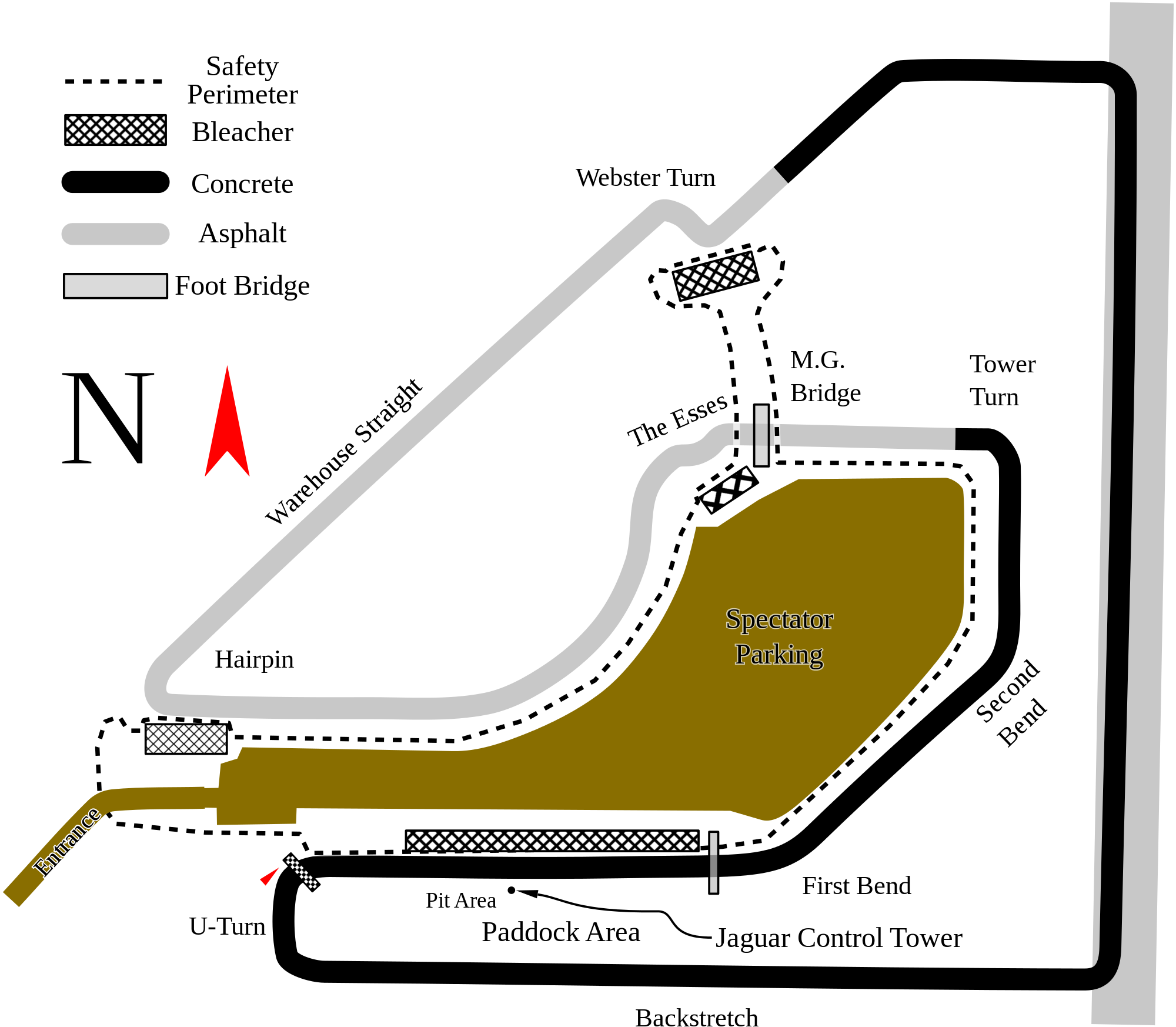 Sebring F1 8.36 Km Track Layout 1959 (W.Pettinger)
Sebring F1 8.36 Km Track Layout 1959 (W.Pettinger)
1960 was to be the last year that the Indy 500 race counted towards the World championship and the year the US GP moved to a new track, Riverside in California; the organisers hoping the move from Florida to the west coast would prove to be a commercial success. Once again the US GP hosted the final race of the season but this time Jack Brabham had already secured his second world championship 2 races previously. Of wider concern for the organisers, the race again failed to ignite public interest and Riverside had hosted its first and last US GP.
For 1961, the US GP found a home in picturesque upstate New York, near the tiny village of Watkins Glen. In 1956 a sports car enthusiast purchased 550 acres of land and built an international standard permanent racing facility. The circuit, known as "The Glen" was able to successfully host the US GP for twenty years until 1980. The first race at The Glen saw a crowd of 60,000 fans who witnessed Innes Ireland claim his first and only GP win in his Lotus-Climax; it was also the Lotus team's maiden win as well. But by the 1970's the circuit and facilities were deteriorating from a lack of substantial investment and The Glen's reputation waned rapidly. In 1980, against a backdrop of mounting debts, The Glen played host to its final GP which saw Alan Jones win a thrilling race to clinch the World Championship. After the death of two drivers at The Glen (F.Cevert in 1973 and H.Koenigg in 1974) plans were put into place for a second US GP to be held on the West Coast at Long Beach, a small city within the greater Los Angeles area.
Minichamps: McLaren M19 Watkins Glen 1972
The Long Beach street race, called the US GP West made its debut in 1976 and the US was only the second country (after Italy in 1957) to host two championship races in the same season. Like most other street circuits, Long Beach was narrow and gruelling for both cars and drivers but the circuit was an immediate success and compared favourably with the Monaco GP. In 1977 Mario Andretti scored a very popular win in his Lotus, becoming the first and only American to win a GP on home soil (excluding, of course the early Indy 500 races). After the 1983 event, the Long Beach race organisers decided it was just too expensive to run F1 races and switched to running CART Indycars in 1984.
With Watkins Glen being struck off the 1981 calendar, an opportunity arose to expand F1 to new frontiers and most bizzarely, it was decided that Las Vegas was to be the second US race. The venue was the tight confines of the Caesars Palace Hotel car park with the circuit consisting of repeating "fingers" to create an anti-clockwise 3.65 Km track. In a departure from tradition, the race was not to be named after the host nation but known officially as the Caesars Palace Grand Prix. It was not a popular race with the drivers due to the heat and sand, nor with the paying public. Alan Jones won the inaugarual race in 1981 and Caesars Palace lost money (unusual for a casino). Thankfully the Las Vegas race was held for only another year with Michele Alboreto winning in 1982.
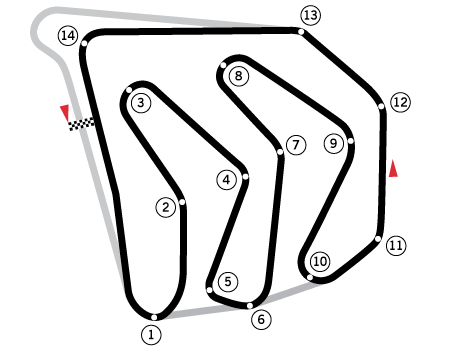 Caesars Palace GP Layout
Caesars Palace GP Layout
In 1982 the United States became the first country to host three Grand Prix races in one season; the US GP West at Long Beach, the Caesars Palace GP and the Detroit GP. The Detroit GP, held in the hometown of Ford and General Motors ran from 1982 to 1988. The 4 Km, 17 corner "point and squirt" style street circuit was renowned for being extremely bumpy and the surface prone to breaking up during the race. Being even slower than the Monaco GP, the Detroit GP was surprisingly popular with the public. Naturally, drivers renowned as street circuit specialists excelled at Detroit; drivers such as Nelson Piquet, Keke Rosberg and Ayrton Senna all tasted victory in their brutal turbo-powered cars.
Minichamps: Benetton BMW 1986 Detroit GP
For reasons that defy logic, a Grand Prix in Dallas was slated to replace the US GP West at Long Beach in 1984. It was to be held in the heat and humidity of a Texan July summer where average daily temperatures were 38 deg.C. The temporary circuit in downtown Dallas experienced track temperatures of 66 deg.C and with such extreme temperatures combined with tremendous tyre and aerodynamic adhesion meant that the track almost completely disintegrated. Nigel Mansell put his Lotus on pole, the first of his career. After the support races left huge holes in the track, some drivers wanted the race to be cancelled. Nevertheless, in 40 degree temperatures the race was held but only 7 of the 26 cars finished the race, with pole-sitter Mansell coming 6th despite collapsing from exhaustion and dehydration while trying to push his strickened car over the finish line. The Dallas GP was to be a one-off event.
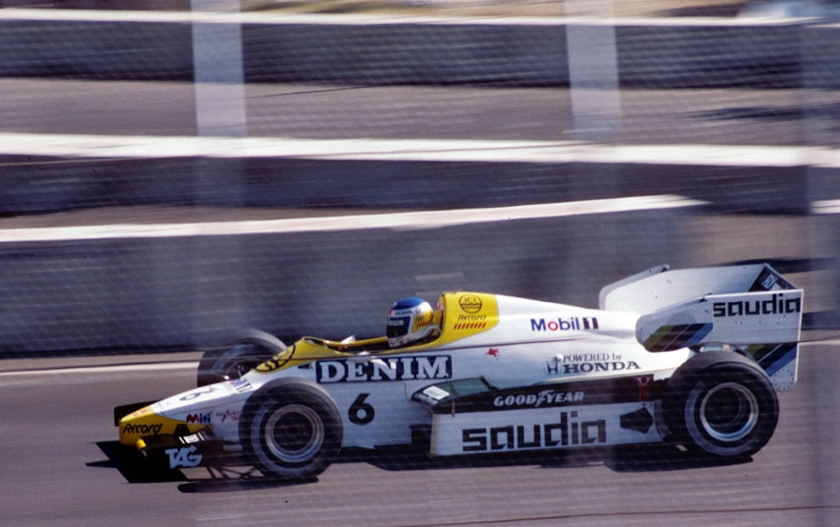 K.Rosberg 1st Dallas 1984 (twm1340)
K.Rosberg 1st Dallas 1984 (twm1340)
After the last GP at Detroit in 1988, US GP had a new home; the hot desert city of Pheonix, Arizona. It was a new place, but the same old dirty and dusty street circuit but was considerably wider, faster and less bumpy than both Detroit and Dallas. The inaugural race in 1989 saw Alain Prost take the win but the heat of the Phoenix desert was hard on cars and drivers with just 6 of 26 cars finishing. In an attempt to beat the scorching heat the date of the 1990 race was moved to a cooler part of the year. The last Phoenix race was held in 1991 and F1 beat a retreat from the United States; not returning for almost ten years.
In 2000, F1 racing returned to the spiritual home of racing in North America, the Indianapolis Motor Speedway. It took two years of renovation and construction to adapt the venue for F1; a 4.2 Km course was built on the in-field of the famous track and also incorporating half a lap of the banked oval. To the relief of all concerned the race proved immensely popular with 225,000 fans attending the first race. The most controversial race in F1 history occurred in 2005 when several Michelin tyre failures marred practice for the event. This led the French tyre manufacturer to declare their tyres could not last more than 10 laps on the high speed banking at turn 13 unless the cars were slowed down with the placement of a chicane. The FIA, the governing body refused to disadvantage the Bridgestone-shod teams whose tyres were up to the job so after the formation lap, the 14 cars with Michelin tyres peeled into the pitlane admidst howls of derision from the packed grandstands. Only 6 Bridgestone cars started the race. The races in 2006 and 2007 went without incident but after the 2007 race, the organisers publicly stated they couldn't meet the financial demands of Bernie Ecclestone and the US GP once again drifted off the F1 calendar.
Minichamps: Minardi PS01 Indianapolis 2001
To those with a commercial interest in F1, the American market was too important to leave dormant for long. Despite various statements from potential race venues including New Jersey and New York, it was announced that Austin, Texas had been awarded the US GP on a ten-year contract, starting in 2012. The purpose-built Circuit of the Americas (COTA) has been universally praised by drivers and Lewis Hamilton won the inaugural race in his McLaren-Mercedes. Lessons from the ill-fated Dallas race had been learnt and the Austin races are held in the cooler part of the year. The relationship between Formula One and the United States has long been a difficult one, but Austin's success makes it seem as though it has finally become an enduring partnership.
New Additions: April 2019
Welcome to another monthly update. Last month I began by mentioning the start of another F1 and V8 Supercar racing year but I forgot to mention it was also the start of the Indy Car series; the ANZAC's did well in the first race at St. Petersburg (Dixon in 2nd and Power in 3rd). The most interesting aspect of the Australian F1 race was the strong showing of the Red Bull - Honda combination with a 3rd place finish being Honda's first podium upon their return as an engine supplier in 2015.
An interesting mix of model cars this month. My hightlights this month? The 3rd generation Audi 200 was a four-door, 2.1L front-engine all-wheel drive sedan produced from 1982 to 1991. In 1988, Audi entered the 510 horse-powered Turbo Quattro in the American Trans-Am Series with the Bob Tullius Group 44 Racing Team preparing the cars for Hurley Haywood, Walter Rohl and Hans-Joachim Stuck. The Audi 200 won eight out of thirteen races and although H-J Stuck won four races, it was the consistent performance of Haywood that would eventually win the championship for Audi. Audi's competition that year consisted of Oldmobile Cutlasses, Chevrolet Camaros, Corvettes and Mercury Merkur XR4Ti's, as well as other American muscle cars. In 1989, Audi moved to the IMSA series with the Audi 90 when the Trans-Am regulators decided to ban cars with non-American engines as well as all-wheel drive cars (in other words, the Audi 200 Turbo Quattro).
Minichamps: Audi 200 Quattro 1988 Trans Am
Frank Williams was a saloon car and F3 driver who wisely decided his talents lay not behind the wheel but in organising cars for other drivers. Over the years, Williams bought various cars to be raced in F1 but in 1972 he received backing from Italian toy manufacturer Politoys who provided the funds to build an in-house chassis which was called the FX3. The FX3 was a conventional Cosworth-engined car but was not successful in its debut season in 1972. The following year, Williams managed to obtain backing from Marlboro and Italian sports car manufacturer Iso Autoveicoli S.p.A and the original FX3 was reworked into the Iso-Marlboro FX3B to be driven by New Zealander, Howden Ganley and Italian Nanni Galli. Ganley raced the FX3B for the first three races in 1973 after which it became obsolete due to changes in the design regulations. Spark has produced Ganley's South African GP FX3B car which was the car's final Championship race.
Spark: Iso-Marlboro FX3B H.Ganley 1973
Stephane Peterhansel is a Dakar rally driver who has been a stalwart of the most famous rally-raid in the world for over 30 years. The 53-year-old Frenchman has won the Dakar Rally a record 13 times. He made his Paris to Dakar Rally debut in 1988 in the motorcycle category and won the event in 1991, 1992, 1993, 1995, 1997 and 1998 riding for Yamaha. Switching to the car category in 1999 he drove a Nissan Terrano to 7th and later joined the works Mitsubishi team in 2003. He then won for Mitsubishi in 2004, 2005 and 2007. In 2012 he joined the Mini Team and won in 2012 and 2013. For the 2015 event he drove for Peugeot and won it in 2016 and 2017. After Peugeot's withdrawal from the Dakar, Peterhansel was back in a works JCW X-Raid Mini Buggy for 2019 but crashed out while in 4th place. I've no doubt he'll be back in 2020.
TSM: Mini Countryman 2012 Peterhansel 1st Dakar
OK, that's a wrap for another month. Only one sawp meet in April, the regular Friday night event at Granville on 12 April. One last note, back in 2011 I attended the Hunter Model Auto Club's annual model car swap meet at Hexham (Newcastle) and it was a well-organised, friendly affair but unfortunately due to flagging interest, further events were cancelled indefinitely. Now the club is planning to hold the event again this year (27th October) but subject to sufficient expressions of interest from stall holders. If you would like to attend as a stall holder, please contact Bill Kenchington on 0419 430 825. Until next time, happy collecting.
Formula One
- 1986 Brabham BMW BT55, E.de Angelis (8) Monaco GP (Spark)
- 1973 Iso-Marlboro Ford FX3B, H.Ganley (21) 10th South African GP (Spark)
- 1991 Jordan Ford 191, M.Schumacher (32) Debut Belgium GP (CMR)
- 2018 McLaren Renault MCL33, F.Alonso (14) Race car Ed.43 No.184 (Minichamps)
American Race Series
- 1952 Kuzma Offenhauser, T.Ruttman (98) 1st Indy 500 "Agajanian Special" (Replicarz)
- 1988 Audi 200 Quattro, Trans Am Test Car (black) (Minichamps)
- 1988 Audi 200 Turbo, H.J.Stuck (14) 1st Trans Am Cleveland (Minichamps)
- 1973 Porsche 917/911 Twin set, 2-car set Tribute to M.Donohue (Minichamps)
Le Mans / Rally Cars
- 1959 Aston Martin DBR1, Salvadori/Shelby (5) LM winner (Spark)
- 1963 Aston Martin DP214, McLaren/Ireland (8) Le Mans (Spark)
- 1961 BMW 700 Sport, Hulbusch/Stausberg (64) 12 hr Nurburgring (Minichamps)
- 1980 Chevrolet Camaro, Carter/Edwards/Valentine (87) Le Mans Test (Spark)
- 1968 Ford Escort Mk1, H.Hahne (3) 500 Km Nurburgring (Minichamps)
- 1971 Ford Escort Mk1 RS1600, J.Fitzpatrick (114) 1st Brands Hatch (Minichamps)
- 1995 Honda NSX GT2, Satou/Kurosawa/Tanaka (85) DNQ Le Mans (TSM)
- 1970 Porsche 917LH, Kauhsen/Larrousse (3) 2nd Le Mans (CMR)
- 1984 Porsche 956K, Bellof/Bell (2) 1st Sandown 1000km "Rothmans" (CMR)
- 1984 Porsche 956B, S.Bellof (1) 3rd 200 miles Norisring (CMR)
- 1963 Ford Cortina Mk1, Taylor/Mella (193) Rallye Monte Carlo (Minichamps)
- 2012 Mini Countryman, Peterhansel/Cottret (302) 1st Dakar Rally (TSM)
Road Cars
- 1954 Alfa Romeo Giulietta Sprint in silver (Minichamps)
- 1961 Auto Union 1000 SP in green (Minichamps)
- 1974 Bitter CD in silver (Minichamps)
- 1967 Chevrolet Camaro in white with black stripes (Minichamps)
- 1963 Ferrari 250 GTE in silver (Altaya)
- 1964 Ferrari 250GT Berlinetta in silver (Altaya)
- 1966 Ferrari 330 GTS in silver (Altaya)
- 1989 Ferrari 348 TS in silver (Altaya)
- 1982 Honda Prelude in red (Minichamps)
- 1970 Lancia Fulvia 1600 HF in white (Minichamps)
- 2016 McLaren 675LT in white (TSM)
- 1976 Peugeot 504 Coupe in white (Minichamps)
- 1952 Rolls Royce Silver Wraith Royal in red and black (TSM)
- 2012 Rolls Royce Phantom EWB in diamond black (TSM)
- 2012 Rolls Royce Ghost EWB in english white (TSM)
- 2012 Rolls Royce Ghost EWB in diamond black (TSM)
- 2017 Porsche 911 (991) GT3 Cup, Carrera cup promo car (Spark)
- 2017 Porsche 911 (991) GT3 MkII in carmine red (Minichamps)
- 2017 Porsche 911 (991) GT3 MkII in metallic blue (Minichamps)
After Thoughts: "The Insanely Complex F1 Steering Wheel" I'm old enough to remember the time when car steering wheels were large in diameter with a thin rim and had two spokes and a horn button in the middle. As the years progressed, the humble steering wheel got smaller and sculpted hand grips were added, an air bag appeared in the middle which also acted as the horn and the spokes sprouted numerous buttons for cruise control and the bluetooth system. Just as the steering wheel for road cars evolved over time, so too has the steering wheel of Formula One cars, perhaps even more so.
Early wooden F1 steering wheel
Early Formula 1 cars used steering wheels taken directly from the road car; they were normally made from wood and tended to be as large in diameter as possible. With no power steering in those days, the large diameter was necessary to reduce the effort needed to steer the race car. But as cars became progressively lower and cockpits narrower through the 1960's and 70's, steering wheels got smaller so as to fit into the more compact space.
Smaller cockpits meant smaller steering wheels.
Today, steering wheels are not designed to make more than three quarters of a turn of lock in total, so there is no need for a continous rim, instead there are two grips for the driver's hands. The F1 wheel is now about half the diameter of that of a normal road car. The introduction of semi-automatic gearchanges operated through paddles at the back of the wheel marked the beginning of the move to concentrate controls as close to the driver's fingers as possible. The first buttons to appear on the face of the wheel were the "neutral" button for taking the car out of gear to preventing stalling the engine during a spin and the on-board radio push-to-talk button. Today, the only driver controls not on the face of the wheel are the throttle and brake pedals.
Amalgam: 1:4 Scale Jaguar F1 2004 Steering Wheel
The steering wheel has become the nerve centre of an F1 car and costs about US$70,000 each. There are dozens of parameters that can be adjusted on the fly, but only by the driver and some settings can change several times during the race or even a lap. Adjustments must be made while keeping both hands on the wheel, which is why the modern steering wheel might have 20 or more knobs, buttons and switches on either side of a small LCD screen. The screen can display as many as 100 pages of information and data - everything from engine RPM, oil temperature, current lap speed and laps remaining. Buttons on the wheel tend to used for "on/off" functions, such as engaging the pit lane speed limiter, while rotary controls govern functions with multiple settings, such as engine maps, fuel mixture and brake bias. Race control can also communicate with the driver via a compulsory, steering wheel mounted GPS marshalling system which can display warning lights to alert drivers to the marshals' flags. Here are just a few of the buttons/dials a driver needs to be familiar with:
- N Button - Neutral button, selects neutral from 1st or 2nd gear.
- BRKBAL - Brake balance rotary switch.
- Box button - Confirms driver's intention to come into the pits.
- Red Oil Button - Transfer oil from the aux. tank to the main tank.
- DRS button - Activates the rear wing flap in the DRS zone.
- PL Button - Activates the pit lane limiter.
- R Button - Activates the driver radio transmission.
- SOC Rotary Switch - Controls the state of charge of the ERS energy storage system.
- Fuel Rotary Switch - Controls the rate of fuel consumption.
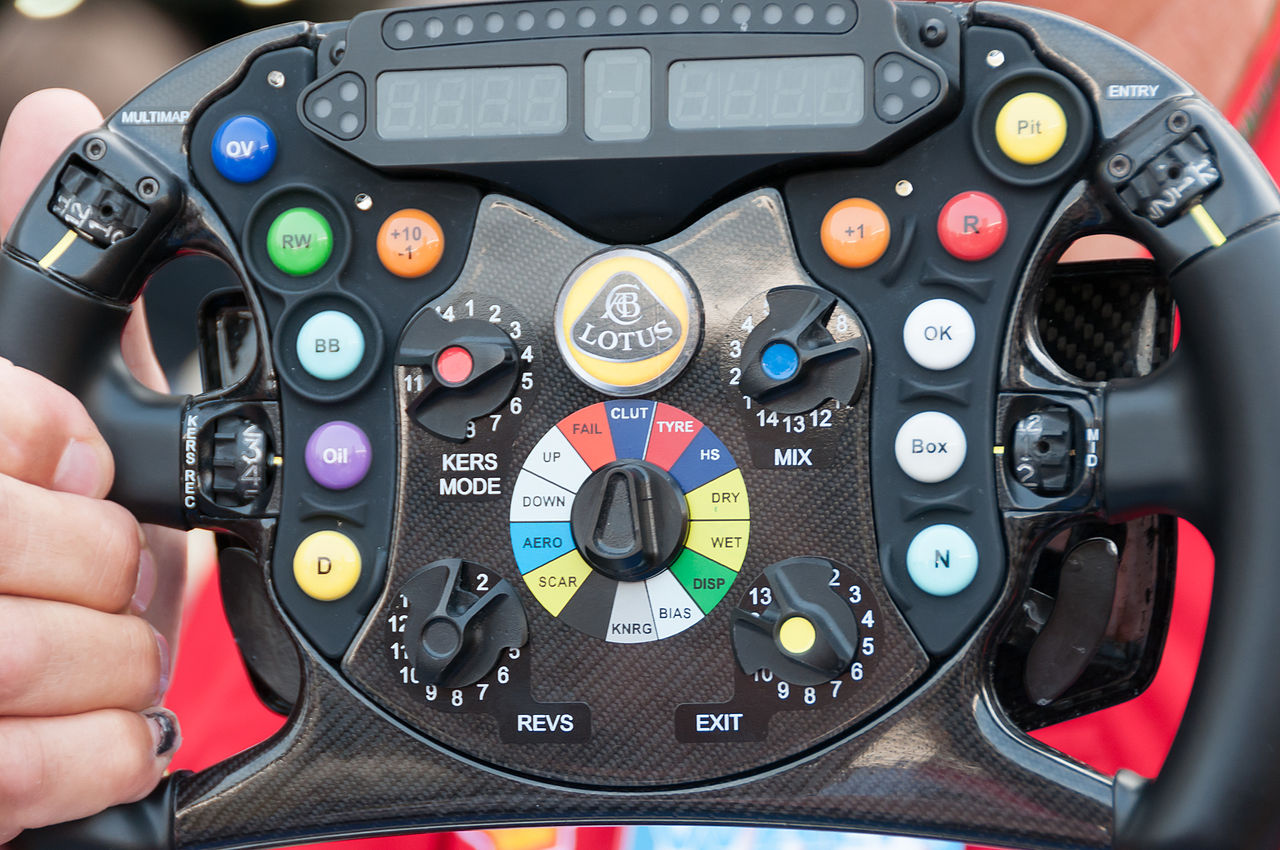 Lotus F1 wheel - 2012 (Photo: Francesco Crippa)
Lotus F1 wheel - 2012 (Photo: Francesco Crippa)
One of the most technically complicated part of the steering wheel is the snap-on connector that joins the wheel to the steering column. This has to be strong enough to take the steering forces, but it also provides the electrical connections between the controls and the car itself. The rapid release of the wheel is vitally important as regulations require the driver to be able to exit the car within seven seconds. As F1 technology continues to develop, the driver will need to process even more information in addition to actually steering and racing other cars!
New Additions: March 2019
Welcome to the March update. I just love March because it's the start of a new motorsport year, kicking off with the first race of the Australian V8 Supercars Championship in Adelaide on 2nd/3rd March. How will the new Mustangs perform against the older Commodores? Then on 17th March we have the opener of the F1 season at Melbourne. How will Ricciardo go driving a Renault and will Red Bull surprise us with its new Honda engines? So many questions! But let's get back to model cars.
There's not a lot of new models but a special mention should go to the 1978 Merzario Ford A1. The Merzario Formula 1 team was formed by former Ferrari, Williams and March driver Arturo Merzario in 1977. He bought and drove a March 761B that year when he couldn't find a drive with other teams and in 1978 built his own F1 car, the A1 which was largely based on his March 761. The A1 used the Cosworth DFV engine and appeared with a red bodywork for the first four races (Spark model S4846). A second A1 was introduced later in the season but it was suspected it was just his March 761 rebodied. This car performed slightly better in qualifying, now with black body work (Spark model S4847). For the 1978 season the Merzario A1 finished one race, failed to qualify nine times and retired on seven occasions. The Merazrio team continued in F1 in 1979 but quit at the end of the year after failing to qualify for most of the races.
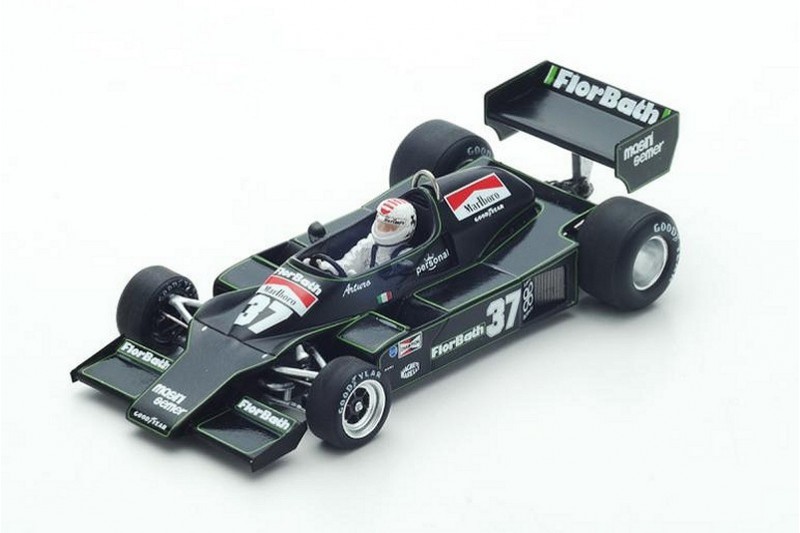 Spark: 1978 Merzario Ford A1
Spark: 1978 Merzario Ford A1
There have only been 5 female drivers who have competed in F1 since 1950 and only two who have qualified to race. Only one, Lella Lombardi has finished in the top 6 in a World Championship race and thus earned 0.5 points. She achieved this in the 1975 Spanish Grand Prix driving a March 751 and as race had to be stopped early, only half points were awarded. Lombardi qualified and raced in 12 Grand Prix over three years and her last race was the Austrian GP in 1976 driving a Brabham BT42. She finished in 12th position in her last F1 race and her car has been produced by Spark.
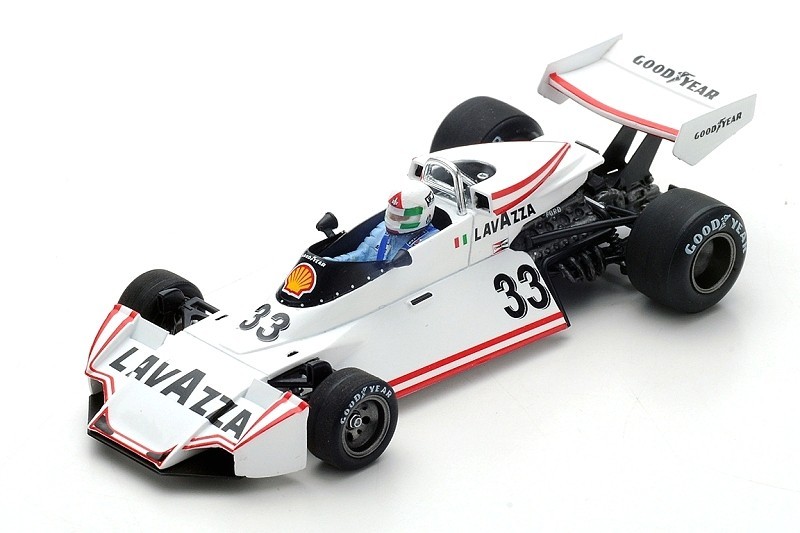 Spark: 1976 Brabham Ford BT44B
Spark: 1976 Brabham Ford BT44B
OK, that's it for another month. There are two model fairs on this month; the regular Friday night fair at Granville on 8th March and then the first Collectormania Fair for 2019 on 10th March. Until next month, happy collecting.
Formula One
- 1950 Alfa Romeo 158, race car (25) (Brumm)
- 1976 Brabham Ford BT44B, L.Lombardi (33) Austrian GP (Spark)
- 1976 Brabham Ford BT42, G.Edwards (2) 1st Oulton Park Int'l Gold Cup (Spark)
- 1921 Bugatti Type 13 "Brescia" Race car (7) (Brumm)
- 1933 Bugatti Type 59, Race car in green (18) A.Varzi Spanish GP (Brumm)
- 1975 Lotus Ford 72F, J.Watson (6) German GP (Spark)
- 1967 McLaren Cosworth M4A, P.Courage (30) F2 London Trophy (Spark)
- 1978 Merzario Ford A1, A.Merzario (37) Argentinian GP (Spark)
- 1978 Merzario Ford A1, A.Merzario (37) Italian GP (Spark)
- 2001 Minardi Cosworth PS01, T.Marques (20) "European" (Minichamps)
- 2002 Minardi Asiatech PS02, A.Davidson (22) "Go KL" Hungarian GP (Minichamps)
- 2003 Minardi Cosworth PS03, M.Bobbi - Test Driver (Minichamps)
- 2003 Minardi Cosworth PS03, J.Verstappen (19) race car (Minichamps)
- 2003 Minardi Cosworth F1x2, J.Verstappen 2-seater Rockingham (Minichamps)
- 2004 Minardi Cosworth, G.Bruni Showcar "Wilux" (Minichamps)
- 2004 Minardi Cosworth PS04B, Z.Baumgartner show car "Wilux" (Minichamps)
- 2004 Minardi Cosworth PS04B, G.Bruni (20) Race car (Minichamps)
- 1976 Shadow Ford DN5B, T.Pryce (16) South African GP (Spark)
- 1970 Surtees Ford TS7, J.Surtees (20) British GP (Spark)
Australian Race Series
- 2018 Mercedes-AMG GT GT3, Habul/Vautier/Whincup (75) 12 hours Bathurst (Spark)
American Race Series
- 2017 Cadillac Dpi-V.R, Taylor/Taylor/Lynn (10) 1st 12 hours Sebring (Spark)
- 2018 Onroak Nissan DPi, Derani/Overbeek/Lapierre (22) 1st 12 hours Sebring (Spark)
Le Mans
- 2000 Audi R8, Biela/Pirro/Kristensen (8) 1st Le Mans (Spark)
- 2016 Ferrari 488 GT3, Plain body version in red (Looksmart)
Road Cars
- 1995 Porsche 993 RS Clubsport in white (Spark)
After Thoughts: "The Return of Alfa Romeo Racing" To be precise, Alfa Romeo actually returned to F1 in 2018 after entering into a multi-year technical and commercial partnership contract with Sauber Motorsport AG. Last year, the team was called the Alfa Romeo Sauber F1 Team but for 2019 the name has been simplified to Alfa Romeo Racing with the Sauber name disappearing entirely from F1, although the ownership and management structure of Sauber remains unchanged. The Alfa Romeo team is still run by Sauber and it's operations still based in Switzerland.
Minichamps: 2018 Alfa Romeo Sauber C37
Alfa Romeo has a long history in motor racing and first raced in official competition in 1911, one year after it was founded. The company enjoyed success in grand prix racing in the early 1930's with its P2 and P3 cars before the Mercedes and Auto Unions dominated racing from 1934 onwards. Alfa withdrew temporarily as a manufacturer but continued to support privateers like Enzo Ferrari and his Scuderia Ferrari team. In 1938, Alfa produced the 158 and used this car at Grand Prix in 1946 to 1949 with devastating effect, virtually winning every race they entered.
Alfa Romeo P2 (Turin National Automobile Museum)
With the inaugural World Championship of Drivers in 1950, Alfa were well placed with its supercharged 158 and won the first two F1 Championships in 1950 (Nino Farina) and 1951 with Juan Manuel Fangio in an Alfetta 159, an evolution of the 158. Following these successes Alfa withdrew from F1 when faced with increased competition from their former employee, Ferrari. Also, with Alfa being a state-owned entity, money was not forthcoming to fund the design of a new car to replace the aging 158/159.
.jpg) Alfa Romeo 159 (Photo by Lennart Coopmans)
Alfa Romeo 159 (Photo by Lennart Coopmans)
In 1961, a company called Autodelta SpA was established by Carlo Chiti, a former Ferrari engineer and this company became the official Alfa Romeo competitions department in 1963, charged with bringing Alfa back to the top level of motor racing. The collaboration between Autodelta and Alfa saw the introduction of the highly successful Tipo 33, winning several World Sportscar Championships in the 1970's. Following the success of the sports car program, Alfa began to supply their flat 12-cylinder engines to the Brabham F1 team from 1976 to 1979 with Niki Lauda winning 2 races in 1978 including the Swedish GP in the infamous BT46B "fan car". During 1977, Chiti persuaded Alfa to begin work on a Formula One car which culminated in the Alfa Romeo 177 making its debut at the 1979 Belgian GP. This second works Alfa Romeo F1 project which lasted from 1979 to 1985 was not a successful venture with only two pole positions, three 3rd places, two 2nd places and one fastest lap to show for seven years of racing. Alfa pulled out of F1 as a constructor after the final GP of the 1985 season in Australia.
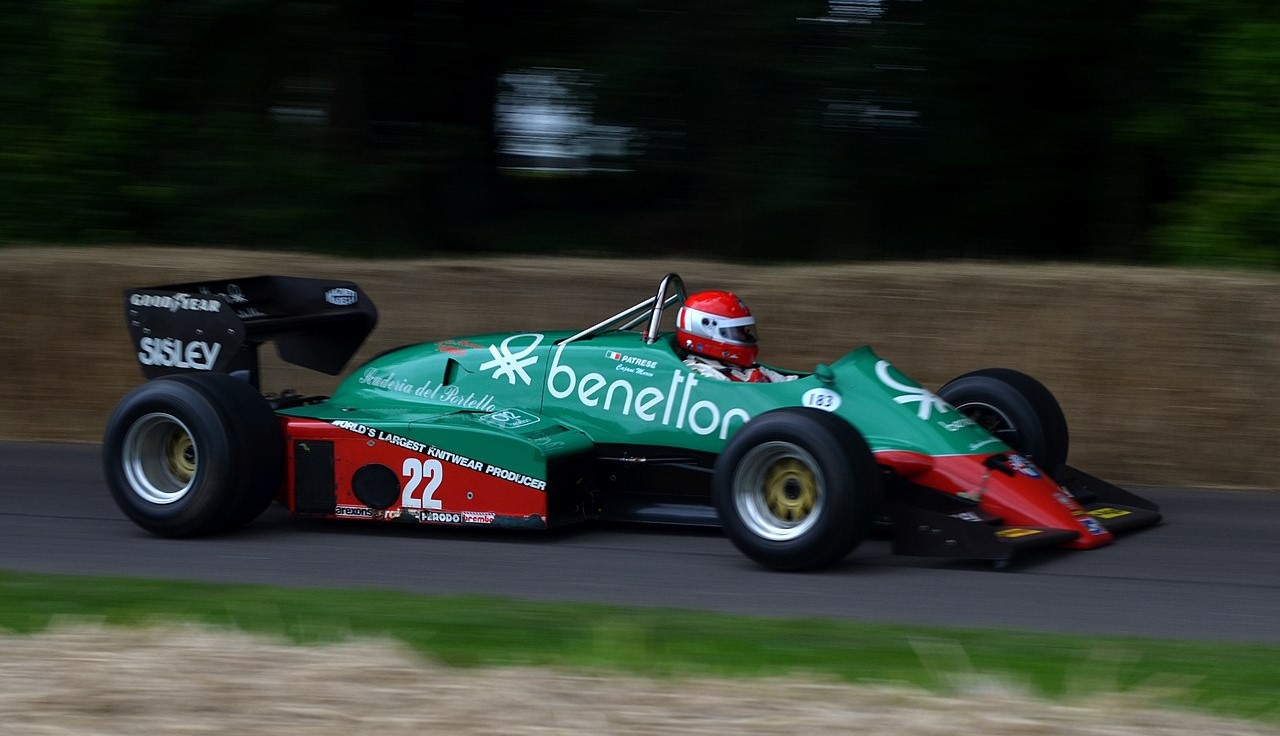 Alfa Romeo 183T (Photo by Nic Redhead)
Alfa Romeo 183T (Photo by Nic Redhead)
Alfa Romeo continued to be an engine supplier in F1, supplying engines to the small but unsuccessful Italian Osella team from 1983 to 1988. Alfa also provided some technical assistance to Osella with their 1984 car being based on the works 1983 Alfa 183T but by 1988, stung by the negative publicity of the non-performing Osella team, Alfa terminated their relationship and thus ending their involvement in Formula One.
Minichamps: Alfa Romeo Sauber
In 2018 Alfa Romeo returned to Formula One as the title sponsor of the Sauber F1 team and for 2019, the team is now the Alfa Romeo Racing Team and their immediate goal is to be regular mid-field contenders with Kimi Raikkonen and Antonio Giovinazzi. Can't wait until March 17th.
[Back to Top]
New Additions: February 2019
Welcome to another monthly update. We are already into the 2nd month of the year, can you believe it? Finally, the long-awaited Toyota TS050 that won last year's Le Mans 24 hour race has been released by Spark and by all accounts, will be a popular addition to many Le Mans collection. This month's "new additions" contains many older releases but a few new ones as well. Here are my hightlights.
Stefan Bellof's racing career was tragically cut short on September 1st, 1985 at the Spa-Francorchamps circuit. He was taking part in the 1000km World Sportscar race in a Porsche 956 when on lap 78 his car touched another and he was sent into a barrier head-on. He died at the track hospital, aged 27. Bellof, regarded as a likely future World Champion was a driver for the Tyrrell F1 team at the time of his death and never had the opportunity to show his talent behind the wheel of an F1 car. His early racing career included contesting the German F3 championship in 1981 where he lead the championship going into the final round but luck eluded Bellof who finished 13th in the race and 3rd in the championship. Minichamps have released the model of his Ralt Toyota which is a limited edition of 333.
Minichamps: Ralt Toyota F3 Stefan Bellof 1981
Lee Iacocca, the Ford vice-president of the car and truck group quickly realised the promotional benefit the new Mustang would receive if there was a Shelby variant beating Corvettes on the race track. Carroll Shelby was an accomplished racing driver who won at Le Mans in 1959 and after retiring from racing due to health reasons, formed the Shelby American company in 1962 to build and market high performance cars. Shelby had obtained support from Ford in 1962 to develop the British AC Cobra using a Ford V8 and later was tasked with developing the legendary GT40 so Shelby was the logical choice to develop the Mustang. The Shelby Mustang started life as a stock Ford Mustang Fastback and then modfied with high performance parts by Shelby American from 1965 to 1968 (and from 1969 to 1970 by Ford). All the 1965-66 cars had the Windsor 289 cu.in. (4.7L) 271 HP (202Kw) V8 engine but modified to produce 306 HP (310 Kw). In 1966, the GT350 lost its Mustang tag and was marketed simply as the Shelby GT350. Due to SCCA (Sports Car Club of America) rules the car was only allowed two seats in the sports car class, so the rear seats were replaced with a spare tire so it could race with great success in SCCA sanctioned events.
Red Bull is a marketing success story. Its famous red on black logo can be seen at race tracks and in the air all around the world. And when the racing is finished for the day, fans still get to be blasted by music from the Red Bull party van. Bizarre has just released a model of Red Bull's latest party machine which is thought to be a massively transformed long-wheelbase Defender 130.
Bizarre: Red Bull One - Event Car
Well it's a wrap for another month. Just the one model fair in February; the regular Friday night fair at Granville on 8th February. I hope to see you there, until next month, happy collecting.
Formula 1
- 1965 BRM P57, M.Gregory (24) German GP (Spark)
- 1966 BRM P261, B.Bondurant (24) Belgium GP (Spark)
- 1966 BRM P261, B.Bondurant (19) 4th Monaco GP (Spark)
- 1967 BRM P261, P.Courage (6) Monaco GP (Spark)
- 1967 BRM P261, J.Stewart (4) Monaco GP (Spark)
- 1969 McLaren Ford M7B, V.Elford (18) 10th Dutch GP (Antiques Auto Team) (Spark)
- 1971 McLaren Ford M19A, D.Hulme (9) 6th Monaco GP (Spark)
- 1981 McLaren Ford MP4/1, A.De Cesaris (8) Monaco GP (Spark)
- 2011 McLaren Merc MP4/26, J.Button (4) race car Ed.43 N.117 (Minichamps)
- 1981 Ralt Toyota RT3, S.Bellof (3) German F3 Championship (Minichamps)
Le Mans
- 2010 Audi R15 TDI, Rockenfeller/Dumas/Bernhard (9) LM winner (IXO)
- 2013 Audi R18 e-tron quattro, McNish/Kristensen/Duval (2) winner Le Mans (IXO)
- 1960 Austin Healey 3000, Sears/Riley (23) Le Mans (IXO)
- 2003 Bentley EXP Speed 8, Kristensen/Capello/Smith (7) Le Mans winner (IXO)
- 1962 Lotus Elite, F.Gardner/Hobbs (44) GT1.3 class winner Le Mans (IXO)
- 1991 Nissan Skyline GT-R R32, M.Hasemi (1) 4th Macau Guia Race (IXO)
- 1970 Porsche 917K, Herrmann/Attwood (23) LM winner (IXO)
- 1977 Porsche 936/77, Ickx/Haywood/Barth (4) winner Le Mans (IXO)
- 1982 Porsche 936C, Heyer/Merl/Schornstein (2) 9hr Kyalami (K-Model)
- 1984 Porsche 956L, Pescarolo/Ludwig/Johansson 1st LM (7) Newman (IXO)
- 1993 Porsche 911 (964) RSR 3.8, Barth/Muller/Rohrl (8) 24hr Nurburgring (Spark)
- 2012 Porsche 977 RSR, Ried/Roda/Ruberti (88) Le Mans "Felbermayr" (Spark)
- 1967 Shelby Mustang 350GT, Dubois/Tuerlinckx (17) DNF Le Mans (IXO)
- 2018 Toyota TS050 Hybrid LMP1, Buemi/Nakajima/Alonso (8) 1st Le Mans (Spark)
American Race Series
- 1966 Shelby 350GT, "Ready to Race" car in white (IXO)
- 1966 Shelby 350GT, H.McCarty (70) VSCCA Racing Car (IXO)
Road Cars
- 1998 Audi TT Coupe in metallic blue (Maxichamps)
- 1974 Fiat X1/9 in blue (Maxichamps)
- Falcon XB GT MFP Pursuit, Mad Max Movie car (ACE)
- 1976 Ford Fiesta Mk 2 in light green (Maxichamps)
- Red Bull RBE One event car (Bizarre)
- 1955 Porsche 550 Spyder in silver (Maxichamps)
- 1976 Porsche 934/5 Big Wing in black (Corretto Collezione)
- 1999 Porsche 911 Turbo (996) in metallic blue (Maxichamps)
- 1994 SAAB 900 V6 in metallic silver blue (Triple 9)
After Thoughts: "Amedee the Sorcerer". Amedeo "Amedee" Gordini (1899-1979) was an Italian-born race car driver and later a sports car manufacturer in France. As a young boy he became fascinated with cars and in his early teens, worked as a mechanic for Maserati before emigrating to France where he raced Fiat cars in Grand Prix racing events and at the Le Mans 24 hour race. His results prompted Simca (the French assembler of Fiat) to hire him for its motorsport program and to develop road cars. In 1946 Gordini produced a single-seater Simca-Fiat which proved to be a success even though it was powered by an 1100cc engine. Gordini became known as the "Sorcerer" when he gained a reputation for wringing amazing amounts of power out of small capacity Fiat engines without incurring massive expenditure. Spurred on by this success, Gordini fitted even more powerful engines over the next three years.
1950 Simca-Gordini T15s (Photo: Pahazzard)
Gordini then approached Simca to finance his Grand Prix ambitions and so the Simca-Gordini T15 was produced for the 1950 F1 season, driven by Robert Manzon and Maurice Trintignant. That first season proved to be a disappointment with only a fourth place finish as the Equipe Gordini cars were severely underpowered. Fortunately the T15 went well in Formula 2 races using a non-supercharged engine. Equipe Gordini returned for the 1951 season, again using the T15 chassis but the results were even more disappointing than the previous year with no points scored. Gordini broke ties with Simca that year after disagreement over the level of financial support provided by Simca so in 1952 he founded the independent Gordini company to build sports cars as well as his F1 cars. In 1952 the Championship rules were changed to allow F2 cars to take part and the Gordini T16 enjoyed its most successful year with Jean Behra, Manzon and Trintignant all scoring points. The next year, the development of the T16 stalled while its rivals advanced. In 1954, when engines were enlarged from 2 to 2.5 litres, the story was much the same, with just a few points coming their way. Looking to improve the fortunes of the team, Gordini installed an eight cylinder engine into the new T32 chassis in 1955 but the extra horsepower couldn't overcome the deficiences of the budget-built chassis. Another lean year followed in 1956 and finally Amedee Gordini quit F1 racing in 1957.
That same year, Renault engaged Gordini to develop a succession of performance versions of mass market cars, including the Renault Dauphine, Renault 5 Alpine Turbo, Renault 8, 12 and 17. Amedee Gordini died in 1979, just short of his 80th birthday and sadly, failed to see the first F1 victory of the Renault-Gordini EF-Type V6 turbo engine. His company continues to be a division of Renault Sport.
New Additions: January 2019
Welcome to the first update of 2019 and a happy new year to everyone. I hope everyone had a relaxing break over the festive season and received all the models cars on your wish list. January is usually a quiet time of the year but there are a number of new additions to announce and as always I've picked a few highlights amongst the new arrivals. The Force India F1 team has now been consigned to the Formula One history books after racing for 11 seasons. The team started life as the Jordan Grand Prix team in 1991 before becoming Midland F1 Racing in 2006. Midland F1 in turn was sold to become Spyker F1 in 2007 and the team quickly hit financial problems before being passed onto a consortium led by Indian businessman Vijay Mallya. Thus Force India was born but the team struggled for that elusive GP victory and despite having the Mercedes powerplant only 6 podiums were forthcoming over 11 seasons. The assets of the team were bought by a new consortium led by Lawrence Stroll and in 2019 the team will be known as Racing Point F1.
Minichamps: Force India Mercedes VJM11
The iconic Volkswagen Type1 Transporter was produced from 1950 to 1967 and was characterised by its split windscreen and powered by a 4-cylinder boxer, air cooled 1193 cc engine. The second generation transporter (Type 2: 1967-79) lost its distinctive split windscreen and was slightly larger and heavier than the Type 1. The VW transporter in all its variants was the best selling van in history with over 12 million units sold worldwide. This model by Schuco depicts a van used by a Ferrari dealership in Belgium.
Schuco: Volkswagen T1 Transporter
Simon Templar drove one. Of course I'm referring to the Volvo P1800, a 2+2 front-engined, rear-drive sports car manufactured from 1961 to 1973. The P1800 project started back in 1957 when Volvo wanted a sports car to compete in the US and European market and much of the design work was done by the Italian firm of Carrozzeria Frua. Volvo had planned to have the P1800 built by Karmann (an independent German automobile manufacturer) but at the time, Karmann's most important customer, Volkswagen threatened cancellation of contracts if Karmann built the P1800. So Karmann declined to build the P1800 and Volvo cancelled the entire project; Volvo even denied publicly the project ever existed. It wasn't until an unauthorised press release surfaced with a photo of the car that Volvo finally admitted its existence and proceeded with plans to finally build the car. The company turned to Jensen Motors whose production lines were under-utilised and a contract was signed for 10,000 cars. The Volvo P1800 gained much publicity when a white 1962 P1800 with number plate ST1 was driven by the character Simon Templar (Roger Moore) in the TV series "The Saint" that ran from 1962-69.
OK, that's it for the first update for 2019. The only model fair in January will be the Granville fair on 11th January. Check out the Swap Meets page for the 2019 model fairs and shows; quite a few shows haven't had dates confirmed yet so please check regularly for updates. Until next month, happy collecting.
Formula One / Race Transporters
- 1995 Benetton Renault B195, J.Herbert (2) 1st British GP (Spark)
- 1965 Brabham Climax BT11, D.Hulme (16) 4th French GP (Spark)
- 1956 Bugatti T251, M.Trintignant (28) French GP (Spark)
- 2018 Force India Mercedes VJM11, E.Ocon (31) Bahrain GP (Minichamps)
- 1955 Gordini T16, J.Lucas (24) Italian GP (Spark)
- 1956 Gordini T32, A.Pilette (4) 6th Monaco GP (Spark)
- 1973 March Ford 731, M.Beuttler (15) Monaco GP (Spark)
- 1987 Minardi Motori Moderni M187, A.Campos (23) US GP (Spark)
- 2018 Renault RS18, C.Sainz Jr. (55) Race car (Minichamps)
- 2018 Renault RS18, N.Hulkenberg (27) Race car (Minichamps)
- Opel Blitz 1.75t, Porsche Racing Service Truck (PremiumClassiXX)
- 1976 Shadow Ford DN5B, J.P. Jarier (17) Spanish Grand Prix (Spark)
- 1962 VW T1C Box van "Ferrari - Automobile Francorchamps" (Schuco)
Australian Race Series
- 1985 BMW 635 Csi, Cecotto/Ravaglia (21) Bathurst "Bob Jane T-Marts" (Spark)
- 1993 Ford Falcon EB, D.Johnson/J.Bowe (17) Bathurst (Biante)
- 2016 Audi R8 LMS Ultra, Davison/Vanthoor/Winkelhock (2) Bathurst 12hr (Spark)
- 2018 Audi R8 LMS, Frijns/Leonard/Vanthoor (37) 1st Bathurst 12h (Spark)
- 2016 Porsche 911 GT3, M.Campbell (7) Aust. Carrera Cup Champion (Spark)
American Race Series
- 2014 Chevrolet Corvette DP, Barbosa/Fittipaldi/Bourdais (5) 1st Daytona 24h (Spark)
Le Mans
- 1931 Alfa Romeo 8C, Howe/Burkin (16) Le Mans winner (IXO)
- 1963 Aston Martin DP214, Kimberley/Schlesser (7) Le Mans (Spark)
- 2003 Bentley EXP Speed 8 Dirty Version, Kristensen/Capello/Smith (7) Le Mans winner (IXO)
- 1935 Lagonda Rapide, L.Fontes/J.Hindmarsh (4) Winner Le Mans (IXO)
- 1972 Matra Simca 670, G.Hill/Pescarolo (15) Le Mans winner (IXO)
- 1971 Porsche 917/20, R.Joest/W.Kauhsen (23) "Pink Pig" Le Mans (Spark)
- 2016 Porsche 919 Hybrid, Dumas/Jani/Lieb (2) 1st Le Mans (IXO)
Road Cars
- 1983 Citroen BX 16 TRS in white (Triple 9)
- 2013 Mazda MX-5 in red/black (Triple 9)
- 1978 Renault 4 in red (WhiteBox)
- 2013 Subaru BRZ STI tS in red (Triple 9)
- 1965 Volvo P1800 in dark green (Triple 9)
- 1972 Volvo P1800 ES in beige (Triple 9)
- 1976 Volvo 343 in yellow (Triple 9)
- 1988 Volvo 440 Turbo in red (Triple 9)
After Thoughts: "The Unheralded Drivers Series - Hans Herrmann." As it's the quiet part of the year, I thought I'd kick-start a series that I have had in mind for a while and that is to shine a light on lesser known drivers whose achievements were significant but never received the acclamation they deserved. One such driver is Hans Herrmann who was born in 1928 in Stuttgart and participated in 19 Formula One races but is probably better known as a sports car driver with the works Porsche team.
Hans Herrmann at 2011 Solitude Revival (photo by Lutz H)
A baker by trade, Herrmanns' racing career began when his mother gave him her gold bracelet so that he could buy a second-hand Porsche in 1952. With this car he won several important races and in 1953 he was drafted into the Porsche team for Le Mans driving a 550 Coupe and finished second in the 1.5 litre class. He also raced in the Mille Miglia and in the Panamericana Road Race with Porsche. The 1954 Mille Miglia would be one he'd never forget; rounding a blind right-hand corner at 160kph he saw the railway barrier had closed and the fast train to Rome quickly approaching the crossing. Too late to brake, Herrman slapped the helmet of his co-driver and they both ducked their heads just in time as their Porsche Spyder scraped under the barrier at full speed. In 1958, Hans Herrmann was the works driver for Borgward competing in the 1958 European Hillclimb Championship and from 1962 to 1965 he was contracted to Abarth when the small Italian car was hard to beat in the 850-1600cc class.
PremiunClassiXX: Borgward 1500 RS
Meanwhile, Mercedes-Benz manager Alfred Neubauer was closely watching Hans Herrmann's early racing career as Mercedes were planning a return to F1 with a 3-car team in 1954. Juan Manuel Fangio and Karl Kling were already contracted drivers and Herrmann successfully tested for the third W196. In his two seasons with Mercedes he scored one third and two fourth places. He returned to F1 in 1957 in a Maserati 250F after missing the 1956 season due to a back injury sustained in practice for the '55 Monaco GP. His two seasons driving the Maserati were not productive and it wasn't until 1960 when he joined the Porsche F1 team racing the 718/2 that he scored his final points in F1 with a 6th place.
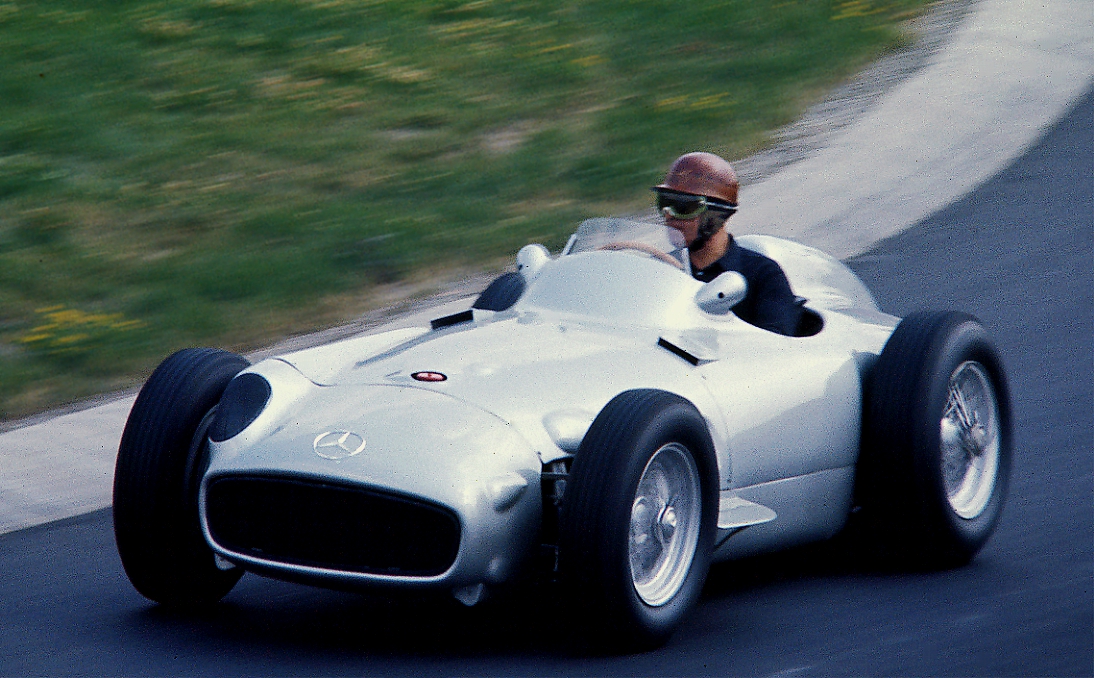 Mercedes-Benz W196 (Photo: Lothar Spurzem)
Mercedes-Benz W196 (Photo: Lothar Spurzem)
In 1966, Herrmann returned to Porsche when the marque was making a serious attempt at the World Sportscar Championship but had to wait until 1968 before he won the 24 Hours of Daytona and the Sebring 12 Hours with the Porsche 907. With the introduction of the Porsche 917, Herrmann was one of the drivers tasked with its development as the car was almost undriveable from the get-go. However, by 1970, the 917 had been developed to the point that it was not only reliable but handled well. That year, Porsche came to an agreement with two teams to run the 917; John Wyer Racing (sponsored by Gulf Oils) and Porsche Salzburg. Herrmann was signed by Porsche Salzburg. The 1970 Le Mans 24 Hour race was the first to be started with the drivers already strapped into their cars and not running across the road. At 4:00pm on the Sunday afternoon the red Herrmann/Attwood Porsche 917 crossed the finish line giving Porsche their first outright win at Le Mans. After promising his wife before the 1970 Le Mans, that he would retire from racing if he won the race, Hans Herrmann's racing career came to a close at the age of 42.
IXO: Porsche 917K Le Mans winner 1970
